
What is Report Writing: Format, Examples, Types & Process
- Table of Contents
Many professionals struggle to create effective reports due to a lack of understanding of the essential elements and organization required. This can lead to frustration and a failure to communicate key information to the intended audience.
In this blog, we’ll explore what is report writing, the types of reports, essential elements, and tips for creating effective reports to help you communicate your message and achieve your goals.

Definition of report writing?
According to Mary Munter and Lynn Hamilton, authors of “Guide to Managerial Communication,” report writing is “the process of selecting, organizing, interpreting, and communicating information to meet a specific objective.”
What is report writing?
Report writing refers to the process of creating a document that represents information in a clear and concise manner. Reports can be written for various purposes, such as providing updates on a project, analyzing data or presenting findings, or making recommendations.
Effective report writing requires careful planning, research, analysis, and organization of information. A well-structured report should be accurate, and objective, and contain a clear introduction, body, and conclusion. It should also be written in a professional and accessible style, with appropriate use of headings, subheadings, tables, graphs, and other visual aids.
Overall, report writing is an important skill for professionals in many fields, as it helps to communicate information and insights in a clear and concise manner.
What is a report?
A report is a formal document that is structured and presented in an organized manner, with the aim of conveying information, analyzing data, and providing recommendations. It is often used to communicate findings and outcomes to a specific audience, such as stakeholders, or managers. Reports can vary in length and format, but they usually contain a clear introduction, body, and conclusion.
Types of report writing
By understanding the different types of report writing, individuals can select the appropriate format and structure to effectively communicate information and achieve their objectives. However, the kind of report used will depend on the purpose, audience, and context of the report.
1/ Informational reports: These reports provide information about a topic, such as a product, service, or process.
Further Reading : What is an information report
2/ Analytical reports: These reports present data or information in a structured and organized manner, often with charts, graphs, or tables, to help the reader understand trends, patterns, or relationships.
3/ Formal Reports: These are detailed and structured reports written for a specific audience, often with a specific objective. In comparison with informal reports , formal reports are typically longer and more complex than other types of reports.
4/ Progress reports: These reports provide updates on a project or initiative, detailing the progress made and any challenges or obstacles encountered.
5/ Technical reports: These reports provide technical information, such as specifications, designs, or performance data, often aimed at a technical audience.
6/ Research reports: These reports present the findings of research conducted on a particular topic or issue, often including a literature review, data analysis, and conclusions.
7/ Feasibility Report: A feasibility report assesses the likelihood of achieving success for a suggested project or initiative.
8/ Business Reports: These reports are used in a business setting to communicate information about a company’s performance, operations, or strategies. Different types of business reports include financial statements, marketing reports, and annual reports.
Structure of report writing
The structure of a report refers to the overall organization and layout of the report, including the sections and subsections that make up the report, their order, and their relationships to each other. A report can we divided into three parts.
Preliminary Parts:
- Acknowledgments (Preface or Foreword)
- List of Tables and Illustrations
- Introduction (clear statement of research objectives, background information, hypotheses, methodology, statistical analysis, scope of study, limitations)
- Statement of findings and recommendations (summarized findings, non-technical language)
- Results (detailed presentation of findings with supporting data in the form of tables and charts, statistical summaries, and reductions of data, presented in a logical sequence)
- Implications of the results (clearly stated implications that flow from the results of the study)
- Summary (brief summary of the research problem, methodology, major findings, and major conclusions)
End Matter:
- Appendices (technical data such as questionnaires, sample information, and mathematical derivations)
- Bibliography of sources consulted.
This structure provides a clear and organized framework for presenting a research report, ensuring that all important information is included and presented in a logical and easy-to-follow manner.
Extra Learnings Role of a report structure in report writing The report structure plays a crucial role in report writing as it provides a clear and organized framework for presenting information in an effective and logical manner. It ensures that the reader can easily understand the purpose and scope of the report, locate and access the relevant information. The preliminary parts of the report, provide an overview of the report and aid navigation. The main text makes it easier for the reader to comprehend and analyze the information. And The end matter provides additional details and sources for reference. An organized report structure also helps the author to communicate their research and ideas effectively to the intended audience.
What is the report writing format?
The format of report writing refers to the structure of a formal document that provides information on a particular topic or issue. The report writing format typically includes the following key components:
8 Essential elements of report writing are:
1/ Title: The title is the first thing that readers will see, and it should be clear and concise. The title should include the report’s subject or topic and the author’s name, date of writing, or who the report is for. Remember to keep the title brief and informative, avoiding vague or ambiguous language.
Example of Business Report Title Page: “Market Analysis and Growth Strategies for XYZ Corporation” Author: Mary Johnson Date: January 2, 2022 Company: Earthcon Corporation Department: Strategy and Planning
In this example, the title page includes the name of the report, ‘Market Analysis 2022,’ the author’s name, ‘John Doe,’ the submission date, ‘January 1, 2024,’ and other details such as the name of the organization, ‘Earthcon Corporation.’
2/ Table of Contents : The table of contents provides an overview of the report’s contents. It should list all sections and subsections with clear headings. It is essential to make the table of contents organized and easy to read, allowing readers to locate specific information quickly.
Example of Table of Contents I. Introduction…… 1 Purpose of the Report…… 2 Methodology Used…… 2 II. Executive Summary…… 3 III. Background and Context…… 3 IV. Analysis and Findings…… 4 Market Trends and Data…… 5 Competitor Analysis…… 6 SWOT Analysis…… 7 V. Recommendations and Conclusion…… 8 VI. References…… 9
3/ Summary : Also known as the executive summary, the summary provides a brief overview of the entire report. It should summarize the report’s main points, including findings, objectives, and recommendations. The summary should be written after the entire report is completed, and it should be concise and summarized in less than one page.
Example of executive summary: The Annual Sales Report for Earthcon Company shows a 10% increase in overall sales compared to the previous year. The report also reveals that the majority of sales came from the Midwest region and the target demographic is primarily males aged 25-40. Based on these findings, recommendations have been made to focus marketing efforts towards this demographic in the upcoming year.
4/ Introduction : The introduction introduces the report’s topic and informs readers what they can expect to find in the report. The introduction should capture readers’ attention and provide relevant background information. It should be clear and concise, including why the report was written and its objectives.
Example of Introduction: This comprehensive report aims to analyze and evaluate the sales performance of EarthCon Corporation throughout 2024. It will look into detailed sales trends observed throughout the year, carefully examining the various factors that have influenced these trends. Additionally, the report will identify and highlight potential areas for growth, offering valuable insights and recommendations to drive future success.
5/ Body: The body is the longest section and includes all the information, data, and analysis. It should present information in an organized manner, often using subheadings and bullet points. The body should include all relevant research findings and data, often accompanied by visuals such as graphs and tables. It is essential to cite all sources correctly and remain objective, avoiding personal opinions or biases.
Example of Background and Context: This report seeks to analyze the influence of technological advancements on business productivity. Previous research has indicated a correlation between the adoption of innovative technologies and increased operational efficiency for Earthcon. The report will examine further into this topic and offer suggestions for maximizing the benefits of these advancements. Example of Analysis and Findings: The market trends and data show a steady increase in demand for innovative products, with a significant rise in sales in the past five years. In comparison, competitor analysis reveals that Earthcon Corporation is well-positioned to take advantage of this trend due to its strong brand reputation and product portfolio. A SWOT analysis also highlights potential areas for improvement and growth.
6/ Conclusion: The conclusion summarizes the findings and conclusions of the report. It should wrap up all the essential information presented in the body and make recommendations based on the report’s findings. The conclusion must be brief and clear, avoiding the introduction of any new information not previously presented in the body.
7/ Recommendations: The recommendation section should provide suggested goals or steps based on the report’s information. It should be realistic and achievable, providing well-crafted solutions. It is often included in the conclusion section.
Example of Recommendations and Conclusion: Based on the analysis, it is recommended that EarthCon Corporation invest in research and development to continue producing innovative products. Additionally, efforts should be made to expand into emerging markets to increase global reach. In conclusion, the Annual Sales Report shows positive outcomes and recommends strategic actions for future growth.
8/ Appendices: The appendices section includes additional technical information or supporting materials, such as research questionnaires or survey data. It should provide supplementary information to the report without disrupting the report’s main content.
It is important to use clear headings and subheadings and to label tables and figures. Also, proofreading and fact-checking are critical before submitting the report. A well-crafted report is concise, informative and free of personal bias or opinions.
What are the features of report writing
There are several key features of effective report writing that can help ensure that the information presented is clear, concise, and useful. Some of these features include:
1/ Clarity: Reports should be written in clear and concise language, avoiding jargon or technical terms that may be confusing to the reader.
2/ Objectivity: A report should be objective, meaning that it should be free from bias or personal opinions. This is particularly important when presenting data or analysis.
3/ Accuracy: Reports should be based on reliable sources and accurate data. Information should be verified and cross-checked to ensure that it is correct and up-to-date.
4/ Structure: A report should be structured in a logical and organized manner, with clear headings, subheadings, and sections.
5/ Visual aids: A report may include visual aids such as charts, tables, and graphs, which can help to illustrate the key points and make the information easier to understand.
6/ Evidence: Reports should include evidence to support any claims or findings, such as statistics, quotes, or references to relevant literature.
7/ Recommendations: Many reports include recommendations or suggestions for future action based on the findings or analysis presented.
Significance of report writing
Report writing is a critical skill that can have a significant impact on individuals, and organizations. In fact, a report by the National Association of Colleges and Employers found that the ability to communicate effectively, including report writing, was the most important skill sought by employers.
- Reports provide decision-makers with the information they need to make informed decisions.
- Effective report writing demonstrates professionalism and attention to detail, which can help to build trust and credibility with clients.
- Reports can inform planning processes by providing data and insights that can be used to develop strategies and allocate resources.
- Reports often include recommendations or suggestions for future action, which can help to improve processes, procedures, or outcomes.
Further Reading: What is the significance of report writing
Report writing examples and samples
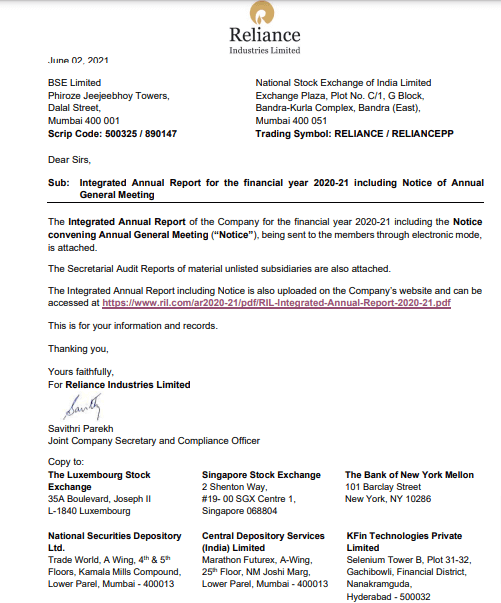
Example of Progress Report
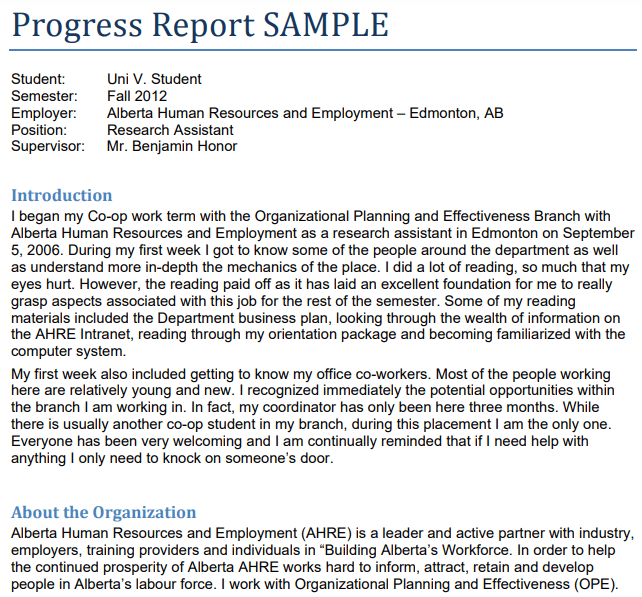
The essential process of report writing
Report writing requires careful planning, organization, and analysis to ensure that the report effectively communicates the intended message to the audience. Here are the general steps involved in the process of report writing:
Plan and prepare:
- Identify the purpose of the report, the target audience, and the scope of the report.
- Collect and examine data from different sources, including research studies, surveys, or interviews.
- Create an outline of the report, including headings and subheadings.
Write the introduction:
- Start with a brief summary of the report and its purpose.
- Provide background information and context for the report.
- Explain the research methodology and approach used.
Write the main body:
- Divide the report into logical sections, each with a clear heading.
- Present the findings and analysis of the research in a clear and organized manner.
- Use appropriate visual aids, such as tables, graphs, or charts to present data and information.
- Utilize a language that is both clear and Brief, and avoid using unnecessary jargon or technical terminology.
- Cite all sources used in the report according to a specified citation style.
Write the conclusion:
- Summarize the main findings and conclusions of the report.
- Restate the purpose of the report and how it was achieved.
- Provide recommendations or suggestions for further action, if applicable.
Edit and revise:
- Review the report for errors in grammar, spelling, and punctuation.
- Check that all information is accurate and up-to-date.
- Revise and improve the report as necessary.
Format and present:
- Use a professional and appropriate format for the report.
- Include a title page, table of contents, and list of references or citations.
- Incorporate headings, subheadings, and bullet points to enhance the report’s readability and facilitate navigation.
- Use appropriate fonts and sizes, and ensure that the report is well-structured and visually appealing.
Important Principles of report writing
To write an effective report, it is important to follow some basic principles. These principles ensure that your report is clear, concise, accurate, and informative. In this regard, here are some of the key principles that you should keep in mind when writing a report:
1/ Clarity: The report should be clear and easy to understand.
2/ Completeness: The report should cover all the relevant information needed to understand the topic
3/ Conciseness: A report should be concise, presenting only the information that is relevant and necessary to the topic.
4/ Formatting: The report should be properly formatted, with consistent fonts, spacing, and margins
5/ Relevance: The information presented in the report should be relevant to the purpose of the report.
6/ Timeliness: The report should be completed and delivered in a timely manner.
7/ Presentation: The report should be visually appealing and well-presented.
Extra Learnings Styles of report writing When it comes to the style of report writing, it’s important to use hard facts and figures, evidence, and justification. Using efficient language is crucial since lengthy reports with too many words are difficult to read. The most effective reports are easy and quick to read since the writer has comprehended the data and formulated practical recommendations. To achieve this, it’s important to write as you speak, avoid empty words, use descending order of importance, use an active voice, and keep sentences short. The goal should be to write to express and not to impress the reader. It’s also important to get facts 100% right and to be unbiased and open. By following these tips, one can create a well-written report that is easy to understand and provides valuable insights.
Differences between a report and other forms of writing
Reports are a specific form of writing that serves a distinct purpose and have unique characteristics. Unlike other forms of writing, such as essays or fiction, reports are typically focused on presenting factual information and making recommendations based on that information. Below we have differentiated report writing with various other forms of writing.
Essay vs report writing
Project writing vs report writing, research methodology vs report writing, article writing vs report writing, content writing vs report writing, business plan vs report writing, latest topics for report writing in 2024.
The possibilities for report topics may depend on the goals and scope of the report. The key is to choose a topic that is relevant and interesting to your audience, and that you can conduct thorough research on in order to provide meaningful insights and recommendations.
- A market analysis for a new product or service.
- An evaluation of employee satisfaction in a company.
- A review of the state of cybersecurity in a particular industry.
- A study of the prevalence and consequences of workplace discrimination.
- Analysis of the environmental impact of a particular industry or company.
- An assessment of the impact of new technology or innovations on a particular industry or sector.
Report writing skills and techniques
Effective report writing requires a combination of skills and techniques to communicate information and recommendations in a clear, and engaging manner.
From organizing information to tailoring the report to the intended audience, there are many factors to consider when writing a report. By mastering these skills and techniques, you can ensure that your report is well-written, informative, and engaging for your audience. Some of the primary ones are:
1/ Organization and structure: Structure your report in a logical and organized manner with headings and subheadings.
2/ Use of data and evidence: Present objective data and evidence to support your findings and recommendations.
3/ Audience awareness: Tailor your report to the needs and interests of your intended audience.
4/ Effective visuals: Use graphs, charts, or other visuals to communicate complex information in a clear and engaging way.
5/ Editing and proofreading: Carefully edit and proofread your report to ensure it is error-free and professional.
6/ Tone: Use a professional and objective tone to communicate your findings and recommendations.
7/ Time management: Manage your time effectively to ensure you have enough time to research, write, and revise your report.
Tips for effective report writing
- Understand your audience before you start writing.
- Start with an outline and cover all the important points.
- Employ clear and concise language.
- Utilize headings and subheadings to organize your report.
- Incorporate evidence and examples to support your points.
- Thoroughly edit and proofread your report before submission.
- Follow formatting guidelines If your report has specific formatting requirements.
- Use visuals to enhance understanding.
What is the ethical consideration involved in report writing
Ethical considerations play a crucial role in report writing. The accuracy of the information presented in the report is of utmost importance, as it forms the basis for any conclusions or recommendations that may be made. In addition, it is essential to avoid plagiarism by giving credit to the original sources of information and ideas.
Another crucial ethical consideration is confidentiality, particularly when the report contains sensitive or confidential information. It is important to safeguard this information and prevent its disclosure to unauthorized individuals.
Avoiding bias in report writing is also crucial, as it is essential to present information in an objective and unbiased manner. In cases where research or data collection is involved, obtaining informed consent from human subjects is a necessary ethical requirement.
By taking these ethical considerations into account, report writers can ensure that their work is fair, accurate, and respectful to all parties involved.
Common mistakes in report writing
There are several common mistakes that students and report writers make in report writing. By avoiding these common mistakes, students as well as report writers can create effective and impactful reports that are clear, accurate, and objective.
1/ Writing in the first person: Often, students and report writers commit an error by writing in the first person and utilizing words such as “I” or “me. In reports, it is recommended to write impersonally, using the passive voice instead.
2/ Using the wrong format: Reports should use numbered headings and subheadings to structure the content, while essays should have a clear line of argument in their content.
3/ Failing to introduce the content: The introduction of the report should introduce the content of the report, not the subject for discussion. It is important to explain the scope of the report and what is to follow, rather than explaining what a certain concept is.
4/ Missing relevant sections: Students and report writers, often miss out on including relevant sections that were specified in the assignment instructions, such as a bibliography or certain types of information. This can result in poor interpretation.
5/ Poor proofreading: Finally, not spending enough time proofreading the reported work can create unwanted mistakes. Therefore, It is important to proofread and correct errors multiple times before submitting the final report to avoid any mistakes that could have been easily corrected.
By avoiding these common mistakes, students and report writers can improve the quality of their reports.
What are some challenges of report writing and how to overcome them
Report writing can be a challenging task for many reasons. Here are some common challenges of report writing and how to overcome them:
1/ Lack of clarity on the purpose of the report: To overcome this challenge, it is important to clearly define the purpose of the report before starting. This can help to focus the content of the report and ensure that it meets the needs of the intended audience.
2/ Difficulty in organizing ideas: Reports often require a significant amount of information to be organized in a logical and coherent manner. To overcome this challenge, it can be helpful to create an outline or flowchart to organize ideas before beginning to write.
3/ Time management: Writing a report can be time-consuming, and it is important to allow sufficient time to complete the task. To overcome this challenge, it can be helpful to create a timeline or schedule for the various stages of the report-writing process.
4/ Writer’s block: Sometimes writers may experience writer’s block, making it difficult to start or continue writing the report. To overcome this challenge, it can be helpful to take a break, engage in other activities or brainstorming sessions to generate new ideas.
5/ Difficulty in citing sources: It is important to properly cite sources used in the report to avoid plagiarism and maintain credibility. To overcome this challenge, it can be helpful to use citation management tools, such as EndNote or Mendeley, to keep track of sources and ensure accurate referencing.
6/ Review and editing: Reviewing and editing a report can be a challenging task, especially when it is one’s own work. To overcome this challenge, it can be helpful to take a break before reviewing the report and seek feedback from others to gain a fresh perspective.
By being aware of these challenges and taking proactive steps to overcome them, report writers can create effective and impactful reports that meet the needs of their intended audience.
Best Software for writing reports
Report writing software has made it easier for writers to produce professional-looking reports with ease. These software tools offer a range of features and functionalities, including data visualization, collaboration, and customization options. In this section, we will explore some of the best report-writing software available:
1/ Tableau : This tool is great for creating interactive and visually appealing reports, as it allows users to easily create charts, graphs, and other data visualizations. It also supports data blending, which means that you can combine data from multiple sources to create more comprehensive reports.
2/ Zoho reporting : This tool is designed to help users create and share professional-looking reports quickly and easily. It offers a variety of customizable templates, as well as a drag-and-drop interface that makes it easy to add data and create charts and graphs.
3/ Bold Reports by Syncfusion : This tool is designed specifically for creating reports in .NET applications. It offers a wide range of features, including interactive dashboards, real-time data connectivity, and customizable themes and templates.
4/ Fast Reports : This tool is a reporting solution for businesses of all sizes. It allows users to create reports quickly and easily using a drag-and-drop interface and offers a variety of templates and customization options. It also supports a wide range of data sources, including databases, spreadsheets, and web services.
Further Reading : 10+ Best Report Writing Software and Tools in 2024
What is the conclusion of report writing
The conclusion of report writing is the final section of the report that summarizes the main findings, conclusions, and recommendations. It should tie together all the different sections of the report and present a clear and concise summary of the key points.
THE UNIVERSITY OF NEWCASTLE has given an inverted introduction framework that can use used for writing effective conclusions for reports.
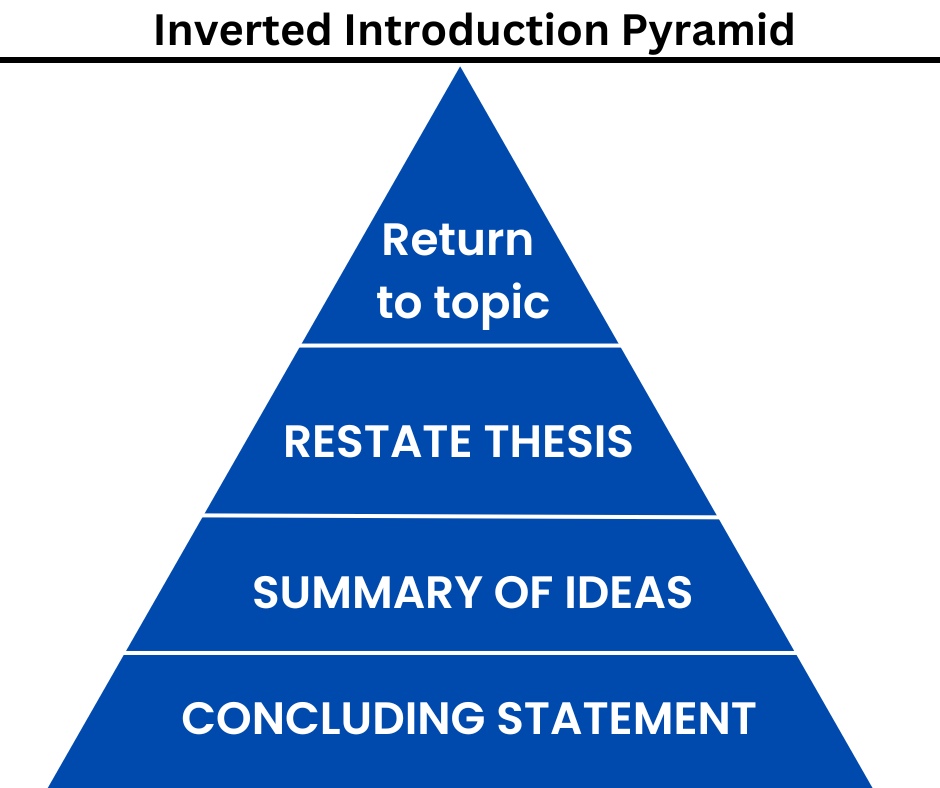
Example of conclusion in report writing:
The implication of the above diagram can be explained with the following example:
1. RETURN TO TOPIC:
Social media has revolutionized the marketing landscape, providing new opportunities for brands to connect with their target audience.
2. RESTATE THESIS:
However, the complexities and limitations of social media mean that it is unlikely to completely replace traditional marketing methods. The role of the marketing professional remains crucial in ensuring that social media strategies align with the company’s overall goals and effectively reach the desired audience.
3. SUMMARY OF IDEAS DISCUSSED:
Automated tools cannot fully account for the nuances of human communication or provide the level of personalization that consumers crave. Therefore, the most effective marketing strategies will likely blend social media tactics with traditional marketing channels.
4. CONCLUDING STATEMENT [restating thesis]:
In conclusion, while social media presents significant opportunities for brands, the expertise of marketing professionals is still essential to creating successful campaigns that achieve desired outcomes.
Frequently Asked Questions
Q1) what is report writing and example.
Ans: Report writing involves preparing a structured document that delivers information to a particular audience in a clear and systematic manner. An example of a report could be a business report analyzing the financial performance of a company and making recommendations for improvement.
Q2) What is report writing and types of reports?
Ans: The act of presenting information in an orderly and structured format is known as report writing. Reports come in different types, such as analytical reports, research reports, financial reports, progress reports, incident reports, feasibility reports, and recommendation reports.
Q3) What are the 5 steps of report writing
The five steps of report writing, are as follows:
- Planning: This involves defining the purpose of the report, determining the audience, and conducting research to gather the necessary information.
- Structuring: This step involves deciding on the structure of the report, such as the sections and subsections, and creating an outline.
- Writing: This is the stage where the actual writing of the report takes place, including drafting and revising the content.
- Reviewing: In this step, the report is reviewed for accuracy, coherence, and effectiveness, and any necessary changes are made.
- Presenting: This final step involves presenting the report in a clear and professional manner, such as through the use of headings, visuals, and a table of contents.
Q4) What is a report in short answer?
Share your read share this content.
- Opens in a new window
Aditya Soni
You might also like.
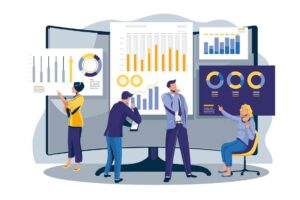
What is a Business Report: How To Write it? (Examples & Format)
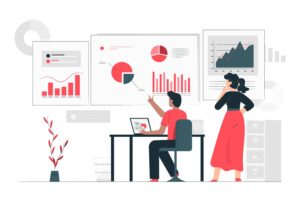
Business Communication Report Writing| What is it & How to Draft One
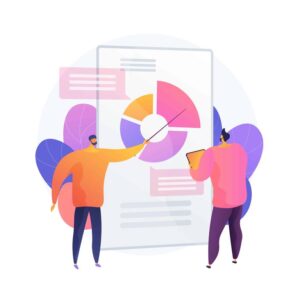
24 Types of Business Reports With Samples & Writing Structure
Leave a reply cancel reply.
Save my name, email, and website in this browser for the next time I comment.

- Onsite training
3,000,000+ delegates
15,000+ clients
1,000+ locations
- KnowledgePass
- Log a ticket
01344203999 Available 24/7
What is Report Writing? A Beginner's Guide
Explore the art of effective communication in our blog, "What is Report Writing? A Beginner's Guide." Discover the fundamental skills needed for Report Writing and how it plays a crucial role in various aspects of life, from academics to the professional world. Get started on your journey to becoming a proficient Report Writer.

Exclusive 40% OFF
Training Outcomes Within Your Budget!
We ensure quality, budget-alignment, and timely delivery by our expert instructors.
Share this Resource
- Creative Writing Course
- E-mail Etiquette Training
- Touch Typing Course
- Data Entry Masterclass
- Office Skills Training

Well, you're in the right place. In this blog, we will explain What is Report Writing and take you through the world of Report Writing step by step. We'll explore different Report types, learn about the Report Writing format, discover helpful tips, and even distinguish it from other types of writing.
Table of Contents
1) Understanding What is Report Writing?
2) Types of Reports
3) What is the Report Writing format?
4) Tips for effective Report Writing
5) Difference between Project Writing and Report Writing
6) Conclusion
Understanding What is Report Writing?
Report Writing is the process of presenting information in a structured and organised way. It serves as a means of communicating facts, findings, or recommendations to a specific audience, typically in a written format. This type of writing is used in various fields, including academics, business, science, and government, to convey important details and insights.
A Report typically starts with a clear purpose or objective. The Writer gathers relevant information through research, observation, or data collection. This data is then analysed and organised into a coherent document. Reports can vary in length, complexity, and style, depending on the intended audience and purpose.
One of the key aspects of Report Writing is its structure. A typical Report consists of sections such as an introduction, methodology, findings or results, discussion, and a conclusion. These sections help readers understand the context, the process of gathering information, the outcomes, and the significance of the findings.
Reports often include visual aids like charts, graphs, and tables to make complex data more accessible. Additionally, citing sources is essential to provide credibility and allow readers to verify the information.

Types of Reports
Different Types of Reports serve various purposes, and understanding their distinctions is crucial for effective communication in academic, professional, and organisational settings. Here, we'll explore four common types of Reports:
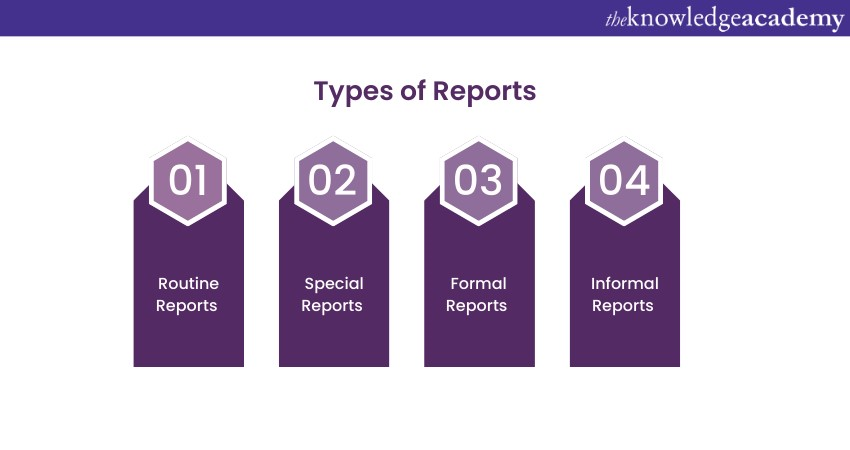
Routine Reports
Routine Reports are regular updates on ongoing activities, often within an organisation. These Reports provide concise information about daily or periodic operations, helping stakeholders stay informed and make informed decisions.
They focus on facts and figures, avoid unnecessary details, and typically follow a standardised format. Examples include daily Sales Reports, Attendance Reports, And Inventory Status Reports. Routine Reports are essential for tracking performance and ensuring smooth operations.
Special Reports
Special Reports are more in-depth and are created for specific purposes, such as investigating a particular issue or analysing a unique situation. These Reports require extensive research and a comprehensive presentation of findings. They are often used to address complex problems or make critical decisions.
For instance, a company might commission a Special Report to evaluate the impact of a new product launch, or a government agency might prepare a Special Report on the environmental impact of a policy change. Special Reports provide a thorough examination of a specific topic and often include detailed recommendations.
Formal Reports
Formal Reports are comprehensive and meticulously structured documents characterised by a standardised format. They usually include a title page, table of contents, executive summary, methodology, findings, discussion, recommendations, and conclusion. Formal Reports are common in academic and corporate environments, as well as in government and research institutions.
They are used to present detailed information and analyses, often for decision-making or academic purposes. A thesis, a business proposal, or an annual Financial Report are examples of Formal Reports. These Reports require a high degree of professionalism and follow strict formatting and citation guidelines.
Informal Reports
Informal Reports are less structured and often used for internal communication within an organisation. They are generally shorter and more straightforward than Formal Reports, emphasising brevity and efficiency. Memos, email updates, and short Progress Reports are common examples of informal Reports.
They serve to share information quickly, often within a department or among team members. Informal Reports are valuable for everyday communication, problem-solving, and decision-making within an organisation, and they do not require the extensive structure and formality of Formal Reports.
Master the art of professional Email communication with our Email Etiquette Training – Boost your online presence and productivity now!
What is the Report Writing format?
Report Writing Format is a way of organising and presenting information in a concise and clear manner. It usually follows a standard structure that can be adapted to different purposes and audiences. A typical Report Writing format consists of the following elements:
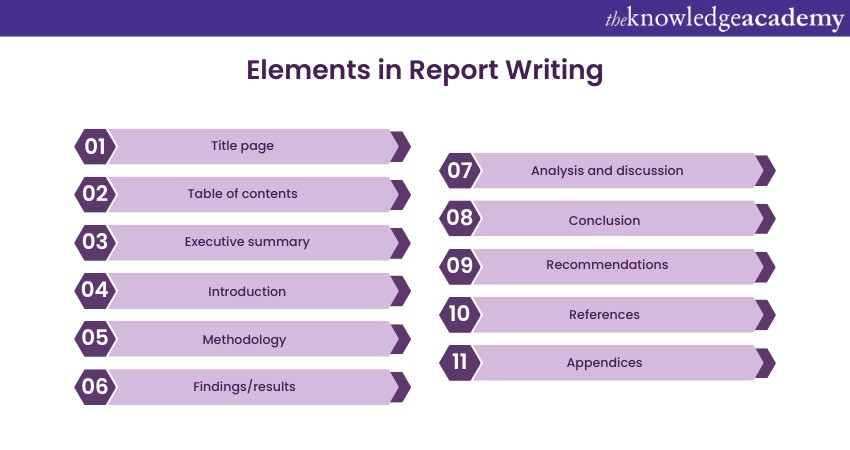
a) Title page : This is the first page of the Report that contains the title, the author’s name, the date, and any other relevant information.
b) Table of contents : This is an optional page that lists the sections and subsections of the Report with their corresponding page numbers.
c) Executive summary (or abstract) : This serves as a concise summary outlining the key points and discoveries within the Report. It should be written in a clear and concise manner and highlight the purpose, scope, methodology, results, analysis, conclusion, and recommendations of the Report.
d) Introduction : This is the first section of the Report that introduces the topic, background, objectives, and scope of the Report. It should also provide a clear statement of the problem or research question that the Report aims to address.
e) Methodology : This is the section that describes how the data or information was collected and analysed. It should explain the methods, tools, techniques, sources, and criteria used in the research or investigation. It should also mention any limitations or challenges encountered in the process.
f) Findings/results : This is the section that presents the data or information obtained from the research or investigation. It should be organised in a logical and coherent manner, using headings, subheadings, tables, graphs, charts, and other visual aids to illustrate the key points and trends.
g) Analysis and discussion : This is the section that interprets and evaluates the findings or results of the Report. It should explain what the data or information means, how it relates to the problem or research question, and what implications or conclusions can be drawn from it. It should also compare and contrast the findings or results with other relevant sources or literature.
h) Conclusion : This is the final section of the Report that summarises the main points and findings of the Report. It should restate the purpose, objectives, and scope of the Report and provide a clear answer to the problem or research question. It should also highlight the main implications or contributions of the Report to the field or topic of interest.
i) Recommendations : This is an optional section that provides suggestions or actions based on the findings or conclusions of the Report. It should be realistic, feasible, and specific and address any issues or gaps identified in the Report.
j) References : This is a list of sources that were cited or consulted in the Report. It should follow a consistent citation style, such as APA, MLA, Harvard, etc.
k) Appendices : These are additional materials that support or supplement the main content of the Report. They may include data tables, calculations, questionnaires, interview transcripts, etc.
Unleash your creativity and become a master storyteller with our Creative Writing Training - Start your writing journey now!
Tips for effective Report Writing
Here are some tips for effective Report Writing:
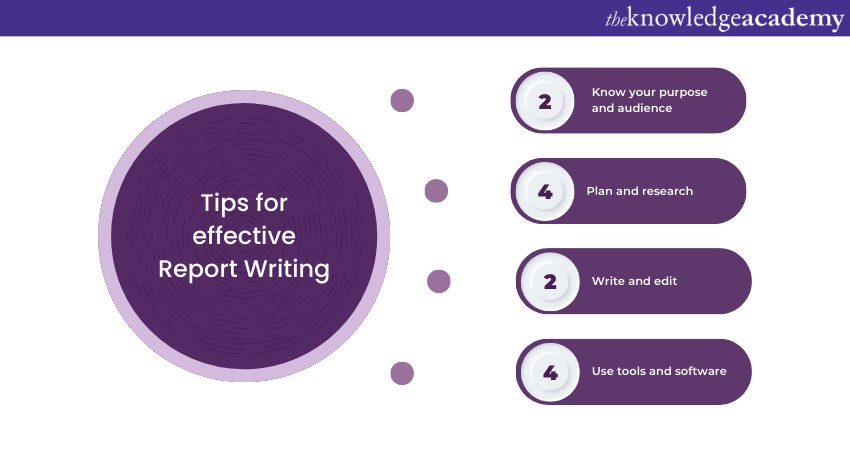
a) Know your purpose and audience : Before you start writing, you should have a clear idea of why you are writing the Report and who will read it. This will help you decide what information to include, what tone and style to use, and how to structure and format your Report.
b) Plan and research : You should plan your Report by outlining the main sections and sub-sections and identifying the key points and arguments you want to make. You should also research your topic thoroughly, using reliable and relevant sources and taking notes of the data and evidence you will use to support your claims.
c) Write and edit : You should write your Report in a concise and clear manner, using simple and precise language and avoiding jargon and slang. You should also follow the Report Writing format that suits your purpose and audience and use headings, subheadings, bullet points, tables, graphs, charts, and other visual aids to organise and present your information. You should also edit your Report carefully, checking for spelling, grammar, punctuation, and formatting errors and ensuring that your Report is coherent and consistent.
d) Use tools and software : You can use various tools and software to help you with your Report Writing process. For example, you can use Bing to search for information on your topic or to find examples of Reports written in different formats. You can write and edit your Report, using features such as grammar check, spell check, word count, citation manager, etc, in Google Docs or Microsoft Word. You can also use PowerPoint or Prezi to create and present your Report visually.
a) Purpose : Project Writing is usually done to demonstrate the student’s ability to apply their skills and knowledge to a specific problem or topic. Report Writing is usually done to present the results and findings of a research or investigation on a specific problem or topic.
b) Format : Project Writing does not have a fixed format, but it may follow the structure of an essay, with an introduction, body, and conclusion. Report Writing has a fixed format, with a title page, table of contents, summary, introduction, methodology, findings/results, analysis/discussion, conclusion, recommendations, references, and appendices.
c) Features : Project Writing is more creative and flexible than Report Writing. It may include personal opinions, reflections, or recommendations. Report Writing is more formal and objective than project writing. It should be based on reliable sources and data and avoid personal opinions or bias.
d) Examples : Some examples of Project Writing are a business plan, a marketing campaign, a software development, a case study analysis, etc. Some examples of Report Writing are a Lab Report, a Market Research Report, a Scientific Report, a Feasibility Report, etc.
Project Writing and Report Writing are different types of academic writing that require different skills and approaches. You should always check the requirements and expectations of your course and module handbooks, instructions from your lecturer, and your subject conventions before you start writing.
Unlock the power of effective communication with our Report Writing Training - Start crafting impactful Reports today!
Conclusion
Report Writing is a crucial skill that can open doors to various opportunities in your academic and professional life. By understanding What is Report Writing, the types of Reports, Report Writing formats, and following effective tips, you can become a proficient Report Writer. Moreover, recognising the differences between project writing, article writing, and Report Writing will help you choose the right approach for your communication needs. Finally, with the help of modern Report writing software, you can streamline the process and create impressive Reports that convey your message effectively.
Transform your potential into excellence - Join our Personal Development Training and embark on a journey of self-improvement!
Frequently Asked Questions
Upcoming business skills resources batches & dates.
Fri 5th Apr 2024
Fri 7th Jun 2024
Fri 16th Aug 2024
Fri 4th Oct 2024
Fri 6th Dec 2024
Get A Quote
WHO WILL BE FUNDING THE COURSE?
My employer
By submitting your details you agree to be contacted in order to respond to your enquiry
- Business Analysis
- Lean Six Sigma Certification
Share this course
Our biggest spring sale.

We cannot process your enquiry without contacting you, please tick to confirm your consent to us for contacting you about your enquiry.
By submitting your details you agree to be contacted in order to respond to your enquiry.
We may not have the course you’re looking for. If you enquire or give us a call on 01344203999 and speak to our training experts, we may still be able to help with your training requirements.
Or select from our popular topics
- ITIL® Certification
- Scrum Certification
- Change Management Certification
- Business Analysis Courses
- Microsoft Azure Certification
- Microsoft Excel & Certification Course
- Microsoft Project
- Explore more courses
Press esc to close
Fill out your contact details below and our training experts will be in touch.
Fill out your contact details below
Thank you for your enquiry!
One of our training experts will be in touch shortly to go over your training requirements.
Back to Course Information
Fill out your contact details below so we can get in touch with you regarding your training requirements.
* WHO WILL BE FUNDING THE COURSE?
Preferred Contact Method
No preference
Back to course information
Fill out your training details below
Fill out your training details below so we have a better idea of what your training requirements are.
HOW MANY DELEGATES NEED TRAINING?
HOW DO YOU WANT THE COURSE DELIVERED?
Online Instructor-led
Online Self-paced
WHEN WOULD YOU LIKE TO TAKE THIS COURSE?
Next 2 - 4 months
WHAT IS YOUR REASON FOR ENQUIRING?
Looking for some information
Looking for a discount
I want to book but have questions
One of our training experts will be in touch shortly to go overy your training requirements.
Your privacy & cookies!
Like many websites we use cookies. We care about your data and experience, so to give you the best possible experience using our site, we store a very limited amount of your data. Continuing to use this site or clicking “Accept & close” means that you agree to our use of cookies. Learn more about our privacy policy and cookie policy cookie policy .
We use cookies that are essential for our site to work. Please visit our cookie policy for more information. To accept all cookies click 'Accept & close'.

What is Report Writing? Parts, Types, Structure, Process
- Post last modified: 4 June 2023
- Reading time: 30 mins read
- Post category: Business Communication

- What is Report Writing?
Report writing is a formal style of presenting objective facts and information. There can be various types of reports, such as academic reports, science reports, business reports, technical reports, and news reports. A report can be verbal or written. However, a written report is more formal than a verbal report.
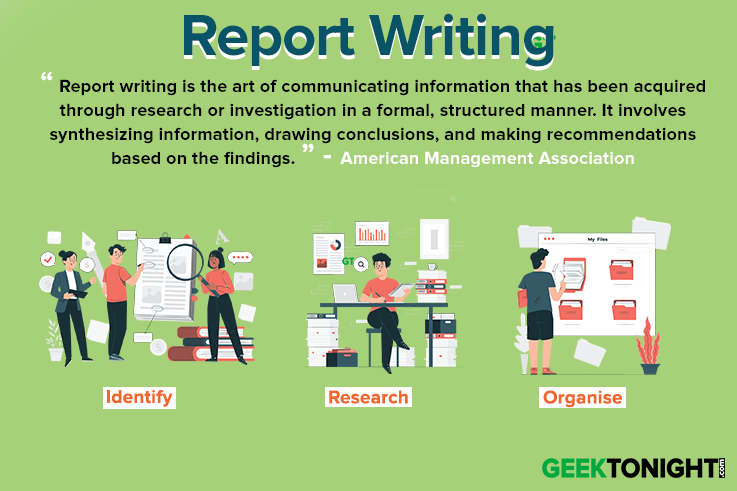
Table of Content
- 1 What is Report Writing?
- 2 Report Writing Definition
- 3 Report Writing Advantage
- 4.1 Introduction
- 4.2 Background
- 4.3 Findings
- 4.4 Conclusions
- 4.5 Recommendations
- 5.1 Informational reports
- 5.2 Analytical reports
- 5.3 News reports
- 6.2 Remaining details
- 6.3 Informational news report
- 6.4 Analytical news report
- 6.5 Additional details
- 6.6 Concluding sentence
- 7.1 Identify
- 7.2 Research
- 7.3 Organise
- 8 Feasibility Reports
- 9.1 Cover letter
- 9.2 Executive summary
- 9.3 Proposal
- 9.4 Pricing information
- 9.5 Terms and conditions
Report Writing Definition
Report writing is the process of organizing and presenting information in a clear, concise, and objective manner for a specific audience. It involves gathering data, analyzing it, and presenting it in a format that is easy to understand and relevant to the topic at hand. – The University of Wisconsin Writing Center
Report writing is the art of communicating information that has been acquired through research or investigation in a formal, structured manner. It involves synthesizing information, drawing conclusions, and making recommendations based on the findings. – The American Management Association
Report writing is the process of creating a document that provides information, analysis, and recommendations on a particular topic or issue. It requires the ability to organize and present data in a logical and meaningful way, as well as to convey complex ideas in a clear and concise manner. – The International Business Communication Standards (IBCS)
Report Writing Advantage
A written report also provides the following advantages:
- A written report presents a formal record of a transaction, which is not possible in a verbal report.
- A written report conveys a message without any distortion. On the other hand, a message can be easily misrepresented in a verbal report.
- A written report is more convenient for lengthy and distant communication.
- A written report requires a reader to think before responding to a message.
- Facts, figures and statistical data can be better represented graphically in a written report.
However, writing a report is not as easy as drafting a formal e-mail. A report is a brief, precise document. It is written for a specific audience with some specific objective. To write a report, you need to first thoroughly understand the purpose of report writing, then research information from various sources, verify the validity of information, analyse information, and then present findings or results. These findings must be reported objectively without personal biases.
A well-written report must have an effective objective analysis. Based on the analysis, you can recommend possible courses of action for the future. However, it is up to the report reader to accept the recommendations.
Therefore, while report writing, you must pay attention to why you are writing the report and who has asked you to write the report. This will help you investigate the information appropriately.
Parts of a Report
Following are the main sections of a formal report :
Introduction
Conclusions, recommendations.
This section indicates the purpose of the report, who has ordered the report, how the data is collected, and whether any recommendations are provided. In addition, the introduction section may also provide information on who has written the report and the date on which it is submitted.
This section provides the background of a problem or a situation on which the report is written. In case the report is too lengthy, then instead of introduction, an executive summary should be written.
The purpose of an executive summary is to enable top executives and managers to get a quick snapshot of a long report without reading the entire report. Therefore, the executive summary comes before introduction. Of course, then there would be no background section.
This is the longest section of a report, which is written after the investigation is over. This section presents factual information without any interpretation or suggestions.
Each finding is summarised as a conclusion in this section. In the above sample report, there are four conclusions based on the summary of each paragraph in the findings section. These conclusions are listed numerically in the same order as the corresponding findings.
The final section provides a numbered list of recommendations, which are based on the list of the conclusion. Each recommendation uses the verb should. This is because the writer is simply giving suggestions and not making a decision. Therefore, the verb should is used instead of the verb will. However, there are exceptions:
- To give a strong recommendation: Use the verb must. For example, ‘The team managers must ensure that the break hours are not shortened.’
- To give a weak recommendation: Use the verb could. For example, ‘Having a coffee dispenser in the facility could boost the staff morale.’
Types of Reports
Reports exist in our academics and workplaces in so many forms that we may not even be aware of them. For example, a student submits a laboratory report to communicate the methods and results of scientific experiments conducted in a lab.
Academicians and business people use research reports to view scientific studies of an issue or a problem. Policy-makers read field study reports to read about the ground situation from branch offices and manufacturing plants. Similarly, there are progress reports, technical reports, functional reports, case studies, etc.
All these reports share the attributes, principles, and format of report writing, which are described above. These reports can be organised into three groups:
Informational reports
Analytical reports, news reports.
An informational report is used to objectively present information without any analysis. Examples of informational reports include the First Information Report (FIR), annual reports, monthly financial reports, or employee attrition reports. These reports only report the facts as they are.
For example, the police write an FIR to record details about a cognisable offence, such as personal details of the complainant/informant, place, date and time of occurrence, offence, description of the accused, witnesses, and complaint.
Similarly, a company presents an annual report to its shareholders to present details of its business activities and finances of the previous financial year. An informational report presents objective facts without analysing the reasons and conditions behind the reported situation.
For example, if someone wants to study information on a field trip, then he can ask for a site visit report. Similarly, if a manager wants to view the feedback of a training programme, then he can ask for the training feedback report from the trainer. If the head of a department wants to get an update on the different projects in his department, he can ask for progress reports from different project managers.
An analytical report evaluates a problem or an issue and presents the outcomes of analysis to explain the causes of the problem, demonstrate relationships, or make recommendations.
For example, a scientific or market research report studies a problem scientifically by developing a hypothesis, gathering data, analysing data, and presenting findings and conclusions.
Similarly, a feasibility analysis report studies a problem and predicts whether the current solution or alternatives will be practical or will produce the desired outcome. Whenever you need to make a critical decision, then an analytical report is prepared. These reports help the decision-maker(s) analyse the prevailing situation.
For example, a company wants to decide where to open a branch office in a particular area. In this situation, an analytical report can evaluate the details of the property, such as infrastructure, land cost, competitive stores, etc., and then recommend the best site from the available options.
If you are working as or aspire to be a journalist, then you may need to write a press report. A press report is a newsworthy article in a newspaper, magazine or website. It is different from the press release by companies. A press release is an official statement of a company on an important subject or event. A press release generally focuses on one particular subject, such as a milestone, a launch, an anniversary, etc.
On the other hand, a press report discusses the subject in detail. A press release is a marketing tool used by companies to keep the general public and the media updated about its newsworthy occasions. It helps build a company’s visibility in the minds of its customers and community at large.
A press release is generally prepared by a company’s marketing or Public Relations (PR) team, whereas a press report is written by an independent journalist. Therefore, a press report presents more objective information than a press release, which is a company’s promotional mouthpiece. Just like informational and analytical reports, a press report requires considerable research on a subject before it is written credibly.
The author must ask the 5 Ws and 1 H – who, what, where, why, when, and how. Questions arise in the following manner:
- What happened?
- Where did it happen?
- When did it happen?
- Who was involved?
- Why did it happen?
- How did it happen?
After finding the answers, he must note down all the relevant facts that must be mentioned in the news report. These facts can be organised into the following three groups:
- Vital and interesting facts
- Not vital but interesting facts
- Not vital, not interesting, but related facts
By organising information into the above groups, the author will be able to include all the relevant facts into the news report. The facts must be specific. If there are gaps in the story and the related information is not available, then questions can be marked against them so that these can be researched further.
Next, the author must decide the type of news report he wants to write – informational or analytical. The former will provide objective and straightforward information, whereas the latter will also provide the author’s opinion on the subject.
After determining the type of news report to write, the author must create an outline or structure of the report. The most common structure is an inverted triangle, where the most important information is at the top.
A news report must provide the information that the readers want as soon as possible. If the news report is for a newspaper, then the most important news must be above the “fold”. The “fold” is the crease in the newspaper when it is folded in half. All the engaging stories are above the fold. Similarly, on a website, the most important information is at the top of the screen before one has to scroll down.
A news report must be written according to the audience. The author should ask the 5Ws with respect to the audience reaction, such as:
- Who is the audience?
- Where is the audience?
- What does the audience want to read?
- Why do they want to read it?
- When will they read it?
Structure of News Report
Finally, the structure of a news report is as follows:
Remaining details
Informational news report, analytical news report, additional details, concluding sentence.
The leading sentence of a news report is the most important section. It should tell what the news report is all about, why it is important, and what information the rest of the news report provides.
These provide the basic information of what happened, where it happened, when it happened, who was involved, and why it was remarkable.
In this report, the remaining details provide more information about the newsworthy item.
In this report, the remaining details also provide the opinion of the author.
These details help the reader learn more about the newsworthy item, such as additional facts about the subject, contact information, or interview quotes. These details comprise transitional elements that help build the flow of information. In an analytical report, these can also include counter-arguments and their authors.
The news report should end with a concluding sentence, which repeats the leading statement or a statement mentioning future developments.
Report Writing Process
This process will ensure that your report is accurate, clear, comprehensive and credible.
Before writing a report, identify the following parameters:
- Issue or problem : Identify the issue or problem to analyse.
- Audience : Identify who the audience is. Find out their background information. Determine why they would want to read the report.
- Purpose : Determine the purpose for which the report will be used.
- Scope and limitations : Identify the scope of the report. Determine the limitations of report writing.
- Expectations : Determine expectations regarding the format or structure of the report. Identify the models available for report writing. Determine whether there is a style guide and/or a marketing guide.
To research the facts or information for report writing:
- Plan : Make a draft plan on how to analyse the problem and present the objective of the report.
- Collect data: Collect information based on the purpose of the report.
- Analyse : Finally, analyse and evaluate the collected information.
After gathering and analysing the required information, organise it as follows:
- Main points : Identify the main points of the report. These main points should be supported by adequate evidence.
- Additional information : Identify the supporting information that analyses and confirms the main points. This information should be placed in appendices.
- Logical structure : Organise the entire information into a logical structure to help the readers easily navigate to the desired part of the report.
- Write : After deciding the logical structure of the report, fill in the elements of the report, including executive summary, main body, introduction and conclusion.
- Revise : Finally, verify if it is appropriate for the problem, audience, and purpose.
Feasibility Reports
A feasibility report is a written document that analyses the proposed solution and examines whether it is feasible considering various types of constraints such as financial, social, environmental, social, technical, and legal that can make it impossible for a solution to be opted.
Feasibility reports assess the practicality of following a particular course of action for a project. It advises whether it will be feasible to opt for a particular course of action or will this proposal or plan work? These are written internal reports that advise on consolidating departments or to organise a wellness programme for employees or to outsource company’s accounting or social media or to move the manufacturing unit to a new location.
Some companies hire a professional consultant to write feasibility reports in order to investigate a problem. These reports help in deciding whether to proceed or reject the proposed option.
- Overview of the Project
- Objectives of the Project
- The Need for the Project
- Overview of Existing Systems and Technologies
- Scope of the Project
- Deliverables
- Financial Feasibility
- Technical Feasibility
- Resource and Time Feasibility
- Risk Feasibility
- Social/Legal Feasibility
- Considerations
Proposal Writing
A business proposal is defined as a written document from a seller that offers a particular service or product to a prospective buyer. Business proposals are important in scenarios where a buyer might consider multiple prices in a transaction.
A good business proposal considers the buyer’s requirements and puts forth the seller’s proposal in a way that favours the seller’s products and services, and persuades the buyer about the offer. A business proposal is a critical document as it determines the difference between success and failure in a venture. Business proposals can be:
- Solicited : These are requested by clients themselves or submitted in response to an advertisement published by the client. Solicited business proposals generally have a better chance of success since they are tailored to the requirements of the person receiving the proposal.
- Unsolicited : These are submitted to potential clients even though they did not request for one. These are non-specific proposals and have no direct connection to the client’s requirements. Sellers use them to market a product or service to a prospective customer.
Because proposals are time-consuming, it is the best to start with available templates if possible. You will save a lot of time if you start with a proposal template that matches what you need and then customise it according to your requirements.
A business proposal includes various sections which are defined as follows:
Cover letter
Executive summary, pricing information, terms and conditions.
In the other article, you studied writing cover letters for a job application. A business proposal also needs a cover letter because a good cover letter will stimulate interest in the proposal. Make sure to highlight your positives and personalise them to the client to whom you are sending the business proposal.
This is where you give the client a ‘problem statement’ to help him identify the challenges and requirements in his business. This is because in order to persuade the client to do business with you, you first need to make sure that the client realises they have those needs. Then you briefly state how you will be able to help them meet those requirements.
The proposal is the part where you offer a detailed solution to the challenges and needs of the prospective client. This is the main reason for submitting a business proposal so it should be as detailed as possible, addressing all the needs of the client.
You should explain to the client all services that you can provide. You should tailor your list of services to suit the particular client’s needs but include other services that you may provide. Also include an estimated project schedule and time frame.
Most buyers consider the price of services before offering a contract. Thus, getting accurate pricing information is crucial. However, two points must be kept in mind. One it is important to be exact with the pricing and the second is to never negotiate below what you think the project is worth.
For smaller projects, a ‘fee summary’ will do the job. But a ‘fee schedule’ is needed for bigger projects, where payments need to be broken down to specific milestones.
It is in your interest to get legal counsel to review the proposal as this will cover your business against claims.
Business Communication Notes
( Click on Topic to Read )
- What is Business Communication?
- What is Communication?
- Types of Communication
- 7 C of Communication
Barriers To Business Communication
- Oral Communication
- Types Of Non Verbal Communication
- What is Written Communication?
- What are Soft Skills?
- Interpersonal vs Intrapersonal communication
- Barriers to Communication
- Importance of Communication Skills
- Listening in Communication
Causes of Miscommunication
- What is Johari Window?
- What is Presentation?
Communication Styles
- Channels of Communication
Hofstede’s Dimensions of Cultural Differences and Benett’s Stages of Intercultural Sensitivity
- Organisational Communication
- Horizontal C ommunication
- Grapevine Communication
- Downward Communication
- Verbal Communication Skills
- Upward Communication
- Flow of Communication
- What is Emotional Intelligence?
- What is Public Speaking?
- Upward vs Downward Communication
- Internal vs External Communication
- What is Group Discussion?
- What is Interview?
- What is Negotiation?
- What is Digital Communication?
- What is Letter Writing?
Resume and Covering Letter
- What is Business Meeting?
- What is Public Relations?
- What Is Market Segmentation?
- What Is Marketing Mix?
- Marketing Concept
- Marketing Management Process
- What Is Marketing Environment?
- What Is Consumer Behaviour?
- Business Buyer Behaviour
- Demand Forecasting
- 7 Stages Of New Product Development
- Methods Of Pricing
- What Is Public Relations?
- What Is Marketing Management?
- What Is Sales Promotion?
- Types Of Sales Promotion
- Techniques Of Sales Promotion
- What Is Personal Selling?
- What Is Advertising?
- Market Entry Strategy
- What Is Marketing Planning?
- Segmentation Targeting And Positioning
- Brand Building Process
- Kotler Five Product Level Model
- Classification Of Products
- Types Of Logistics
- What Is Consumer Research?
- What Is DAGMAR?
- Consumer Behaviour Models
- What Is Green Marketing?
- What Is Electronic Commerce?
- Agricultural Cooperative Marketing
- What Is Marketing Control?
- What Is Marketing Communication?
- What Is Pricing?
- Models Of Communication
- What is Sales Management?
- Objectives of Sales Management
- Responsibilities and Skills of Sales Manager
- Theories of Personal Selling
- What is Sales Forecasting?
- Methods of Sales Forecasting
- Purpose of Sales Budgeting
- Methods of Sales Budgeting
- Types of Sales Budgeting
- Sales Budgeting Process
- What is Sales Quotas?
- What is Selling by Objectives (SBO) ?
- What is Sales Organisation?
- Types of Sales Force Structure
- Recruiting and Selecting Sales Personnel
- Training and Development of Salesforce
- Compensating the Sales Force
- Time and Territory Management
- What Is Logistics?
- What Is Logistics System?
- Technologies in Logistics
- What Is Distribution Management?
- What Is Marketing Intermediaries?
- Conventional Distribution System
- Functions of Distribution Channels
- What is Channel Design?
- Types of Wholesalers and Retailers
- What is Vertical Marketing Systems?
- What i s Marketing?
- What i s A BCG Matrix?
- 5 M’S Of Advertising
- What i s Direct Marketing?
- Marketing Mix For Services
- What Market Intelligence System?
- What i s Trade Union?
- What Is International Marketing?
- World Trade Organization (WTO)
- What i s International Marketing Research?
- What is Exporting?
- What is Licensing?
- What is Franchising?
- What is Joint Venture?
- What is Turnkey Projects?
- What is Management Contracts?
- What is Foreign Direct Investment?
- Factors That Influence Entry Mode Choice In Foreign Markets
- What is Price Escalations?
- What is Transfer Pricing?
- Integrated Marketing Communication (IMC)
- What is Promotion Mix?
- Factors Affecting Promotion Mix
- Functions & Role Of Advertising
- What is Database Marketing?
- What is Advertising Budget?
- What is Advertising Agency?
- What is Market Intelligence?
- What is Industrial Marketing?
- What is Customer Value
- What is Consumer Behaviour?
- What Is Personality?
- What Is Perception?
- What Is Learning?
- What Is Attitude?
- What Is Motivation?
- Consumer Imagery
- Consumer Attitude Formation
- What Is Culture?
- Consumer Decision Making Process
- Applications of Consumer Behaviour in Marketing
- Motivational Research
- Theoretical Approaches to Study of Consumer Behaviour
- Consumer Involvement
- Consumer Lifestyle
- Theories of Personality
- Outlet Selection
- Organizational Buying Behaviour
- Reference Groups
- Consumer Protection Act, 1986
- Diffusion of Innovation
- Opinion Leaders
- What is Business Law?
- Indian Contract Act 1872
- Essential Elements of a Valid Contract
- Types of Contract
- What is Discharge of Contract?
- Performance of Contract
- Sales of Goods Act 1930
- Goods & Price: Contract of Sale
- Conditions and Warranties
- Doctrine of Caveat Emptor
- Transfer of Property
- Rights of Unpaid Seller
- Negotiable Instruments Act 1881
- Types of Negotiable Instruments
- Types of Endorsement
- What is Promissory Note?
- What is Cheque?
- What is Crossing of Cheque?
- What is Bill of Exchange?
- What is Offer?
- Limited Liability Partnership Act 2008
- Memorandum of Association
- Articles of Association
- What is Director?
- Trade Unions Act, 1926
- Industrial Disputes Act 1947
- Employee State Insurance Act 1948
- Payment of Wages Act 1936
- Payment of Bonus Act 1965
- Labour Law in India
- What is Brand Management?
- 4 Steps of Strategic Brand Management Process
- Customer Based Brand Equity
- What is Brand Equity?
You Might Also Like

What is Oral Communication? Advantages, Disadvantages, Imp

What is Business Meeting? Need, Importance, Conduct, Role of Participants
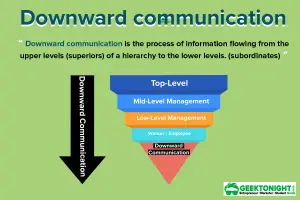
What is Downward Communication? Advantages, Disadvantages

What is Written Communication? Advantages, Disadvantages
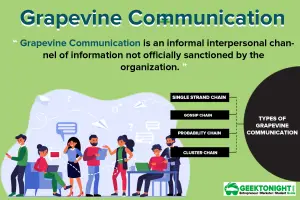
What is Grapevine Communication? Types, Advantages

What is Public Speaking? Characteristics, Techniques, Importance, Modes, Checklist
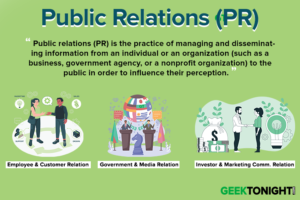
What is Public Relations? Definition, Tools, Function, Advantages, Process

Leave a Reply Cancel reply
You must be logged in to post a comment.
World's Best Online Courses at One Place
We’ve spent the time in finding, so you can spend your time in learning
Digital Marketing
Personal growth.

Development
A Guide To The Top 14 Types Of Reports With Examples Of When To Use Them
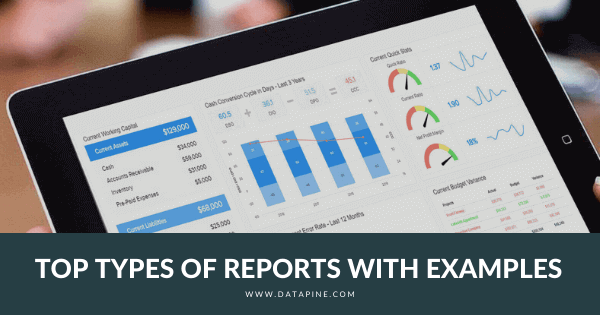
Table of Contents
1) What Is The Report Definition?
2) Top 14 Types Of Reports
3) What Does A Report Look Like?
4) What To Look For In A Reporting Tool
Businesses have been producing reports forever. No matter what role or industry you work in, chances are that you have been faced with the task of generating a tedious report to show your progress or performance.
While reporting has been a common practice for many decades, the business world keeps evolving, and with more competitive industries, the need to generate fast and accurate reports becomes critical. This presents a problem for many modern organizations today, as building reports can take from hours to days. In fact, a survey about management reports performed by Deloitte says that 50% of managers are unsatisfied with the speed of delivery and the quality of the reports they receive.
With this issue in mind, several BI tools have been developed to assist businesses in generating interactive reports with just a few clicks, enhancing the way companies make critical decisions and service insights from their most valuable data.
But, with so many types of reports used daily, how can you know when to use them effectively? How can you push yourself ahead of the pack with the power of information? Here, we will explore the 14 most common types of reports in business and provide some examples of when to use them to your brand-boosting advantage. In addition, we will see how online dashboards have overthrown the static nature of classic reports and given way to a much faster, more interactive way of working with data.
Let’s get started with a brief report definition.
What Is The Report Definition?
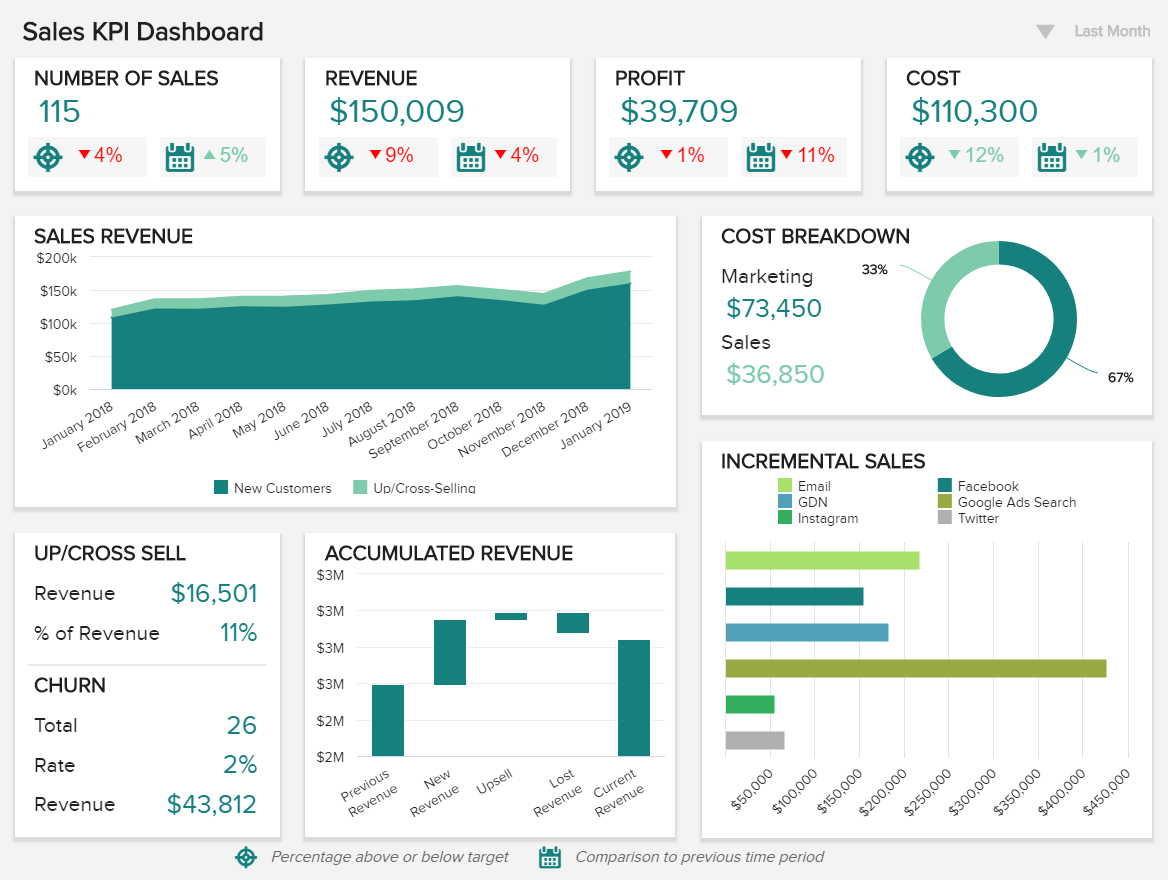
A report is a document that presents relevant business information in an organized and understandable format. Each report is aimed at a specific audience and business purpose, and it summarizes the development of different activities based on goals and objectives.
That said, there are various types of reports that can be used for different purposes. Whether you want to track the progress of your strategies or stay compliant with financial laws, there is a different report for each task. To help you identify when to use them, we will cover the top 14 most common report formats used for businesses today.
What Are The Different Types Of Reports?

1. Informational Reports
The first in our list of reporting types is informational reports. As their name suggests, this report type aims to give factual insights about a specific topic. This can include performance reports, expense reports, and justification reports, among others. A differentiating characteristic of these reports is their objectivity; they are only meant to inform but not propose solutions or hypotheses. Common informational reports examples are for performance tracking, such as annual, monthly, or weekly reports .
2. Analytical Reports
This report type contains a mix of useful information to facilitate the decision-making process through a mix of qualitative and quantitative insights as well as real-time and historical insights. Unlike informational reports that purely inform users about a topic, this report type also aims to provide recommendations about the next steps and help with problem-solving. With this information in hand, businesses can build strategies based on analytical evidence and not simple intuition. With the use of the right BI reporting tool , businesses can generate various types of analytical reports that include accurate forecasts via predictive analytics technologies. Let's look at it with an analytical report example.
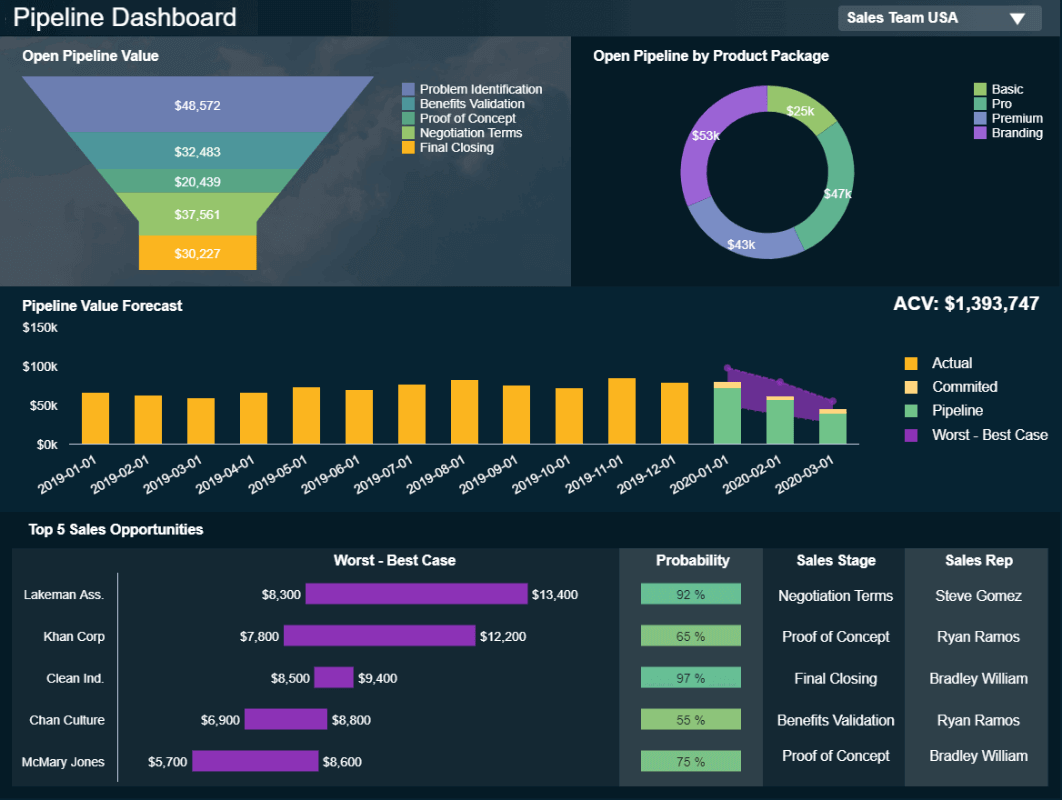
**click to enlarge**
The example above is the perfect representation of how analytical reports can boost a business’s performance. By getting detailed information such as sales opportunities, a probability rate, as well as an accurate pipeline value forecast based on historical data, sales teams can prepare their strategies in advance, tackle any inefficiencies, and make informed decisions for increased efficiency.
3. Operational Reports
These reports track every pertinent detail of the company's operational tasks, such as its production processes. They are typically short-term reports as they aim to paint a picture of the present. Businesses use this type of report to spot any issues and define their solutions or to identify improvement opportunities to optimize their operational efficiency. Operational reports are commonly used in manufacturing, logistics, and retail as they help keep track of inventory, production, and costs, among others.
4. Product Reports
As its name suggests, this report type is used to monitor several aspects related to product development. Businesses often use them to track which of their products or subscriptions are selling the most within a given time period, calculate inventories, or see what kind of product the client values the most. Another common use case of these reports is to research the implementation of new products or develop existing ones. Let’s see it in more detail with a visual example.

The image above is a product report that shows valuable insights regarding usage intention, purchase intention, willingness to pay, and more. In this case, the report is based on the answers from a survey that aimed to understand how the target customer would receive a new product. Getting this level of insights through this report type is very useful for businesses as it allows them to make smart investments when it comes to new products as well as set realistic pricing based on their client’s willingness to pay.
5. Industry Reports
Next in our list of the most common kinds of reports, we have industry-specific reports. Typically, these reports provide an overview of a particular industry, market, or sector with definitions, key trends, leading companies, and industry size, among others. They are particularly useful for businesses that want to enter a specific industry and want to learn how competitive it is or for companies who are looking to set performance benchmarks based on average industry values.
6. Department Reports
These reports are specific to each department or business function. They serve as a communication tool between managers and team members who must stay connected and work together for common goals. Whether it is the sales department, customer service, logistics, or finances, this specific report type helps track and optimize strategies on a deeper level. Let’s look at it with an example of a team performance report .

The image above is a department report created with an online data analysis tool , and it tracks the performance of a support team. This insightful report displays relevant metrics such as the top-performing agents, net promoter score, and first contact resolution rate, among others. Having this information in hand not only helps each team member to keep track of their individual progress but also allows managers to understand who needs more training and who is performing at their best.
7. Progress Reports
From the brunch of informational reports, progress reports provide critical information about the status of a project. These reports can be produced on a daily, weekly, or monthly basis by employees or managers to track performance and fine-tune tasks for the better development of the project. Progress reports are often used as visual materials to support meetings and discussions. A good example is a KPI scorecard .
8. Internal Reports
A type of report that encompasses many others on this list, internal reports refer to any type of report that is used internally in a business. They convey information between team members and departments to keep communication flowing regarding goals and business objectives.
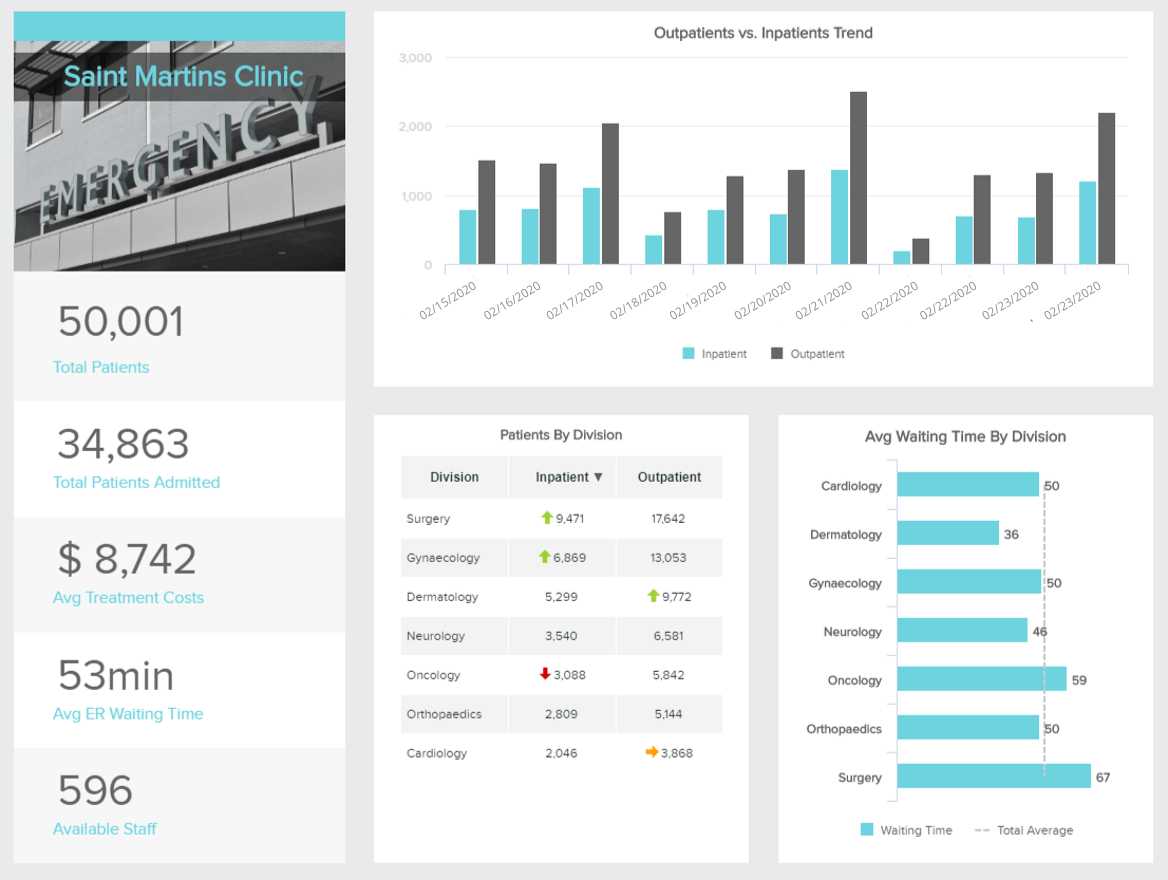
As mentioned above, internal reports are useful communication tools to keep every relevant person in the organization informed and engaged. This healthcare report aims to do just that. By providing insights into the performance of different departments and areas of a hospital, such as in and outpatients, average waiting times, treatment costs, and more, healthcare managers can allocate resources and plan the schedule accurately, as well as monitor any changes or issues in real-time.
9. External Reports
Although most of the reports types listed here are used for internal purposes, not all reporting is meant to be used behind closed doors. External reports are created to share information with external stakeholders such as clients or investors for budget or progress accountability, as well as to governmental bodies to stay compliant with the law requirements.
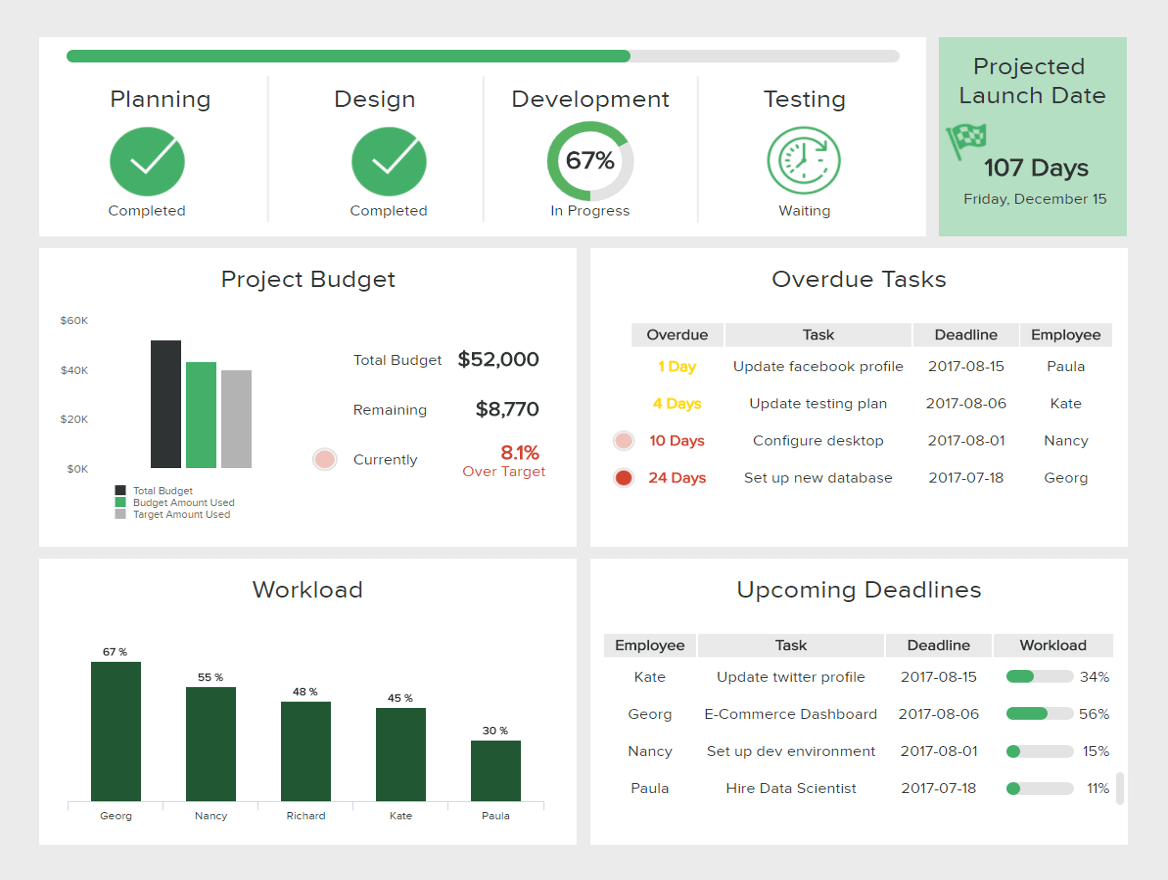
The image above is the perfect example of an external client report from an IT project. This insightful report provides a visual overview of every relevant aspect of the project's development. From deadlines, budget usage, completion stage, and task breakdown, clients can be fully informed and involved in the project.
10. Vertical & Lateral Reports
Next, in our rundown of types of reports, we have vertical and lateral reports. This reporting type refers to the direction in which a report travels. A vertical report is meant to go upward or downward the hierarchy, for example, a management report. A lateral report assists in organization and communication between groups that are at the same level of the hierarchy, such as the financial and marketing departments.
11. Research Reports
Without a doubt, one of the most vital reporting types for any modern business is centered on research. Being able to collect, collate, and drill down into insights based on key pockets of your customer base or industry will give you the tools to drive innovation while meeting your audience’s needs head-on.

The image above is a market research analytics report example for customer demographics. It serves up a balanced blend of metrics that will empower you to boost engagement as well as retention rates. Here, you can drill down into your audience’s behaviors, interests, gender, educational levels, and tech adoption life cycles with a simple glance.
What’s particularly striking about this dashboard is the fact that you can explore key trends in brand innovation with ease, gaining a working insight into how your audience perceives your business. This invaluable type of report will help you get under the skin of your consumers, driving growth and loyalty in the process.
12. Strategic Reports
Strategy is a vital component of every business, big or small. Strategic analytics tools are perhaps the broadest and most universal of all the different types of business reports imaginable.
These particular tools exist to help you understand, meet, and exceed your most pressing organizational goals consistently by serving up top-level metrics on a variety of initiatives or functions.
By working with strategic-style tools, you will:
- Improve internal motivation and engagement
- Refine your plans and strategies for the best possible return on investment (ROI)
- Enhance internal communication and optimize the way your various departments run
- Create more room for innovation and creative thinking
13. Project Reports
Projects are key to keeping a business moving in the right direction while keeping innovation and evolution at the forefront of every plan, communication, or campaign. But without the right management tools, a potentially groundbreaking project can become a resource-sapping disaster.
A project management report serves as a summary of a particular project's status and its various components. It's a visual tool that you can share with partners, colleagues, clients, and stakeholders to showcase your project's progress at multiple stages. Let’s look at our example and dig a little deeper.
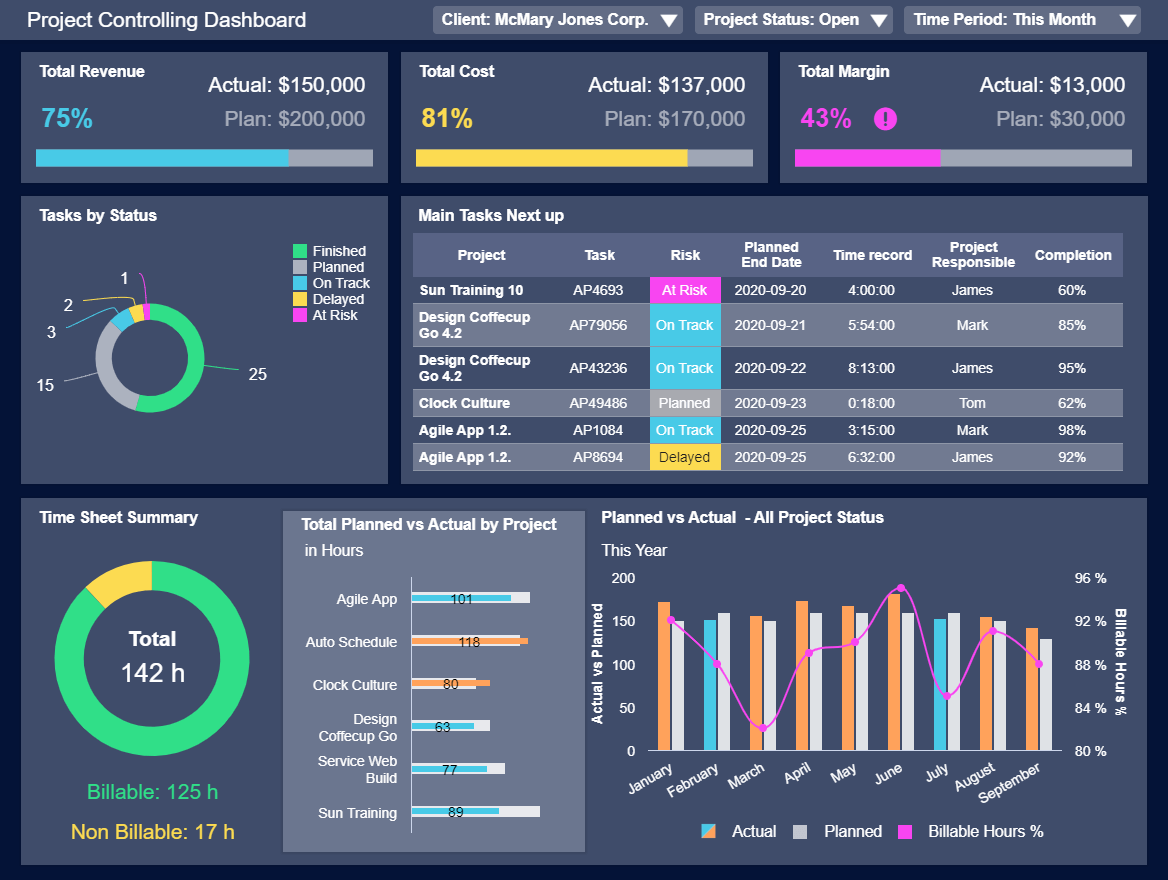
To ensure consistent success across the board, the kinds of reports you must work with are based on project management.
Our example is a project management dashboard equipped with a melting pot of metrics designed to improve the decision-making process while keeping every facet of your company’s most important initiatives under control. Here, you can spot pivotal trends based on costs, task statuses, margins, costs, and overall project revenue. With this cohesive visual information at your fingertips, not only can you ensure the smooth end-to-end running of any key project, but you can also drive increased operational efficiency as you move through every significant milestone.
14. Statutory Reports
It may not seem exciting or glamorous, but keeping your business's statutory affairs in order is vital to your ongoing commercial health and success.
When it comes to submitting such vital financial and non-financial information to official bodies, one small error can result in serious repercussions. As such, working with statutory types of report formats is a water-tight way of keeping track of your affairs and records while significantly reducing the risk of human error.
Armed with interactive insights and dynamic visuals, you will keep your records clean and compliant while gaining the ability to nip any potential errors or issues in the bud.
What Does A Report Look Like?
Now that we’ve covered the most relevant types of reports, we will answer the question: what does a report look like?
As mentioned at the beginning of this insightful guide, static reporting is a thing of the past. With the rise of modern technologies like self-service BI tools , the use of interactive reports in the shape of business dashboards has become more and more popular among companies.
Unlike static reports that take time to be generated and are difficult to understand, modern reporting tools are intuitive. Their visual nature makes them easy to understand for any type of user, and they provide businesses with a central view of their most important performance indicators for an improved decision-making process. Here, we will cover 20 useful dashboard examples from different industries, functions, and platforms to put the value of dashboard reporting into perspective.
1. Financial Report
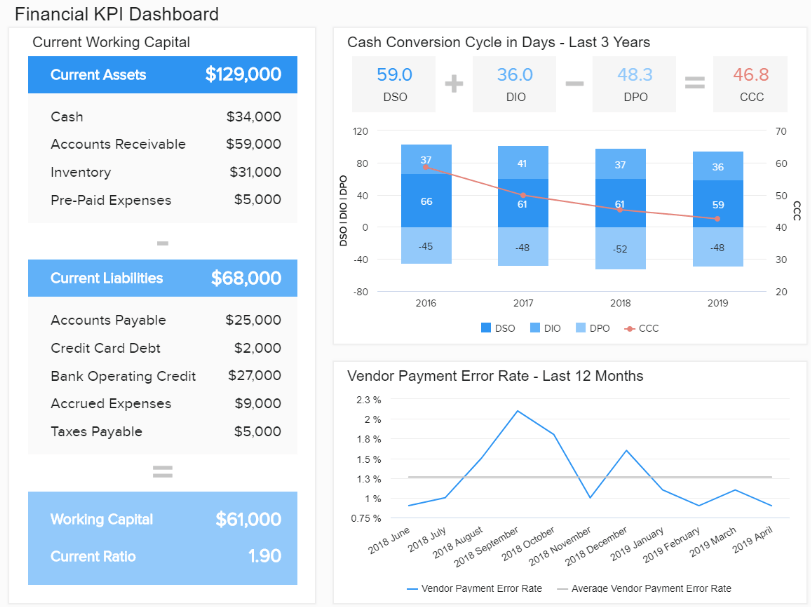
Keeping finances in check is critical for success. This financial report offers an overview of the most important financial metrics that a business needs to monitor its economic activities and answer vital questions to ensure healthy finances.
With insights about liquidity, invoicing, budgeting, and general financial stability, managers can extract long and short-term conclusions to reduce inefficiencies, make accurate forecasts about future performance, and keep the overall financial efficiency of the business flowing. For instance, getting a detailed calculation of the business's working capital can allow you to understand how liquid your company is. If it's higher than expected, it means you have the potential to invest and grow—definitely, one of the most valuable types of finance reports.
2. Marketing Report
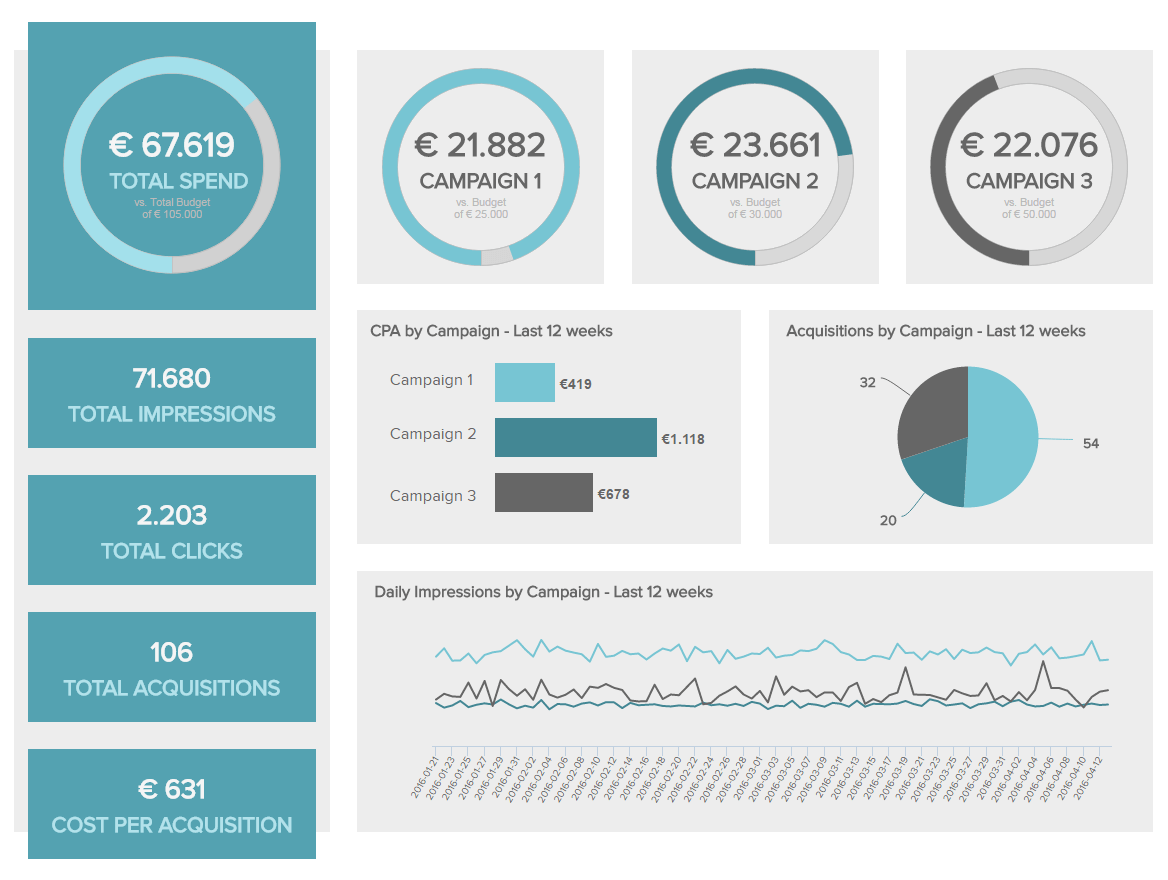
Our following example is a marketing report that ensures a healthy return on investment from your marketing efforts. This type of report offers a detailed overview of campaign performance over the last 12 weeks. Having access to this information enables you to maximize the value of your promotional actions, keeping your audience engaged by providing a targeted experience.
For instance, you can implement different campaign formats as a test and then compare which one is most successful for your business. This is possible thanks to the monitoring of important marketing metrics such as the click-through rate (CTR), cost per click (CPC), cost per acquisition (CPA), and more.
The visual nature of this report makes it easy to understand important insights at a glance. For example, the four gauge charts at the top show the total spending from all campaigns and how much of the total budget of each campaign has been used. In just seconds, you can see if you are on target to meet your marketing budgets for every single campaign.
3. Sales Report

An intuitive sales dashboard like the one above is the perfect analytical tool to monitor and optimize sales performance. Armed with powerful high-level metrics, this report type is especially interesting for managers, executives, and sales VPs as it provides relevant information to ensure strategic and operational success.
The value of this sales report lies in the fact that it offers a complete and comprehensive overview of relevant insights needed to make smart sales decisions. For instance, at the top of an analysis tool, you get important metrics such as the number of sales, revenue, profit, and costs, all compared to a set target and to the previous time period. The use of historical data is fundamental when building successful sales strategies as they provide a picture of what could happen in the future. Being able to filter the key metrics all in one screen is a key benefit of modern reporting.
4. HR Report
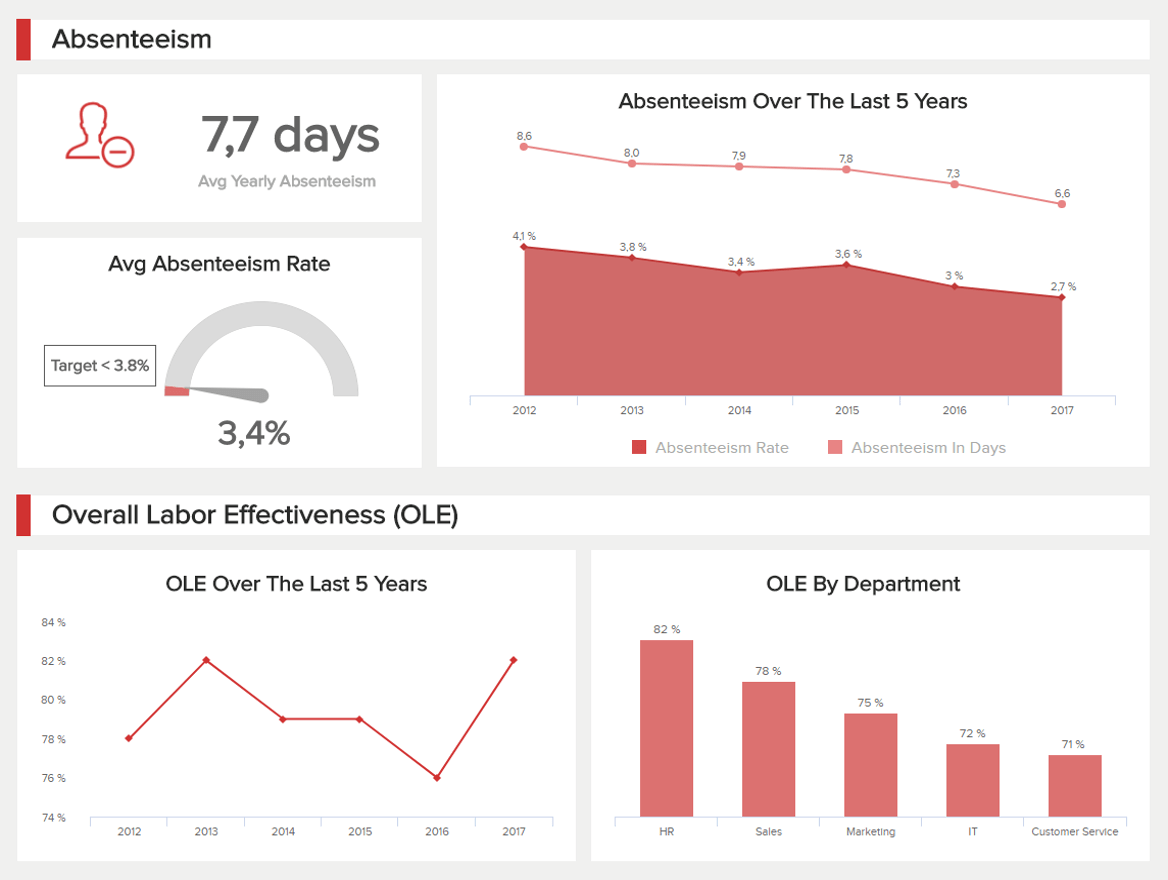
Our next example of a report is about human resources analytics . The HR department needs to track various KPIs for employee performance and effectiveness. But overall, they have to ensure that employees are happy and working in a healthy environment since an unhappy workforce can significantly damage an organization. This is all possible with the help of this intuitive dashboard.
Providing a comprehensive mix of metrics, this employee-centric report drills down into every major element needed to ensure successful workforce management. For example, the top portion of the dashboard covers absenteeism in 3 different ways: yearly average, absenteeism rate with a target of 3.8%, and absenteeism over the last five years. Tracking absenteeism rates in detail is helpful as it can tell you if your employees are skipping work days. If the rate is over the expected target, then you have to dig deeper into the reasons and find sustainable solutions.
On the other hand, the second part of the dashboard covers the overall labor effectiveness (OLE). This can be tracked based on specific criteria that HR predefined, and it helps them understand if workers are achieving their targets or if they need extra training or help.
5. Management Report
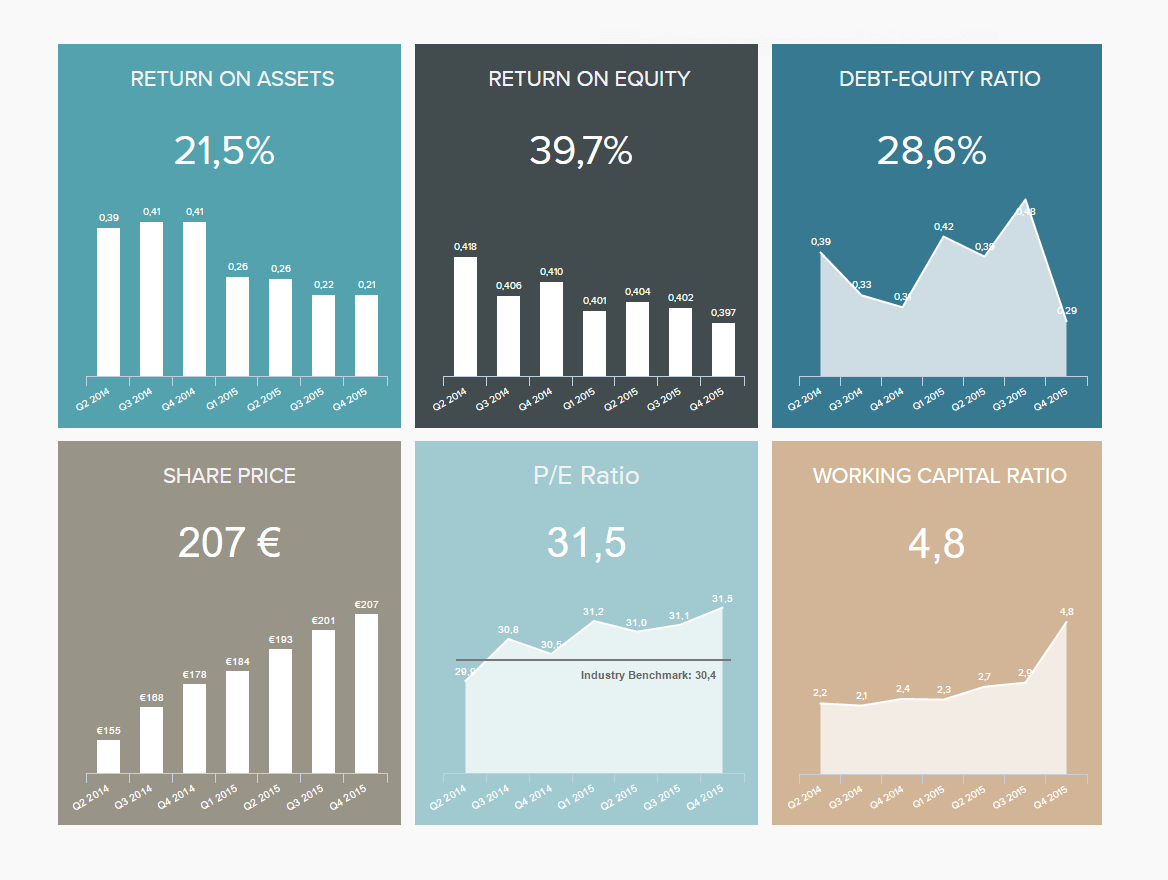
Managers must monitor big amounts of information to ensure that the business is running smoothly. One of them being investor relationships. This management dashboard focuses on high-level metrics that shareholders need to look at before investing, such as the return on assets, return on equity, debt-equity ratio, and share price, among others.
By getting an overview of these important metrics, investors can easily extract the needed information to make an informed decision regarding an investment in your business. For instance, the return on assets measures how efficiently are the company's assets being used to generate profit. With this information, investors can understand how effectively your company deploys available resources compared to others in the market. Another great indicator is the share price; the higher the increase in your share price, the more money your shareholders are making from their investment.
6. IT Report
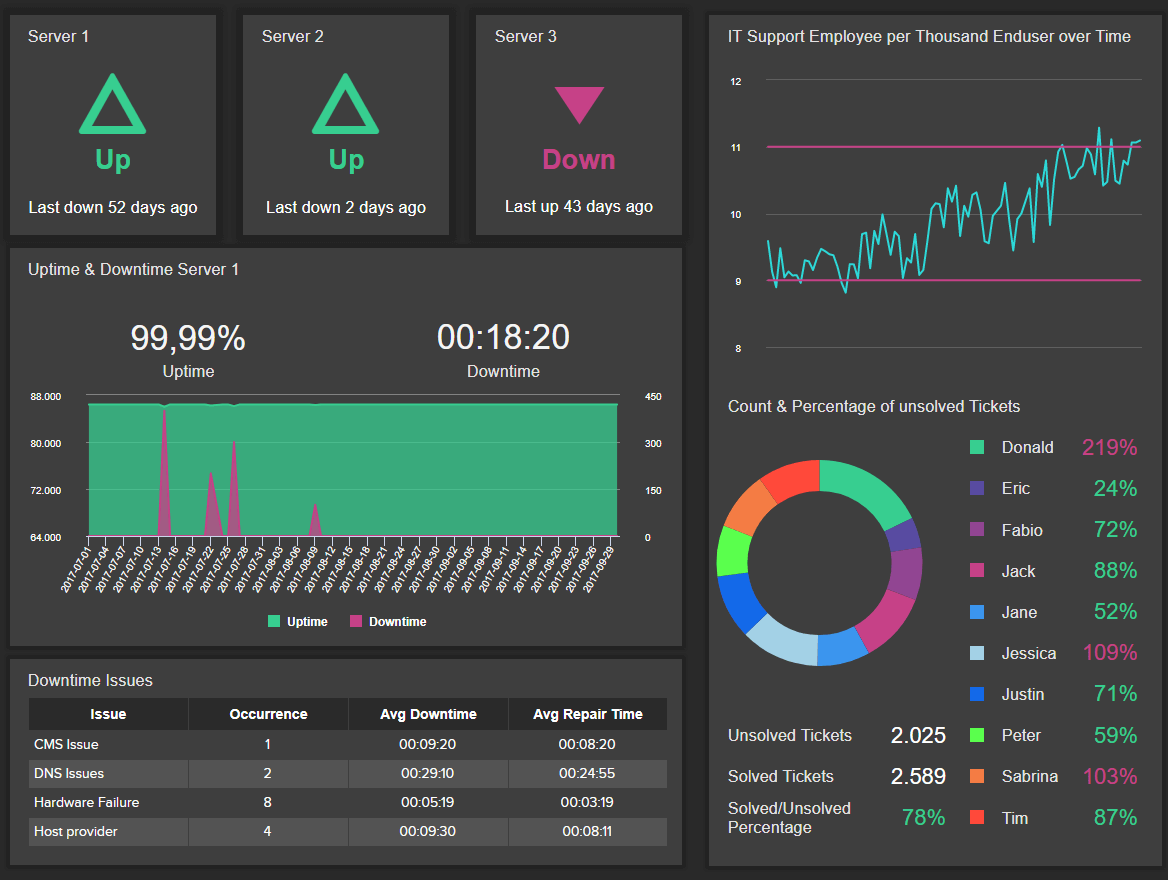
Just like all the other departments and sections covered in this list, the IT department is one that can especially benefit from these types of reports. With so many technical issues to solve, the need for a visual tool to help IT specialists stay on track with their workload becomes critical.
As seen in the image above, this IT dashboard offers detailed information about different system indicators. For starters, we get a visual overview of the status of each server, followed by a detailed graph displaying the uptime & downtime of each week. This is complemented by the most common downtown issues and some ticket management information. Getting this level of insight helps your IT staff to know what is happening and when it is happening and find proper solutions to prevent these issues from repeating themselves. Keeping constant track of these metrics will ensure robust system performance.
7. Procurement Report
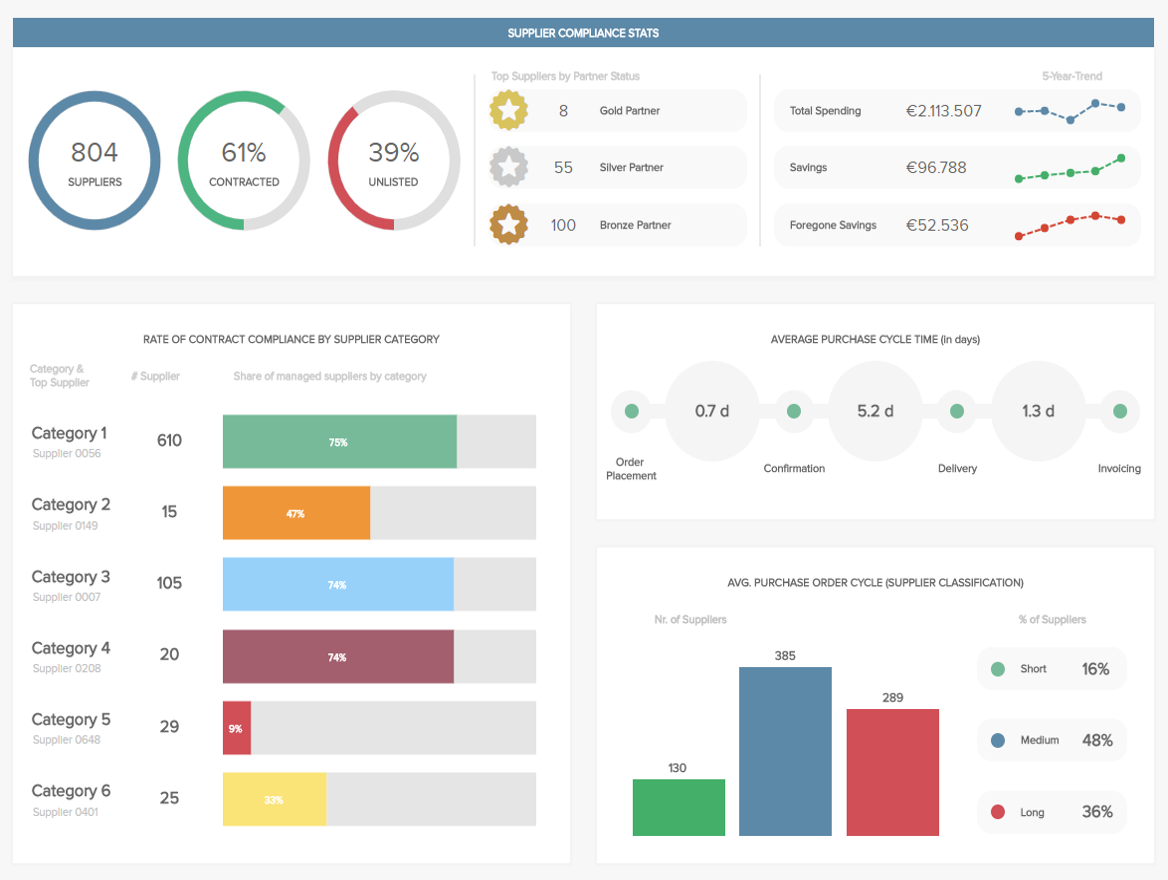
The following example of a report was built with intuitive procurement analytics software , and it gives a general view of various metrics that the procurement department needs to work with regularly.
With the possibility to filter, drill down, and interact with KPIs, this intuitive procurement dashboard offers key information to ensure a healthy supplier relationship. With metrics such as compliance rate, the number of suppliers, or the purchase order cycle time, the procurement team can classify the different suppliers, define the relationship each of them has with the company, and optimize processes to ensure it stays profitable.
8. Customer Service Report
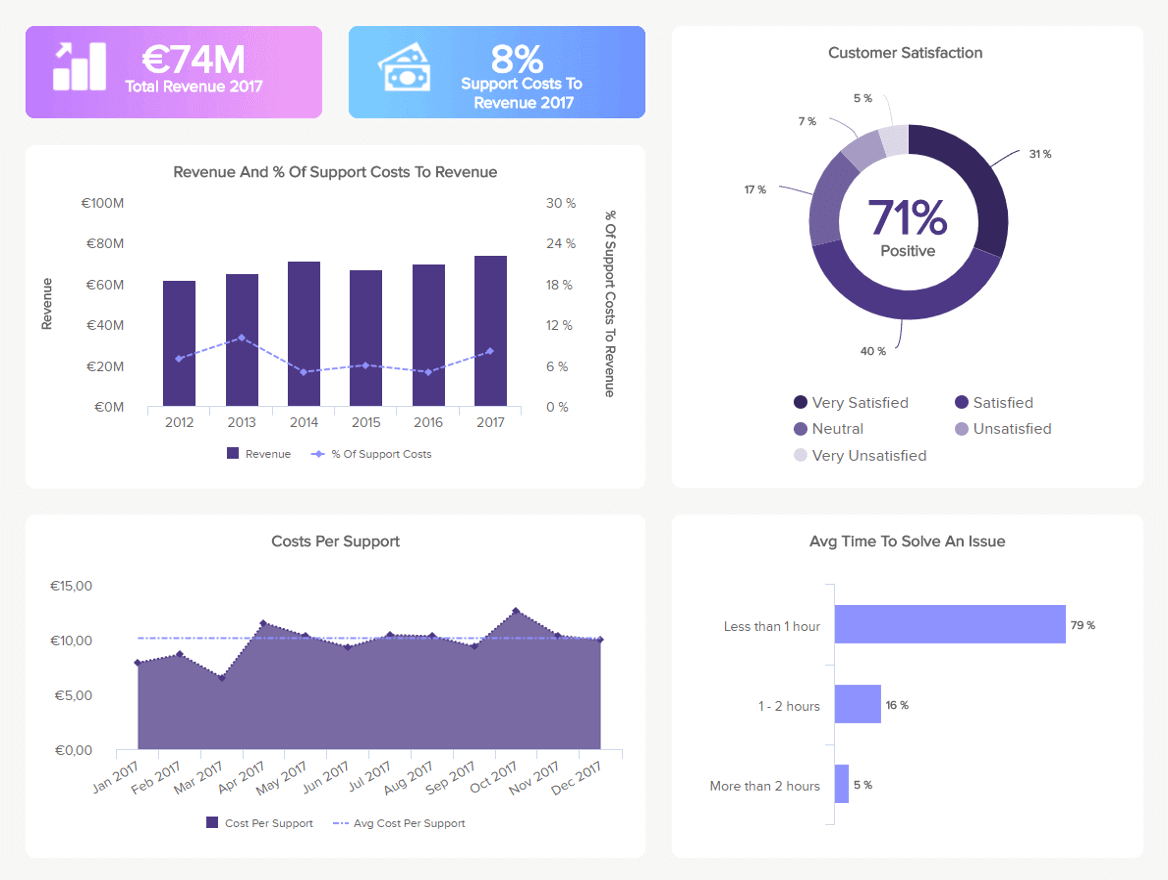
Following our list of examples of reports is one from the support area. Armed with powerful customer service KPIs , this dashboard is a useful tool to monitor performance, spot trends, identify strengths and weaknesses, and improve the overall effectiveness of the customer support department.
Covering aspects such as revenue and costs from customer support as well as customer satisfaction, this complete analysis tool is the perfect tool for managers who have to keep an eye on every little detail from a performance and operational perspective. For example, by monitoring your customer service costs and comparing them to the revenue, you can understand if you are investing the right amount into your support processes. This can be directly related to your agent’s average time to solve issues; the longer it takes to solve a support ticket, the more money it will cost and the less revenue it will bring. If you see that your agents are taking too long to solve an issue, you can think of some training instances to help them reduce this number.
9. Market Research Report

This list of report types examples would not be complete without a market research report . Market research agencies deal with a large amount of information coming from surveys and other research sources. Taking all this into account, the need for reports that can be filtered for deeper interaction becomes more necessary for this industry than any other.
The image above is a brand analytics dashboard that displays the survey results about how the public perceives a brand. This savvy tool contains different charts that make it easy to understand the information visually. For instance, the map chart with the different colors lets you quickly understand in which regions each age range is located. The charts can be filtered further to see the detailed answers from each group for a deeper analysis.
10. Social Media Report
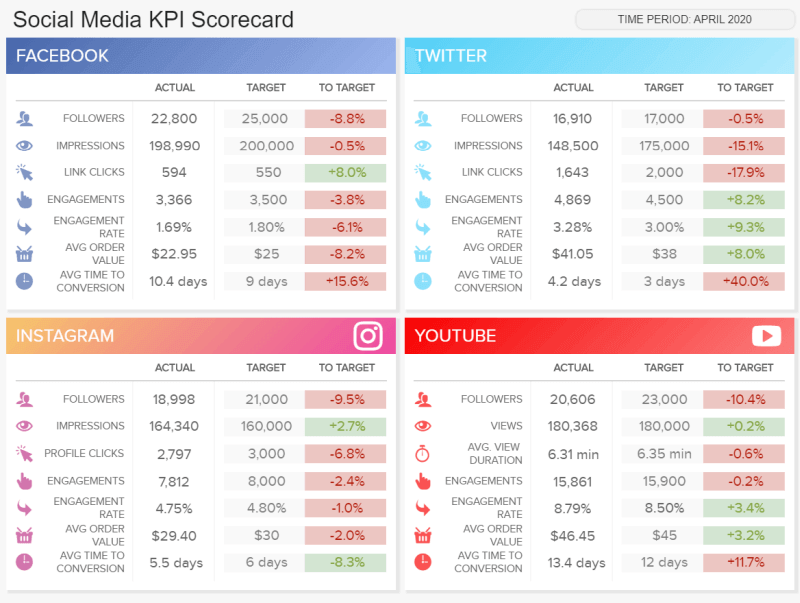
Last but not least, we have a social media report . This scorecard format dashboard monitors the performance of 4 main social media channels: Facebook, Twitter, Instagram, and YouTube, and it serves as a perfect visual overview to track the performance of different social media efforts and achievements.
Tracking relevant metrics such as followers, impressions, clicks, engagement rates, and conversions, this report type serves as a perfect progress report to show to managers or clients who need to see the status of their social channels. Each metric is shown in its actual value and compared to a set target. The colors green and red from the fourth column let you quickly understand if a metric is over or under its expected target.
11. Logistics Report
Logistics are the cornerstone of an operationally fluent and progressive business. If you deal with large quantities of goods and tangible items, in particular, maintaining a solid logistical strategy is vital to ensuring you maintain your brand reputation while keeping things flowing in the right direction.
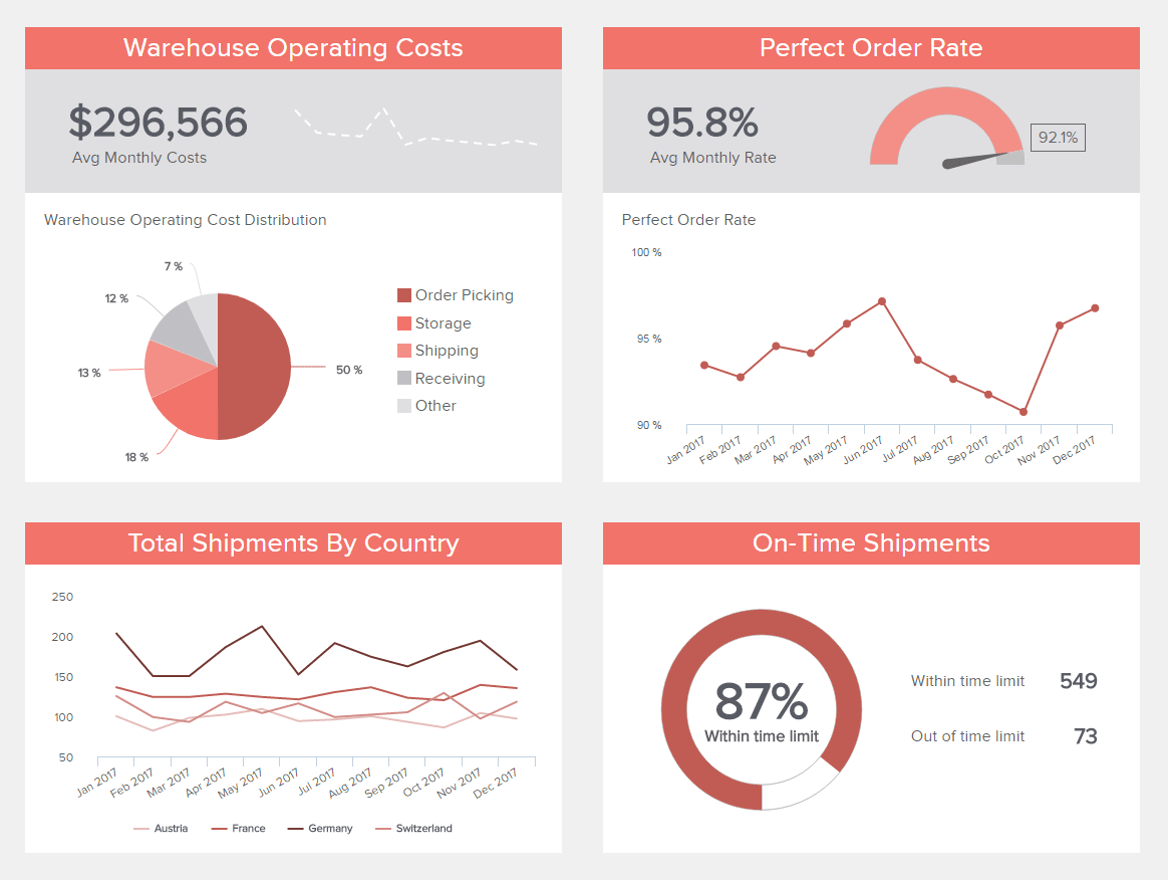
A prime example of the types of data reporting tool designed to improve logistical management, our warehouse KPI dashboard is equipped with metrics required to maintain strategic movement while eliminating any unnecessary costs or redundant processes. Here, you can dig into your shipping success rates across regions while accessing warehouse costs and perfect order rates in real-time. If you spot any potential inefficiencies, you can track them here and take the correct course of action to refine your strategy. This is an essential tool for any business with a busy or scaling warehouse.
12. Manufacturing Report
Next, in our essential types of business reports examples, we’re looking at tools made to improve your business’s various manufacturing processes.
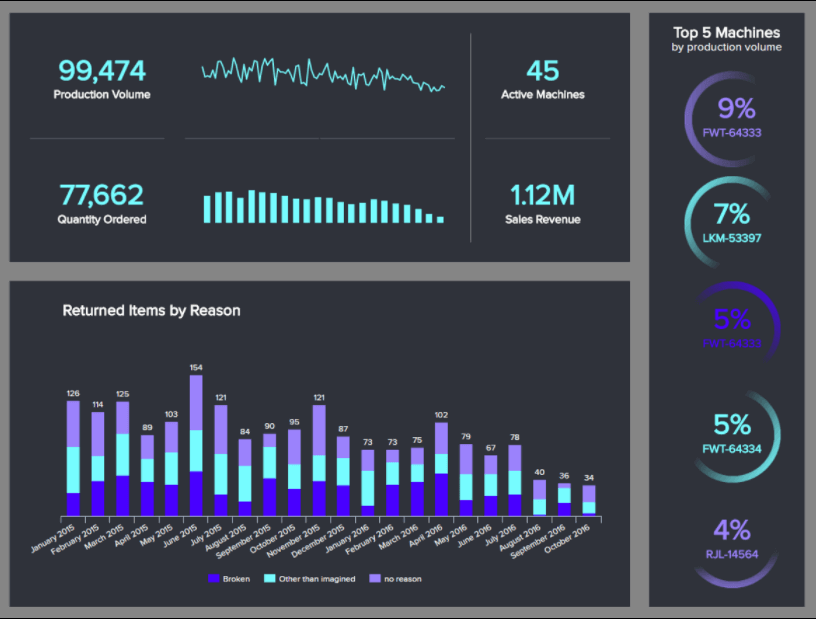
Our clean and concise production tool is a sight to behold and serves up key manufacturing KPIs that improve the decision-making process regarding costs, volume, and machinery.
Here, you can hone in on historical patterns and trends while connecting with priceless real-time insights that will not only help you make the right calls concerning your manufacturing process at the moment but will also help you formulate predictive strategies that will ultimately save money, boost productivity, and result in top-quality products across the board.
13. Retail Report
As a retailer with so many channels to consider and so many important choices to make, working with the right metrics and visuals is absolutely essential. Fortunately, we live in an age where there are different types of reporting designed for this very reason.
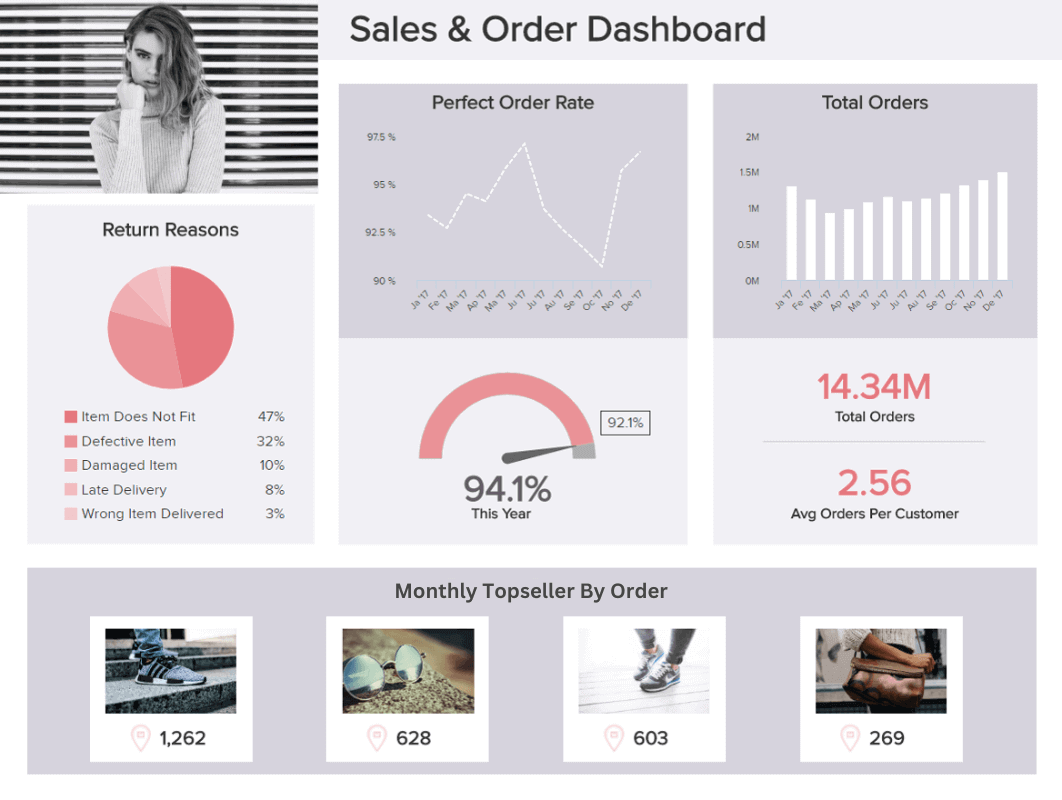
Our sales and order example, generated with retail analytics software , is a dream come true for retailers as it offers the visual insights needed to understand your product range in greater detail while keeping a firm grip on your order volumes, perfect order rates, and reasons for returns.
Gaining access to these invaluable insights in one visually presentable space will allow you to track increases or decreases in orders over a set timeframe (and understand whether you’re doing the right things to drive engagement) while plowing your promotional resources into the products that are likely to offer the best returns.
Plus, by gaining an accurate overview of why people are returning your products, you can omit problem items or processes from your retail strategy, improving your brand reputation as well as revenue in the process.
14. Digital Media Report
The content and communications you publish are critical to your ongoing success, regardless of your sector, niche, or specialty. Without putting out communications that speak directly to the right segments of your audience at the right times in their journey, your brand will swiftly fade into the background.
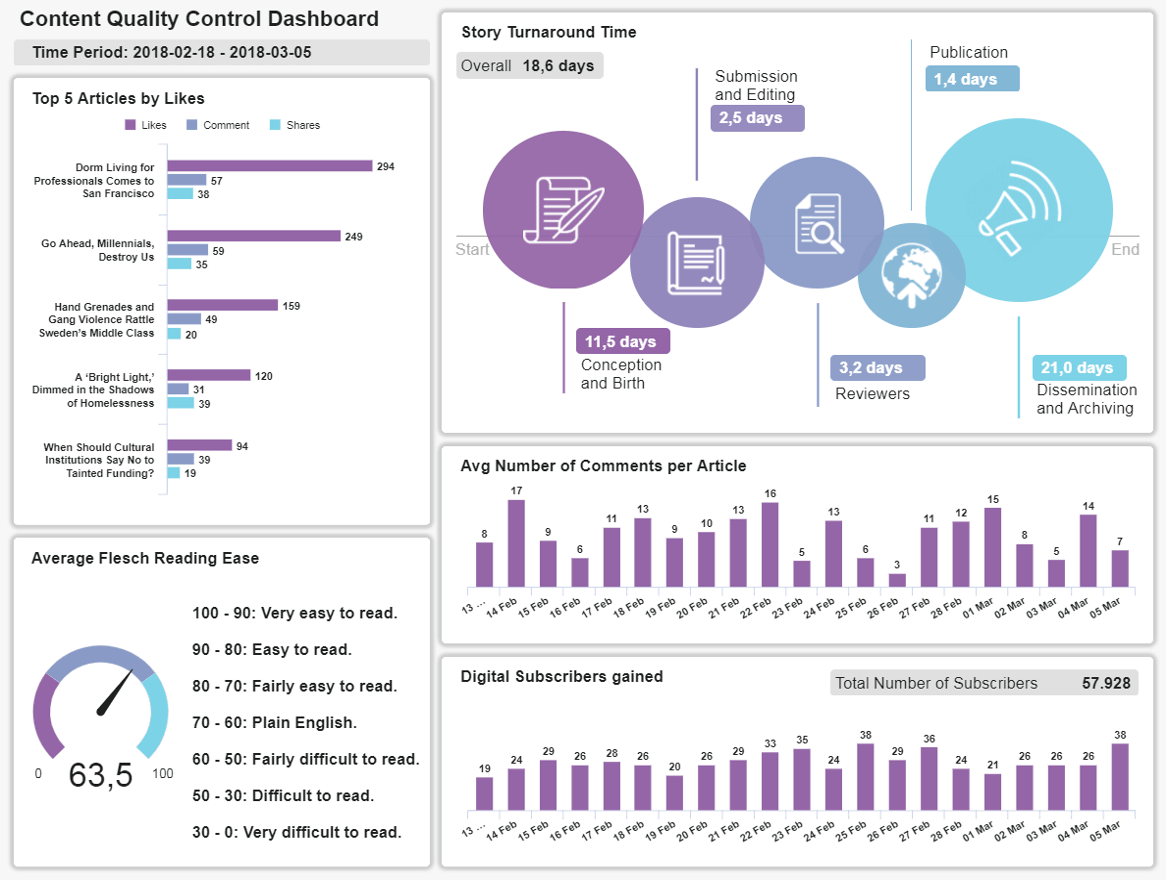
To ensure your brand remains inspiring, engaging, and thought-leading across channels, working with media types of a business report is essential. You must ensure your communications cut through the noise and scream ‘quality’ from start to finish—no ifs, no buts, no exceptions.
Our content quality control tool is designed with a logical hierarchy that will tell you if your content sparks readership, if the language you’re using is inclusive and conversational, and how much engagement-specific communications earn. You can also check your most engaged articles with a quick glance to understand what your users value most. Armed with this information, you can keep creating content that your audience loves and ultimately drives true value to the business.
15. Energy Report
In the age of sustainability and in the face of international fuel hikes, managing the energy your business uses effectively is paramount. Here, there is little room for excess or error, and as such, working with the right metrics is the only way to ensure successful energy regulation.
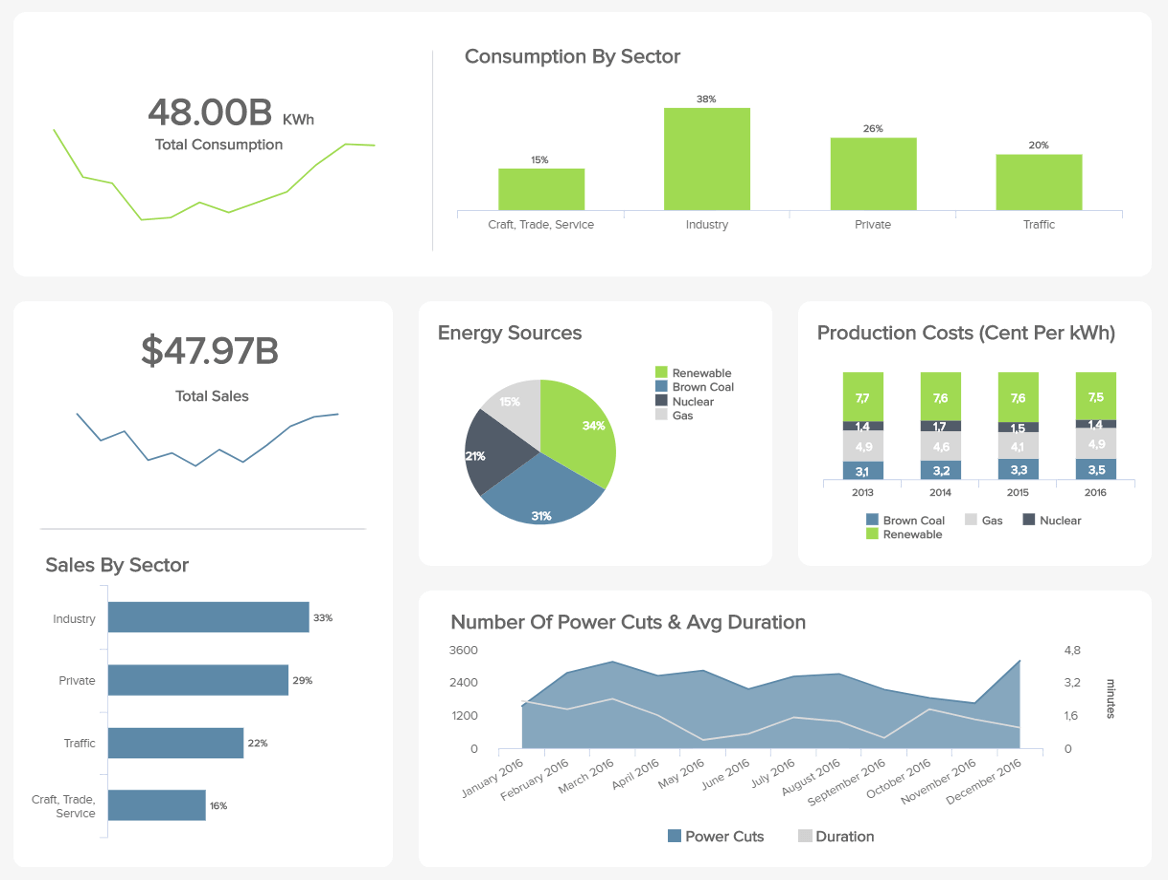
If your company has a big HQ or multiple sites that require power, our energy management analytics tool will help you take the stress out of managing your resources. One of the most striking features of this dashboard is the fact that it empowers you to compare your company’s energy usage against those from other sectors and set an accurate benchmark.
Here, you can also get a digestible breakdown of your various production costs regarding energy consumption and the main sources you use to keep your organization running. Regularly consulting these metrics will not only help you save colossal chunks of your budget, but it will also give you the intelligence to become more sustainable as an organization. This, in turn, is good for the planet and your brand reputation—a real win-win-win.
16. FMCG Report
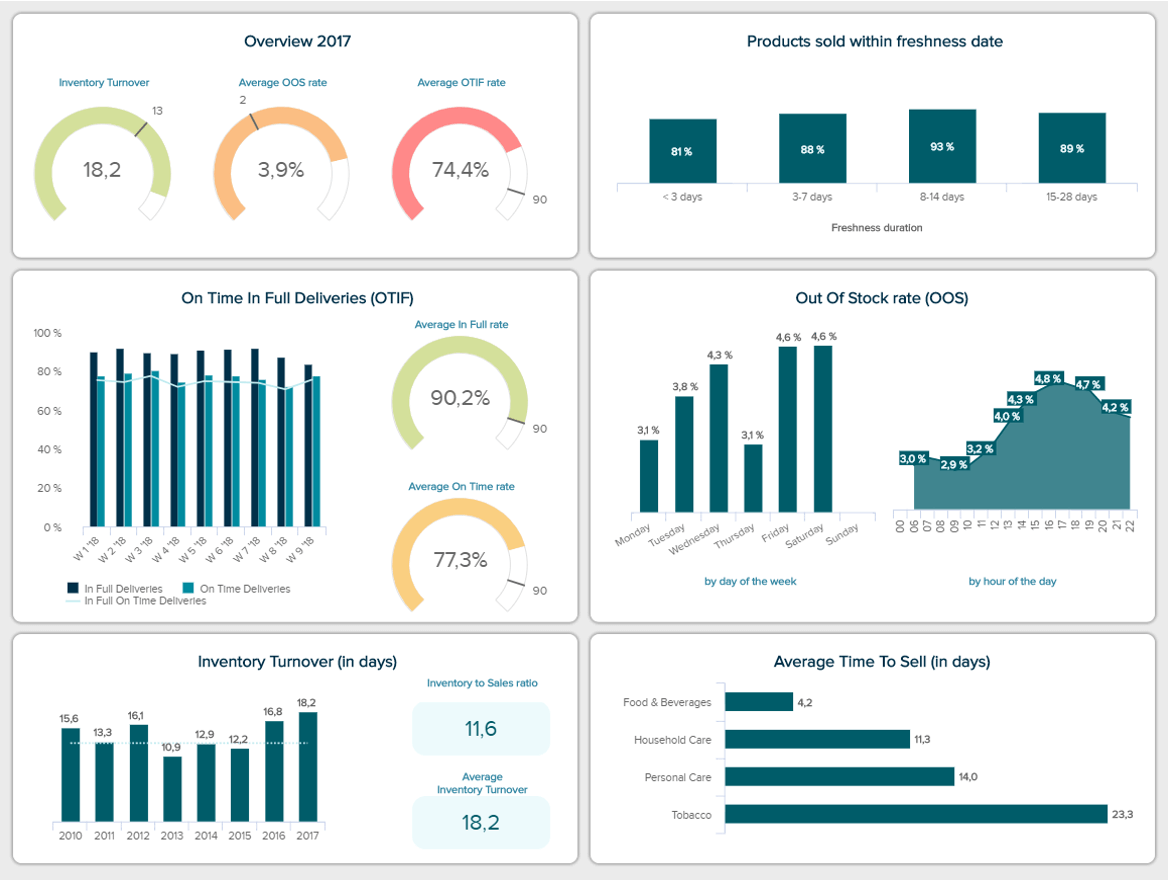
The fast-moving consuming goods (FMCG) industry can highly benefit from a powerful report containing real-time insights. This is because the products handled in this sector which are often food and beverages, don’t last very long. Therefore, having a live overview of all the latest developments can help decision-makers optimize the supply chain to ensure everything runs smoothly and no major issues happen.
Our report format example above aims to do just that by providing an overview of critical performance indicators, such as the percentage of products sold within freshness date, the out-of-stock rate, on-time in full deliveries, inventory turnover, and more. What makes this template so valuable is the fact that it provides a range of periods to get a more recent view of events but also a longer yearly view to extract deeper insights.
The FMCG dashboard also offers an overview of the main KPIs to help users understand if they are on the right track to meet their goals. There, we can observe that the OTIF is far from its target of 90%. Therefore, it should be looked at in more detail to optimize it and prevent it from affecting the entire supply chain.
17. Google Analytics Report

Regardless of the industry you are in, if you have a website then you probably require a Google Analytics report. This powerful tool helps you understand how your audience interacts with your website while helping you reach more people through the Google search engine. The issue is that the reports the tool provides are more or less basic and don’t give you the dynamic and agile view you need to stay on top of your data and competitors.
For that reason, at datapine, we generated a range of Google Analytics dashboards that take your experience one step further by allowing you to explore your most important KPIs in real-time. That way, you’ll be able to spot any potential issues or opportunities to improve as soon as they occur, allowing you to act on them on the spot.
Among some of the most valuable metrics you can find in this sample are the sessions and their daily, weekly, and monthly development, the average session duration, the bounce rate by channel and by top 5 countries, among others.
18. YouTube Report
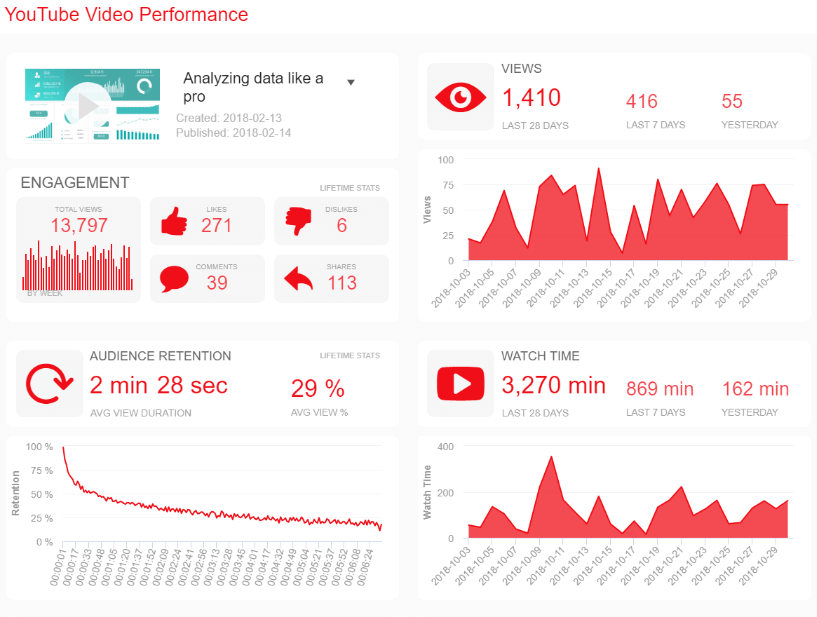
So far, we’ve covered examples for various industries and sectors. Now, we will dive a bit deeper into some templates related to popular platforms businesses use in their daily operations. With the rise in video-related content, we could not leave YouTube outside of the list. This popular platform hides some valuable insights that can help you improve your content for your current audience but also reach new audiences that can be interested in your products or services.
This highly visual and dynamic sample offers an interactive view of relevant KPIs to help you understand every aspect of your video performance. The template can be filtered for different videos to help you understand how each type of content performs. For instance, you get an overview of engagement metrics, such as likes, dislikes, comments, and shares, that way, you can understand how your audience interacts with your content.
Additionally, you also get more detailed charts about the number of views, the average watch time per day, and audience retention. These indicators can help you understand if something needs to be changed. For instance, audience retention goes down a lot after one minute and a half. Therefore you either need to make sure you are making the rest of the video a bit more interesting or offering your product or service or any other relevant information in the first minute.
19. LinkedIn Report
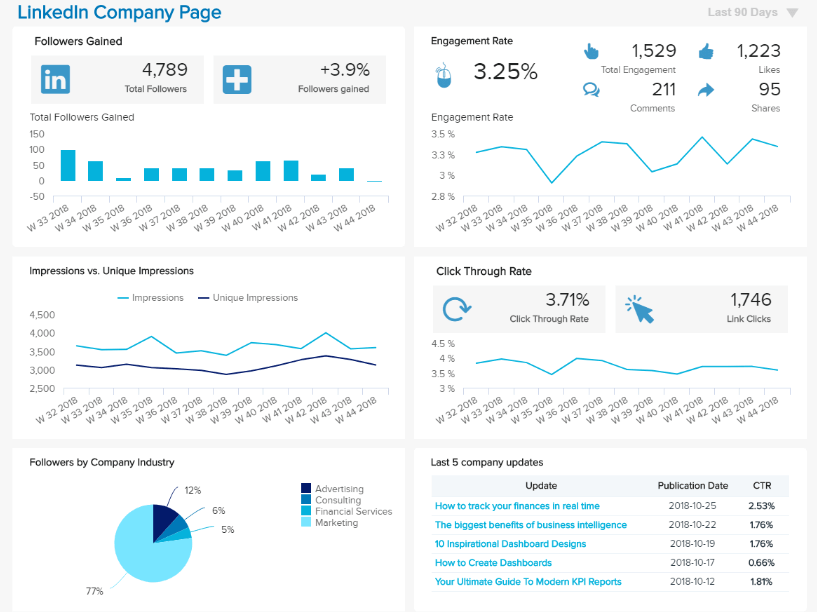
Another very important platform that companies use, no matter their size or industry, is LinkedIn. This platform is the place where companies develop and showcase their corporate image, network with other companies, and tell their clients and audience about the different initiatives they are developing to grow and be better. Some organizations also use LinkedIn to showcase their charity or sustainability initiatives.
The truth is LinkedIn has become an increasingly relevant platform, and just like we discussed with YouTube, organizations need to analyze data to ensure their strategies are on the right path to success.
The template above offers a 360-degree view of a company page's performance. With metrics such as the followers gained, engagement rate, impressions vs unique impressions, CTR, and more. Decision-makers can dive deeper into the performance of their content and understand what their audience enjoys the most. For instance, by looking at the CTR of the last 5 company updates, you can start to get a sense of what topics and content format your audience on the platforms interact with the most. That way, you’ll avoid wasting time and resources producing content without interaction.
20. Healthcare Report

Moving on from platform-related examples, we have one last monthly report template from a very relevant sector, the healthcare industry. For decades now, hospitals and healthcare professionals have benefited from data to develop new treatments and analyze unknown diseases. But, data can also help to ensure daily patient care is of top quality.
Our sample above is a healthcare dashboard report that tracks patient satisfaction stats for a clinic named Saint Martins Clinic. The template provides insights into various aspects of patient care that can affect their satisfaction levels to help spot any weak areas.
Just by looking at the report in a bit more detail, we can already see that the average waiting time for arrival to a bed and time to see a doctor are on the higher side. This is something that needs to be looked into immediately, as waiting times are the most important success factors for patients. Additionally, we can see those lab test turnarounds are also above target. This is another aspect that should be optimized to prevent satisfaction levels from going down.
If you feel inspired by this list and want to see some of the best uses for business reports, then we recommend you take a look at our dashboard examples library, where you will find over 80+ templates from different industries, functions, and platforms for extra inspiration!
What You Should Look For In A Reporting Tool
As you learned from our extensive list of examples, different types of reports are widely used across industries and sectors. Now, you might wonder, how do I get my hands on one of these reports? The answer is a professional online reporting tool. With the right software in hand, you can generate stunning reports to extract the maximum potential out of your data and boost business growth in the process.
But, with so many options in the market, how do make sure you choose the best tool for your needs? Below we cover some of the most relevant features and capabilities you should look for to make the most out of the process.
- Pre-made reporting templates
To ensure successful operations, a business will most likely need to use many types of reports for its internal and external strategies. Manually generating these reports can become a time-consuming task that burdens the business. That is why professional reporting software should offer pre-made reporting templates. At datapine, we offer an extensive template library that allows users to generate reports in a matter of seconds—allowing them to use their time on actually analyzing the information and extracting powerful insights from it.
- Multiple visualization options
If you look for report templates on Google you might run into multiple posts about written ones. This is not a surprise, as written reports have been the norm for decades. That being said, a modern approach to reporting has developed in the past years where visuals have taken over text. The value of visuals lies in the fact that they make the information easier to understand, especially for users who have no technical knowledge. But most importantly, they make the information easier to explore by telling a compelling story. For that reason, the tool you choose to invest in should provide you with multiple visualization options to have the flexibility to tell your data story in the most successful way possible.
- Customization
While pre-made templates are fundamental to generating agile reports, being able to customize them to meet your needs is also of utmost importance. At datapine, we offer our users the possibility to customize their reports to fit their most important KPIs, as well as their logo, business colors, and font. This is an especially valuable feature for external reports that must be shown to clients or other relevant stakeholders, giving your reports a more professional look. Customization can also help from an internal perspective to provide employees who are uncomfortable with data with a familiar environment to work in.
- Real-time insights
In the fast-paced world we live in today, having static reports is not enough. Businesses need to have real-time access to the latest developments in their data to spot any issues or opportunities as soon as they occur and act on them to ensure their resources are spent smartly and their strategies are running as expected. Doing so will allow for agile and efficient decision-making, giving the company a huge competitive advantage.
- Sharing capabilities
Communication and collaboration are the basis of a successful reporting process. Today, team members and departments need to be connected to ensure everyone is on the right path to achieve general company goals. That is why the tool you invest in should offer flexible sharing capabilities to ensure every user can access the reports. For instance, at datapine, we offer our users the possibility to share reports through automated emails or password-protected URLs with viewing or editing rights depending on what data the specific user can see and manipulate. A great way to keep everyone connected and boost collaboration.
Types Of Reporting For Every Business & Purpose
As we’ve seen throughout our journey, different report formats are used by businesses for diverse purposes in their everyday activities. Whether you’re talking about types of reports in research, types of reports in management, or anything in between, these dynamic tools will get you where you need to be (and beyond).
In this post, we covered the top 14 most common ones and explored key examples of how different report types are changing the way businesses are leveraging their most critical insights for internal efficiency and, ultimately, external success.
With modern tools and solutions, reporting doesn’t have to be a tedious task. Anyone in your organization can rely on data for their decision-making process without needing technical skills. Rather, you want to keep your team connected or show progress to investors or clients. There is a report type for the job. To keep your mind fresh, here are the top 14 types of data reports covered in this post:
- Informational reports
- Analytical reports
- Operational reports
- Product reports
- Industry reports
- Department reports
- Progress reports
- Internal reports
- External reports
- Vertical and lateral reports
- Strategic reports
- Research reports
- Project reports
- Statutory reports
Now, over to you. Are you ready? If you want to start building your own types of reports and get ahead of the pack today, then you should try our BI reporting software for 14 days for free !
Skip to Content
Massey University
- Search OWLL
- Handouts (Printable)
- Pre-reading Service
- StudyUp Recordings
- StudyUp Postgraduate
- Academic writing
- Intro to academic writing
- What is academic writing?
- Writing objectively
- Writing concisely
- 1st vs. 3rd person
- Inclusive language
- Te Reo Māori
- Assignment planning
- Assignment planning calculator
- Interpreting the assignment question
- Command words
- Organising points
- Researching
- Identifying academic sources
- Evaluating source quality
- Editing & proofreading
- Apostrophes
- Other punctuation
- Active voice
- American vs. British spelling
- Conditionals
- Prepositions
- Pronoun Reference
- Sentence fragments
- Sentence Structure
- Subject-verb agreement
- Formatting and layout
- Word limits and assignment length
- Commonly confused words
- How assignments are marked
- Marking guides
- Getting an A
- Levels of assessment
- Using feedback
- Professional emails
- Forum posts
- Forum netiquette guidelines
- Sharing personal information
- Writing about personal experiences
- Assignment types
- What is an essay?
- Essay planning and structure
- Introduction
- Thesis statement
- Body paragraphs
- Essay revision
- Essay writing resources
What is a report?
- Report structure
- Analysing issues for a report
- Business report
- What is a business report?
- Business report structure
- Inductive vs. deductive reports
- Other kinds of business communication
- Business report format and layout
- What is a lab report?
- Lab report structure
- Science lab report writing resources
- Psychology lab report writing resources
- Lab report body paragraphs
- Literature review
- What is a literature review?
- Writing a literature review
- Literature review structure
- Literature review writing resources
- Research proposal
- Writing a research proposal
- Research proposal structure
- Other types
- Article critique
- Book review
- Annotated bibliography
- Reflective writing
- Oral presentation
- Thesis / dissertation
- Article / conference paper
- Shorter responses
- Computer skills
- Microsoft Word
- Basic formatting
- Images, tables, & figures
- Long documents
- Microsoft Excel
- Basic spreadsheets
- Navigating & printing spreadsheets
- Charts / graphs & formulas
- Microsoft PowerPoint
- Basic skills
- Advanced skills
- Distance study
- Getting started
- How to study
- Online study techniques
- Distance support
- Reading & writing
- Reading strategies
- Writing strategies
- Grammar resources
- Listening & speaking
- Listening strategies
- Speaking strategies
- Maths & statistics
- Trigonometry
- Finance formulas
- Postgraduate study
- Intro to postgrad study
- Planning postgrad study
- Postgrad resources
- Postgrad assignment types
- Referencing
- Intro to referencing
- What is referencing?
- Why reference?
- Common knowledge
- Referencing styles
- What type of source is this?
- Reference list vs. bibliography
- Referencing software
- Quoting & paraphrasing
- Paraphrasing & summarising
- Paraphrasing techniques
- APA Interactive
- In-text citation
- Reference list
- Online material
- Other material
- Headings in APA
- Tables and Figures
- Referencing elements
- 5th vs. 6th edition
- 6th vs. 7th edition
- Chicago style
- Chicago Interactive
- About notes system
- Notes referencing elements
- Quoting and paraphrasing
- Author-date system
- MLA Interactive
- Abbreviations
- List of works cited
- Captions for images
- 8th vs 9th edition
- Oxford style
- Other styles
- Harvard style
- Vancouver style
- Legal citations
- Visual material
- Sample assignments
- Sample essay 1
- Sample essay 2
- Sample annotated bibliography
- Sample book review
- Study skills
- Time management
- Intro to time management
- Procrastination & perfectionism
- Goals & motivation
- Time management for internal students
- Time management for distance students
- Memory skills
- Principles of good memory
- Memory strategies
- Note-taking
- Note-taking methods
- Note-taking in lectures
- Note-taking while reading
- Digital note-taking
- Reading styles
- In-depth reading
- Reading comprehension
- Reading academic material
- Reading a journal article
- Reading an academic book
- Critical thinking
- What is critical thinking?
- Constructing an argument
- Critical reading
- Logical fallacies
- Tests & exams
- Exam & test study
- Planning exam study
- Gathering & sorting information
- Reviewing past exams
- Phases of revision
- Last-minute study strategies
- Question types
- Short answer
- Multi-choice
- Problem / computational
- Case-study / scenario
- Open book exam
- Open web exam or test
- Take home test
- In the exam
- Online exam
- Physical exam
A report is a specific form of writing that is organised around concisely identifying and examining issues, events, or findings that have happened in a physical sense, such as events that have occurred within an organisation, or findings from a research investigation.
These events can also pertain to events or issues identified within a body of literature. A report informs the reader simply and objectively about all relevant issues. There are three features that characterise report writing at a very basic level: a pre-defined structure, independent sections, and reaching unbiased conclusions.
Pre-defined structure
Report structures vary widely. So, check your guidelines to ensure that you are following the structure that has been specified.
At a very basic level, a report can be distinguished from an essay by headings which are used to organise information.
Headings typically indicate sections within a report, such as an introduction, discussion, and conclusion.
Within the discussion section, which usually makes up the main body of a report, you can often add sub-sections according to the literature you have sourced, your development of ideas, and the assigned task. The difference between main sections and sub-sections may be indicated through numbering and/or heading font style. You will need to check the assignment instructions to see whether this is appropriate.
1. Introduction 2. Discussion 2.1 Technological benefits 2.1.1 Efficiency 2.1.2 Access to monitoring 2.2 Technological weaknesses 2.2.1 Disconnections 2.2.2 Lack of face-to-face support 3. Conclusion 4. References
You may find that you do not need linking sentences as the headings provide a link between sections, although including a linking sentence from time-to-time may assist the reader's understanding.
Overall, a report is a highly structured piece of work and typically, the course co-ordinator or lecturer identifies the main sections required or indicates that you should follow a standard structure (such as a business report structure ). You are often given more guidance on how to write the assignment, with respect to its structure and section, compared to an essay where you decide the order of information in the essay body.
While you may have more freedom in structuring an essay, it may be more difficult to decide how to order information within your essay. In contrast, a report provides you with that structure before you begin to answer the question, while still allowing you some flexibility and freedom in deciding on the organisation of sub-sections.
Unbiased conclusions
Another element of report writing (in fact, all academic writing ) is that it is an unbiased and objective form of writing.
However, while essays put forward a particular position or argument at the very beginning, summarised in the thesis statement and then backed up in the body, a report's focus is slightly different.
A report sways more towards the process of identifying and reviewing the range of issues in the body of the report, and then reaching an objective conclusion or position at the end, sometimes with recommendations based on the discussion and conclusions.
Of course, you can always have in mind a particular point of view when you begin your report, but try to give the impression that you have come to your conclusion via an objective and methodical review of the issues involved.
Sometimes you will need to briefly summarise the report's findings in your introduction. Alternatively, sometimes you might need to provide an overview of your report in an executive summary or abstract . Report structures vary so this is something you need to check with your assignment instructions or course coordinator. Nevertheless, try to ensure that the conclusion is where you give emphasis to your findings and the recommendations or decisions you have arrived at after a careful analysis of all the issues. It should be clear to the reader that your conclusion is reasoned logically from the discussion of the issues and the evidence you have presented in the body of the report.
Page authorised by Director - Centre for Learner Success Last updated on 11 June, 2019
- Academic Q+A
Have a study or assignment writing question? Ask an expert at Academic Q+A
Live online workshops
- StudyUp (undergraduate)
- Campus workshops
- Albany (undergraduate)
- Albany (postgraduate)
- Albany (distance)
- Manawatu (undergraduate)
- Manawatu (postgraduate)
Upcoming events
- All upcoming events
- Academic writing and learning support
- 0800 MASSEY | (+64 6 350 5701)
- [email protected]
- Online form
How to write a report (with tips and examples)
Delve into our practical guide designed to improve your report writing skills. Explore example reports and discover useful tips for writing clear and effective reports.

1. Understand Your Purpose: Always start with a clear understanding of your report's objective. This clarity guides your research, the writing process, and the way you present your findings.
2. Emphasize Clarity and Precision: Your report should be written in clear, simple language. Prioritize precision and avoid unnecessary jargon. Use visuals to represent complex data effectively.
3. Refine Through Revision: Never underestimate the power of editing and proofreading. These steps are critical in enhancing the quality of your report. Additionally, seeking feedback from colleagues or mentors can provide valuable insights.
What is a Report?
Imagine having to comprehend the intricate details of a six-month-long project in a single meeting, or having to make an informed decision based on a sea of raw data. Overwhelming, isn't it? This is where the power of a report comes into play.
A report is a strategic tool that communicates the results of an investigation, a project, or any complex analysis in a clear and concise way. It is the torchlight that cuts through the dense forest of data and information, guiding us toward understanding and action.
At its heart, a report is about simplicity and clarity. It takes the core findings from a more complex investigation and distills them into a simpler, easier-to-follow narrative.
Take, for example, a Financial Analysis Report in a business setting. Such a report takes a mountain of financial data – from revenue to expenses, assets to liabilities – and transforms it into a clear analysis that highlights the company's financial health, trends, and areas that need attention. By distilling complex financial data into a digestible format, the report empowers decision-makers to understand the company's financial state and make informed strategic decisions.
Types of Report
Reports come in all shapes and sizes, each designed to communicate specific types of information to particular audiences. Here are five common types of reports used in a professional setting:
Project Status Report
As its name suggests, a Project Status Report provides an update on a specific project's progress. It typically includes information about completed tasks, ongoing work, any challenges encountered, and next steps. This report is crucial in keeping stakeholders informed and facilitating timely decision-making. For example, a project manager in an IT company might prepare a weekly Project Status Report to update the leadership team about the progress of a new software development project.
Financial Report
A Financial Report is an essential document in the business world. It provides a comprehensive overview of a company's financial health, including details about revenue, expenses, profits, losses, assets, and liabilities. These reports, often prepared quarterly or annually, help stakeholders, investors, and decision-makers understand the company's financial performance and make better-informed strategic decisions.
Research Report
Research Reports are commonly used in both academia and various industries. These reports present the findings from a research study, detailing the research methods, data collected, analysis, and conclusions drawn. For instance, a market research report might reveal consumer behavior trends, helping a company shape its marketing strategy.
Audit Report
An Audit Report is a formal document outlining an auditor's unbiased examination of a company's financial statements. It gives stakeholders confidence in the company's financial integrity and compliance with regulatory standards.
Progress Report
A Progress Report is often used to monitor the advancement of ongoing work or projects. These reports can be on an individual, team, or organizational level. For example, a sales team might produce a monthly progress report showing sales volumes, trends, and areas for improvement.
Each type of report serves its unique purpose and shares a common goal: to transform complex information into an accessible format that drives understanding, decision-making, and progress.
How to Format a Report
Every report requires a structured format for clear communication. The actual format of a report might vary depending on its purpose and formality, but here are the key components of an effective report:
1. Title Page: The Title Page should include the report's title, your name, the date, and often the name of your organization or institution.
2. Executive Summary: A succinct overview of the report's key points, findings, and implications. This section gives the reader a clear idea of what to expect from the report. Sometimes it's easier to compose this section last, once the rest of the report has been completed.
3. Table of Contents: A systematic list of the report's sections and subsections, acting as a navigational tool for your reader.
4. Introduction: The foundational part of the report. It introduces the topic, outlines the report's purpose, and defines its scope, preparing the reader for what's to come.
5. Methodology: An explanation of the methods and tools used for gathering and analyzing data. This section establishes the credibility of your findings and helps the reader comprehend your investigative process. This is perhaps more common in an academic setting: a project status report, for example, is less likely to need a section dedicated to methodology.
6. Findings/Results: The section where you detail your data and the results of your analysis. This is the core of your report, presenting the results of your investigation or research. As well as written data, you should include graphs, images and tables to present your findings, where appropriate.
7. Conclusion: The summary and interpretation of your findings. It reaffirms the insights your report offers and solidifies the report's overall message.
8. Recommendations: Based on the findings, this section proposes future actions or improvements, steering the course for next steps.
The final two sections are perhaps more common in an academic report, but both are worth mentioning here too:
9. Appendices: A place for any supplementary information or data that supports your report but isn't part of the main flow. It serves as a resource for readers interested in delving deeper into the topic.
10. References/Bibliography: A list of all the sources you've cited in your report. This section gives due credit to the referenced works and showcases the depth of your research.
How to Write a Report
Writing a compelling report is a skill crucial to various professional roles, no matter what position or industry you’re in. While the subject of each report might differ, there are key steps to creating an impactful document:
1. Understand the Purpose
Before you start writing, make sure you fully understand the purpose of your report. Why is it needed? What questions should it answer? Who will be reading it? Understanding these factors will guide your research, writing style, and the overall structure of your report.
2. Conduct Thorough Research
A strong report is based on accurate and comprehensive data. In a business setting, this research is usually based on your own data, whereas in an academic setting you'll often rely on external data sources. Take the time to research your topic thoroughly, using reliable and relevant sources. Keep track of all the sources you consult—you’ll need them for your bibliography.
3. Plan Your Report
Start with an outline. This step ensures your report has a logical flow and covers all necessary points. Just like a blueprint, an outline helps you structure your thoughts, organize your data, and divide your content into meaningful sections.
4. Write Clearly and Concisely
Your goal is to communicate, not to confuse. Keep your language simple and your sentences short. Make your points clearly, and support them with facts. Avoid jargon unless it's necessary and you're certain your audience understands it.
5. Use Visuals When Helpful
Charts, graphs, tables, and other visual aids can enhance your report by illustrating complex data in a digestible way. Ensure all visuals are relevant, appropriately labelled, and referenced in the text.
6. Draft and Revise
Your first draft won't be perfect, and that's okay. The key is to start writing. Once you have your thoughts on paper, you can refine and reorganize the content. Revising is a critical part of the writing process —never underestimate its power.
7. Proofread
Review your report for grammar, punctuation, and spelling errors. Also, ensure all data and facts are accurate, and all sources are correctly cited (where applicable). An error-free report enhances your credibility and reflects your attention to detail.
8. Get Feedback
If possible, have a colleague or mentor review your report before finalizing it. They can provide fresh perspectives, point out any gaps, and suggest improvements.
9. Distribute the Report
Once your report is finalized, it's time to share your work. Distribute it to the appropriate audience, which may include your team, supervisor, or client. If the report will be discussed in a meeting or presentation , it might be helpful to distribute it in advance to give everyone a chance to review it.
Remember, writing a strong report is a blend of strategic thinking, thorough research, clear communication, and attention to detail.
Tips for Writing Successful Reports
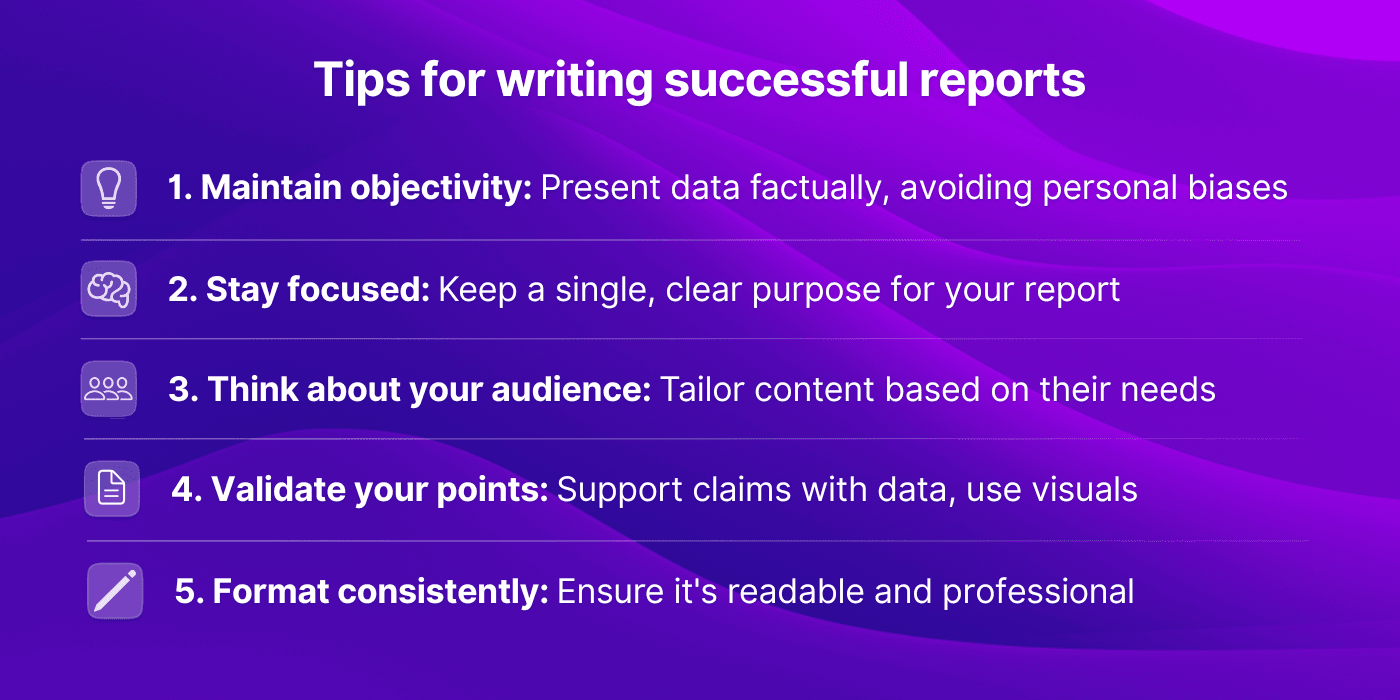
While the structure and purpose of reports may vary, certain principles apply universally to create successful documents. Here are five tips to elevate your report writing:
1. Maintain Objectivity
Your report should present data and facts as objectively as possible. Avoid letting personal biases influence the way you present information. Even when you're interpreting results or making recommendations, ensure that your conclusions are driven by the evidence at hand.
2. Stay Focused
Each report should have a single, clear purpose. Avoid going off on tangents or including irrelevant information. While it's important to provide context and background, don't lose sight of your report's main objective.
3. Think About Your Audience
Tailor your language, tone, and level of detail to the needs and understanding of your audience. A report written for experts in your field may use different language than one written for non-specialists. Always explain technical terms or industry jargon that your readers may not be familiar with.
4. Validate Your Points
Support every assertion you make with evidence or data. This adds credibility to your report and allows readers to understand the basis of your conclusions. Wherever possible, use graphics or visuals to illustrate your points—it’s a powerful way to represent data and ideas.

5. Format consistently
Consistency lends your report a professional look and helps readability. Stick to a consistent format in terms of font, spacing, heading styles, and captioning. Ensure your visuals are in sync with the rest of the document in terms of style and color scheme.
Reports are powerful communication tools, vital in various professional settings. The ability to write an effective report is a skill that can significantly enhance your impact in the workplace. From understanding what a report is, knowing the different types of reports, through to formatting and writing your report, the goal of this guide was to provide a comprehensive overview to help you excel in this critical skill.
By keeping the report’s purpose in mind, conducting thorough research, using a clear and concise writing style, and meticulously revising and proofreading your document, you can ensure your report not only communicates its intended information but does so in an engaging, digestible manner. Employing these strategies, combined with the tips offered, will help you create high-quality, impactful reports.
Make a report worth reading
Give Craft a try and discover how to bring your documents to life
More on reports
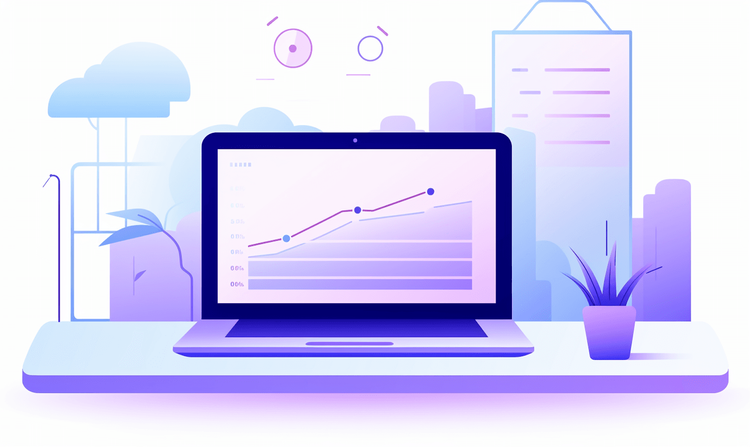
Ultimate Guide on How to Write a Report Tips and Sample

Defining a Report
A report is a type of writing that represents information, data, and research findings on a specific topic. The writer is expected to deliver a well-structured, credible, and informative text that dives into the small details of a certain topic, discussing its benefits and challenges.
Reports serve many important purposes. They provide recorded facts and findings. They are used to analyze data and draw insights that can be used for decision-making. Some reports serve as compliance checks to ensure that organizations meet certain standards and requirements. Also, reports are a formal way to communicate valuable information to decision-makers and stakeholders.
A report paper can be academic or about sales, science, business, etc. But unlike other texts, report writing takes much more than getting acquainted with the subject and forming an opinion about it. Report preparation is the most important stage of the writing process. Whether you are assigned to write an academic or a sales paper, before you start writing, you must do thorough research on the topic and ensure that every source of information is trustworthy.
Report writing has its rules. In this article, we will cover everything from how to start a report to how to format one. Below you will find a student research report sample. Check our paper writer service if you want one designed specifically for your requirements.
Student Research Report Sample
Before you read our article on how to write an act essay , see what an informative and well-structured report looks like. Below you will find a sample report that follows the format and tips we suggested in the article.
Explore and learn more about comprehensive but concise reports.
What are the Report Types
As mentioned, there are plenty of different types of report papers. Even though they are very formal, academic reports are only one of many people will come across in their lifetime. Some reports concentrate on the annual performance of a company, some on a project's progress, and others on scientific findings.
Next, we will elaborate more on different sorts of reports, their contents, and their purpose. Don't forget to also check out our report example that you can find below.

Academic Reports
An academic report represents supported data and information about a particular subject. This could be a historical event, a book, or a scientific finding. The credibility of such academic writing is very important as it, in the future, could be used as a backup for dissertations, essays, and other academic work.
Students are often assigned to write reports to test their understanding of a topic. They also provide evidence of the student's ability to critically analyze and synthesize information. It also demonstrates the student's writing skills and ability to simply convey complex findings and ideas.
Remember that the report outline will affect your final grade when writing an academic report. If you want to learn about the correct report writing format, keep reading the article. If you want to save time, you can always buy essays online .
Project Reports
Every project has numerous stakeholders who like to keep an eye on how things are going. This can be challenging if the number of people who need to be kept in the loop is high. One way to ensure everyone is updated and on the same page is periodic project reports.
Project managers are often assigned to make a report for people that affect the project's fate. It is a detailed document that summarizes the work done during the project and the work that needs to be completed. It informs about deadlines and helps form coherent expectations. Previous reports can be used as a reference point as the project progresses.
Sales Reports
Sales reports are excellent ways to keep your team updated on your sales strategies. It provides significant information to stakeholders, including managers, investors, and executives, so they can make informed decisions about the direction of their business.
A sales report usually provides information about a company's sales performance over a precise period. These reports include information about the revenue generated, the total number of units sold, and other metrics that help the company define the success of sales performance.
Sales report preparation is a meticulous job. To communicate information engagingly, you can put together graphs showing various information, including engagement increase, profit margins, and more.
Business Reports
If you were assigned a business report, something tells us you are wondering how to write a report for work. Let us tell you that the strategy is not much different from writing an academic report. A Strong thesis statement, compelling storytelling, credible sources, and correct format are all that matter.
Business reports can take many forms, such as marketing reports, operational reports, market research reports, feasible studies, and more. The purpose of such report writing is to provide analysis and recommendations to support decision-making and help shape a company's future strategy.
Most business reports include charts, graphs, and other visual aids that help illustrate key points and make complex information easy to digest.
Scientific Reports
Scientific reports present the results of scientific research or investigation to a specific audience. Unlike book reports, a scientific report is always reviewed by other experts in the field for its accuracy, quality, and relevance.
If you are a scientist or a science student, you can't escape writing a lab report. You will need to provide background information on the research topic and explain the study's purpose. A scientific report includes a discussion part where the researcher interprets the results and significance of the study.
Whether you are assigned to write medical reports or make a report about new findings in the field of physics, your writing should always have an introduction, methodology, results, conclusion, and references. These are the foundation of a well-written report.
Annual Reports
An annual report is a comprehensive piece of writing that provides information about a company's performance over a year. In its nature, it might remind us of extended financial reports.
Annual reports represent types of longer reports. They usually include an overview of a company's activities, a financial summary, detailed product and service information, and market conditions. But it's not just a report of the company's performance in the sales market, but also an overview of its social responsibility programs and sustainability activities.
The format of annual report writing depends on the company's specific requirements, the needs of its stakeholder, and the regulation of the country it's based.
Writing Reports Are Not Your Thing?
Our professional writers will get you any report type meeting your requirements in no time
Report Format
As we've seen throughout this article, various types of reports exist. And even though their content differs, they share one essential element: report writing format. Structure, research methods, grammar, and reference lists are equally important to different reports.
Keep in mind that while the general format is the same for every type, you still need to check the requirements of the assigned report before writing one. School reports, lab reports, and financial reports are three different types of the same category.
We are now moving on to discuss the general report format. Let's direct our attention to how to start a report.
Title : You need a comprehensive but concise title to set the right tone and make a good impression. It should be reflective of the general themes in the report.
Table of Contents : Your title page must be followed by a table of contents. We suggest writing an entire report first and creating a table of content later.
Summary : The table of contents should be followed by an executive report summary. To create a comprehensive summary, wait until you have finished writing the full report.
Introduction : A major part of the report structure is an introduction. Make sure you convey the main idea of the report in just a few words. The introduction section must also include a strong thesis statement.
Body : The central part of your work is called the report's body. Here you should present relevant information and provide supported evidence. Make sure every paragraph starts with a topic sentence. Here you can use bullet points, graphs, and other visual aids.
Conclusion : Use this part to summarize your findings and focus on the main elements and what they bring to the table. Do not introduce new ideas. Good report writing means knowing the difference between a summary and a conclusion.
Recommendations : A report is designed to help decision-makers or provide crucial information to the conversation, including a set of goals or steps that should be taken to further advance the progress.
Appendices : As a finishing touch, include a list of source materials on which you based the information and facts. If you want your report to get acknowledged, don't neglect this part of the report format.
How to Write a Report Like a PRO
Mastering the report writing format is only a fraction of the job. Writing an exceptional report takes more than just including a title page and references.
Next, we will offer report-writing tips to help you figure out how to write a report like a PRO. Meanwhile, if you need someone to review your physics homework, our physics helper is ready to take on the job.

Start With a Strong Thesis
A strong thesis is essential to a good paper because it sets the direction for the rest. It should provide a well-defined but short summary of the main points and arguments made in the report.
A strong thesis can help you collect your thoughts and ensure that the report has a course and a coherent structure. It will help you stay focused on key points and tie every paragraph into one entity.
A clear thesis will make your report writing sound more confident and persuasive. It will make finding supporting evidence easier, and you will be able to effectively communicate your ideas to the reader.
Use Simple Wording
Reports are there to gather and distribute as much information to as many people as possible. So, the content of it should be accessible and understandable for everyone, despite their knowledge in the field. We encourage you to use simple words instead of fancy ones when writing reports for large audiences.
Other academic papers might require you to showcase advanced language knowledge and extensive vocabulary. Still, formal reports should present information in a way that does not confuse.
If you are wondering how to make report that is easy to read and digest, try finding simpler alternatives to fancy words. For example, use 'example' instead of 'paradigm'; Use 'relevant' instead of 'pertinent'; 'Exacerbate' is a fancier way to say 'worsen,' and while it makes you look educated, it might cause confusion and make you lose the reader. Choose words that are easier to understand.
Present Only One Concept in Each Phrase
Make your reports easier to understand by presenting only one concept in each paragraph. Simple, short sentences save everyone's time and make complex concepts easier to digest and memorize.
Report writing is not a single-use material. It will be reread and re-used many times. Someone else might use your sales report to support their financial report. So, to avoid confusion and misinterpretation, start each paragraph with a topic sentence and tie everything else into this main theme.
Only Present Reliable Facts
You might have a strong hunch about future events or outcomes, but a research report is not a place to voice them. Everything you write should be supported by undisputed evidence.
Don't forget that one of the essential report preparation steps is conducting thorough research. Limit yourself to the information which is based on credible information. Only present relevant facts to the topic and add value to your thesis.
One of our report writing tips would be to write a rough draft and eliminate all the information not supported by reliable data. Double-check the credibility of the sources before finalizing the writing process.
Incorporate Bullet Points
When writing a research report, your goal is to make the information as consumable as possible. Don't shy away from using visual aids; this will only help you connect with a wider audience.
Bullet points are a great way to simplify the reading process and draw attention to the main concepts of the report. Use this technique in the body part of the report. If you notice that you are writing related information, use bullet points to point out their relation.
Incorporating bullet points and other visual aids in your report writing format will make a report easy to comprehend and use for further research.
While you are busy coming up with effective visual aids, you may not have enough time to take care of other assignments. Simply say, ' write my argumentative essay ,' and one of our expert writers will answer your prayer.
Review the Text for Accuracy and Inconsistencies
After completing report preparation and writing, ensure you don't skip the final stage. Even the greatest writers are not immune to grammatical mistakes and factual mix-ups.
Reviewing what you wrote is just as important as the research stage. Make sure there are no inconsistencies, and everything smoothly ties into the bigger scheme of events. Look out for spelling mistakes and word count.
If you want to further advance your writing skills, read our article about how to write a cover letter for essay .
Are You Looking for Help with Your Writing?
Our expert writers will provide top-notch assistance with any writing project
Related Articles
.webp)
- Directories
Report writing
Report writing is common in a number of disciplines. A report is a specific form of writing, written concisely and clearly and typically organised around identifying and examining issues, events, or findings from a research investigation.
Reports often involve investigating and analysing a problem and coming up with a solution. This means that you need to take a position or provide a solution and you need clear reasons for your solution.
A key, central message is a vital part of the report and will help to make it clear and persuasive.
A report might involve
- an analysis of existing data and literature
- conducting analysis and problem solving
- results of an investigation
Whatever the type of report, they are expected to be well written, clearly structured and expressed in a way that suits the particular audience. Results and analysis should be accurate, clear and objective. Report structures can vary between disciplines and audiences but the structure needs to support the key message.
Reports differ from essays in a number of ways. Consider the following:
Report writing process
It can be helpful to think of writing your report as a process and to break it down into the various tasks that you need to complete.
What goes on when you are writing a report? What are the various tasks you need to do to complete it?
There are three main phases:
The preparation phase where you analyse exactly what you are being asked to do and if you are working in a group, agree on the group communication plan.
The analysis phase where you gather all your evidence, conduct research, undertake investigations, complete coding, calculations etc
The analysis phase will enable you to come up with your key message - your answer to the question/solution to the problem. This key message will then determine the structure of your report and enable you to complete the writing phase of the report.
A note on group work
Reports are often written in groups, which present both rewards and challenges. The key to effective group work is effective communication and good planning. See our advice on group work for useful strategies to ensure a productive and fair group project.
Understanding the task >>
Understanding the task
Analysis and research
Writing the report
- ANU Library Academic Skills
- +61 2 6125 2972
- Skip to main content
- Skip to primary sidebar
- Skip to footer
- QuestionPro

- Solutions Industries Gaming Automotive Sports and events Education Government Travel & Hospitality Financial Services Healthcare Cannabis Technology Use Case NPS+ Communities Audience Contactless surveys Mobile LivePolls Member Experience GDPR Positive People Science 360 Feedback Surveys
- Resources Blog eBooks Survey Templates Case Studies Training Help center
Home Market Research
Research Reports: Definition and How to Write Them

Reports are usually spread across a vast horizon of topics but are focused on communicating information about a particular topic and a niche target market. The primary motive of research reports is to convey integral details about a study for marketers to consider while designing new strategies.
Certain events, facts, and other information based on incidents need to be relayed to the people in charge, and creating research reports is the most effective communication tool. Ideal research reports are extremely accurate in the offered information with a clear objective and conclusion. These reports should have a clean and structured format to relay information effectively.
What are Research Reports?
Research reports are recorded data prepared by researchers or statisticians after analyzing the information gathered by conducting organized research, typically in the form of surveys or qualitative methods .
A research report is a reliable source to recount details about a conducted research. It is most often considered to be a true testimony of all the work done to garner specificities of research.
The various sections of a research report are:
- Background/Introduction
- Implemented Methods
- Results based on Analysis
- Deliberation
Learn more: Quantitative Research
Components of Research Reports
Research is imperative for launching a new product/service or a new feature. The markets today are extremely volatile and competitive due to new entrants every day who may or may not provide effective products. An organization needs to make the right decisions at the right time to be relevant in such a market with updated products that suffice customer demands.
The details of a research report may change with the purpose of research but the main components of a report will remain constant. The research approach of the market researcher also influences the style of writing reports. Here are seven main components of a productive research report:
- Research Report Summary: The entire objective along with the overview of research are to be included in a summary which is a couple of paragraphs in length. All the multiple components of the research are explained in brief under the report summary. It should be interesting enough to capture all the key elements of the report.
- Research Introduction: There always is a primary goal that the researcher is trying to achieve through a report. In the introduction section, he/she can cover answers related to this goal and establish a thesis which will be included to strive and answer it in detail. This section should answer an integral question: “What is the current situation of the goal?”. After the research design was conducted, did the organization conclude the goal successfully or they are still a work in progress – provide such details in the introduction part of the research report.
- Research Methodology: This is the most important section of the report where all the important information lies. The readers can gain data for the topic along with analyzing the quality of provided content and the research can also be approved by other market researchers . Thus, this section needs to be highly informative with each aspect of research discussed in detail. Information needs to be expressed in chronological order according to its priority and importance. Researchers should include references in case they gained information from existing techniques.
- Research Results: A short description of the results along with calculations conducted to achieve the goal will form this section of results. Usually, the exposition after data analysis is carried out in the discussion part of the report.
Learn more: Quantitative Data
- Research Discussion: The results are discussed in extreme detail in this section along with a comparative analysis of reports that could probably exist in the same domain. Any abnormality uncovered during research will be deliberated in the discussion section. While writing research reports, the researcher will have to connect the dots on how the results will be applicable in the real world.
- Research References and Conclusion: Conclude all the research findings along with mentioning each and every author, article or any content piece from where references were taken.
Learn more: Qualitative Observation
15 Tips for Writing Research Reports
Writing research reports in the manner can lead to all the efforts going down the drain. Here are 15 tips for writing impactful research reports:
- Prepare the context before starting to write and start from the basics: This was always taught to us in school – be well-prepared before taking a plunge into new topics. The order of survey questions might not be the ideal or most effective order for writing research reports. The idea is to start with a broader topic and work towards a more specific one and focus on a conclusion or support, which a research should support with the facts. The most difficult thing to do in reporting, without a doubt is to start. Start with the title, the introduction, then document the first discoveries and continue from that. Once the marketers have the information well documented, they can write a general conclusion.
- Keep the target audience in mind while selecting a format that is clear, logical and obvious to them: Will the research reports be presented to decision makers or other researchers? What are the general perceptions around that topic? This requires more care and diligence. A researcher will need a significant amount of information to start writing the research report. Be consistent with the wording, the numbering of the annexes and so on. Follow the approved format of the company for the delivery of research reports and demonstrate the integrity of the project with the objectives of the company.
- Have a clear research objective: A researcher should read the entire proposal again, and make sure that the data they provide contributes to the objectives that were raised from the beginning. Remember that speculations are for conversations, not for research reports, if a researcher speculates, they directly question their own research.
- Establish a working model: Each study must have an internal logic, which will have to be established in the report and in the evidence. The researchers’ worst nightmare is to be required to write research reports and realize that key questions were not included.
Learn more: Quantitative Observation
- Gather all the information about the research topic. Who are the competitors of our customers? Talk to other researchers who have studied the subject of research, know the language of the industry. Misuse of the terms can discourage the readers of research reports from reading further.
- Read aloud while writing. While reading the report, if the researcher hears something inappropriate, for example, if they stumble over the words when reading them, surely the reader will too. If the researcher can’t put an idea in a single sentence, then it is very long and they must change it so that the idea is clear to everyone.
- Check grammar and spelling. Without a doubt, good practices help to understand the report. Use verbs in the present tense. Consider using the present tense, which makes the results sound more immediate. Find new words and other ways of saying things. Have fun with the language whenever possible.
- Discuss only the discoveries that are significant. If some data are not really significant, do not mention them. Remember that not everything is truly important or essential within research reports.
Learn more: Qualitative Data
- Try and stick to the survey questions. For example, do not say that the people surveyed “were worried” about an research issue , when there are different degrees of concern.
- The graphs must be clear enough so that they understand themselves. Do not let graphs lead the reader to make mistakes: give them a title, include the indications, the size of the sample, and the correct wording of the question.
- Be clear with messages. A researcher should always write every section of the report with an accuracy of details and language.
- Be creative with titles – Particularly in segmentation studies choose names “that give life to research”. Such names can survive for a long time after the initial investigation.
- Create an effective conclusion: The conclusion in the research reports is the most difficult to write, but it is an incredible opportunity to excel. Make a precise summary. Sometimes it helps to start the conclusion with something specific, then it describes the most important part of the study, and finally, it provides the implications of the conclusions.
- Get a couple more pair of eyes to read the report. Writers have trouble detecting their own mistakes. But they are responsible for what is presented. Ensure it has been approved by colleagues or friends before sending the find draft out.
Learn more: Market Research and Analysis
MORE LIKE THIS

Customer Experience Automation: Benefits and Best Tools
Apr 1, 2024

7 Best Market Segmentation Tools in 2024

In-App Feedback Tools: How to Collect, Uses & 14 Best Tools
Mar 29, 2024

11 Best Customer Journey Analytics Software in 2024
Other categories.
- Academic Research
- Artificial Intelligence
- Assessments
- Brand Awareness
- Case Studies
- Communities
- Consumer Insights
- Customer effort score
- Customer Engagement
- Customer Experience
- Customer Loyalty
- Customer Research
- Customer Satisfaction
- Employee Benefits
- Employee Engagement
- Employee Retention
- Friday Five
- General Data Protection Regulation
- Insights Hub
- Life@QuestionPro
- Market Research
- Mobile diaries
- Mobile Surveys
- New Features
- Online Communities
- Question Types
- Questionnaire
- QuestionPro Products
- Release Notes
- Research Tools and Apps
- Revenue at Risk
- Survey Templates
- Training Tips
- Uncategorized
- Video Learning Series
- What’s Coming Up
- Workforce Intelligence
What Are Business and Technical Reports?
Morsa Images/Getty Images
- An Introduction to Punctuation
- Ph.D., Rhetoric and English, University of Georgia
- M.A., Modern English and American Literature, University of Leicester
- B.A., English, State University of New York
A report is a document that presents information in an organized format for a specific audience and purpose . Although summaries of reports may be delivered orally, complete reports are almost always in the form of written documents.
In "Contemporary Business Reports," Kuiper and Clippinger define business reports as "organized, objective presentations of observations, experiences, or facts used in the decision-making process."
Sharma and Mohan, in their book "Business Correspondence and Report Writing," define a technical report as "a written statement of the facts of a situation, project, process or test; how these facts were ascertained; their significance; the conclusions that have been drawn from them; and [in some cases] the recommendations that are being made."
Types of reports include memos , minutes, lab reports, book reports , progress reports, justification reports, compliance reports, annual reports, and policies and procedures.
Purpose of Business and Technical Reports
In "Business Communication: A Framework for Success," H. Dan O'Hair, James S. O'Rourke, and Mary John O'Hair, explain the four primary purposes of business reports.
"Reports can fulfill four different, and sometimes related, functions. They can be used as controls to ensure that all departments are functioning properly, to give information, to provide an analysis, and to persuade others to act."
Characteristics of Effective Reports
In "Contemporary Business Reports," Shirley Kuiper and Dorinda Clippinger provide insight into effective business communications.
"Effective reports are understood by the reader as the writer intended, and they influence the reader to act as the writer desired. The writer's objectives are most likely to be achieved if they correspond with the needs and objectives of the reader. An effective report is empathetic, accurate, complete, concise , and clear . Above all, an effective report presents information ethically."
Connecting With Your Audience
Warren Buffet, in the Foreword to " A Plain English Handbook ", shares his advice on how to best communicate in business reports.
"One unoriginal but useful tip: Write with a specific person in mind. When writing Berkshire Hathaway's annual report, I pretend that I'm talking to my sisters. I have no trouble picturing them: though highly intelligent they are not experts in accounting or finance. They will understand plain English , but jargon may puzzle them. My goal is simply to give them the information I would wish them to supply me if our positions were reversed. To succeed, I don't need to be Shakespeare; I must, though, have a sincere desire to inform."
Business Reports Can Be Long or Short
As described by John M. Lannon in "Technical Communication," along with the length of reports, the purpose and scope of reports differ.
"In the professional world, decision-makers rely on two broad types of reports: Some reports focus primarily on information ('what we're doing now,' 'what we did last month,' 'what our customer survey found,' 'what went on at the department meeting'). But beyond merely providing information, many reports also include analysis ('what this information means for us,' 'what courses of action should be considered,' 'what we recommend, and why')."
"For every long (formal) report, countless short (informal) reports lead to informed decisions on matters as diverse as the most comfortable office chairs to buy to the best recruit to hire for management training. Unlike long reports, most short reports require no extended planning, are quickly prepared, contain little or no background information, and have no front or end matter (title page, table of contents, glossary, etc). But despite their conciseness , short reports do provide the information and analysis that readers need."
- Kuiper, Shirley, and Dorinda A. Clippinger. Contemporary Business Reports. 5th ed., South-Western, Cengage Learning, 2013.
- Lannon, John M., and Laura J. Gurak. Technical Communication. 14th ed., Pearson, January 14, 2017.
- A Plain English Handbook - How to Create Clear SEC Disclosure Documents. Office of Investor Education and Assistance., Aug. 1998, b-ok.cc/book/2657251/448dd1.
- O'Hair, Dan, et al. Business Communication: a Framework for Success. South-Western College Publishing, 2000.
- Sharma, R. C., and Krishna Mohan. Business Correspondence and Report Writing: a Practical Approach to Business & Technical Communication . Tata McGraw-Hill, 2017.
- Definition and Examples of Plain English
- Best Practices for Business Writing
- How to Write a Business Report for English Learners
- What Is Proposal Writing?
- Business Writing: Claim Letters
- Effective Bad-News Messages in Business Writing
- What Is Expository Writing?
- Business Writing Resources
- Understanding General-to-Specific Order in Composition
- How to Write an Abstract
- Development in Composition: Building an Essay
- Writer Purpose in Rhetoric and Composition
- Audience Analysis in Speech and Composition
- Paragraph Length in Compositions and Reports
- How to Format and Write a Simple Business Letter
- What Is a Memorandum? Definition and Examples

Report Writing And Its Significance In Your Career
You reach the office at around 9.00 AM, switch on your system, and start working. It’s a usual workday for…

You reach the office at around 9.00 AM, switch on your system, and start working. It’s a usual workday for you until your manager comes to your desk and asks you to create a sales report. That’s the first time you’ve got such a task, and find yourself struggling with basic questions such as, “What’s a report?” and “How do I write one?”
What Is Report Writing?
Elements of report writing, importance of report writing.
You must have heard the term ‘report writing’ before.
According to the commonly known definition of report writing, a report is a formal document that elaborates on a topic using facts, charts, and graphs to support its arguments and findings.
Any report—whether it’s about a business event or one that describes the processes of various departments in a company—is meant for a particular type of audience.
But why do you think your manager wants you to create a report?
One simple answer is: an elaborate report prepared with evaluated facts helps solve complex problems. When managers come across certain business situations, they ask for comprehensive and well-thought-out reports that can help them design business plans.
Once you have an idea about what a report is, the next step is to understand how you can write one.
There are different types of reports, and each has a specific structure, usually known as ‘elements of the report’.
While we tell you what the elements of report writing are, if you want detailed guidance, you can go for Harappa Education’s Writing Proficiently course that talks about the popular PREP (Point of starting, Reason, Evidence, and Point of ending) model of report writing.
Every report starts with a title page and a table of contents, after which come the main sections–the executive summary, introduction, discussion, and conclusion.
Executive Summary:
Do you remember summary writing for English class during school days? You were asked to read a story or passage and write a summary, including the important takeaways. ( ambien )
That’s exactly what you are expected to do in a report’s executive summary section. This section presents a brief overview of the report’s contents. You should present the key points of the report in this section.
But why is it important to write an executive summary at the start of the report?
Firstly, the summary will help readers better understand the purpose, key points, and evidence you are going to present in the report. Secondly, readers who are in a hurry can read the summary for a preview of the report.
Here are some specifics that will help you write a clear and concise summary:
Include the purpose of your report and emphasize conclusions or recommendations.
Include only the essential or most significant information to support your theories and conclusions.
Follow the same sequence of information that you have used in the report.
Keep the summary length to 10-15% of the complete report.
Try not to introduce any new information or point in summary that you haven’t covered in the report.
The summary should communicate the message clearly and independently.
Introduction:
The introduction section should:
Briefly describe the background and context of the research you have done.
Describe the change, problem, or issue related to the topic.
Define the relevant objectives and purpose of the report
Give hints about the overall answer to the problem covered in the report.
Comment on the limitations and any assumptions you have made to get to the conclusion.
Discussion:
This section serves two purposes:
It justifies the recommendations.
It explains the conclusions.
While you are writing the discussion section, make sure you do the following:
Present your analysis logically.
If needed, divide the information under appropriate headings to improving readability and ease of understanding.
Explain your points and back up your claims with strong and evaluated evidence.
Connect your theory with real-life scenarios
Conclusion:
The last key element of report writing is the conclusion section. Present the conclusion as follows:
- The primary conclusion should come first.
Identify and interpret the major problems related to the case your report is based on.
Relate to the objectives that you have mentioned in the introduction.
Keep the conclusion brief and specific.
Before you start writing a report, it’s important to understand the significance of the report. It’s also crucial to research independently instead of relying on data and trends available on the internet, besides structuring the report properly. Here’s why:
Decision-Making Tool
Organizations require a considerable amount of data and information on specific topics, scenarios, and situations. Managers and decision-makers often use business reports and research papers as information sources to make important business decisions and reach solutions.
Another reason that adds to the significance of report writing is that it is a collection of evaluated information.
Different types of activities by different departments define an organization. Think of the departments your organization has–development, sales, distribution, marketing, HR, and more. Each department follows defined processes and protocols that require many small and large activities on a daily basis.
It is impossible for the management to keep an eye on the different activities in each department.
That’s where the reports can help. With every department writing and maintaining periodic reports, keeping a tab of ongoing activities becomes easier for the management.
Professional Improvements
During the annual appraisal cycle, your manager will ask you to write reports to explain your position, level of work, and performance.
If you have ever wondered how your manager decided to promote your colleague and not you, the answer may lie in his well-presented report.
Quick Source For Problem-Solving
There’s no denying that managers require accurate information on various topics to make quick decisions. Often due to urgency, managers only rely on business reports as an authentic source of information. Almost every employee would have witnessed a situation that needed the manager’s attention urgently. Reports come in handy during such situations.
Report writing is a significant exercise in many ways for your professional life. If you are not well-versed with it already, you must start working on your report writing skills now. For more help or guidance to learn this new skill, sign up for Harappa’s Writing Proficiently course.
Make the most of your time at home and master this new skill. Work on many assignments, improve your skills, and become a pro at report writing.
Explore our Harappa Diaries section to learn more about topics related to the Communicate habit such as the Importance of Writing Skills and the Cycle of Communication .

- Research Report: Definition, Types + [Writing Guide]

One of the reasons for carrying out research is to add to the existing body of knowledge. Therefore, when conducting research, you need to document your processes and findings in a research report.
With a research report, it is easy to outline the findings of your systematic investigation and any gaps needing further inquiry. Knowing how to create a detailed research report will prove useful when you need to conduct research.
What is a Research Report?
A research report is a well-crafted document that outlines the processes, data, and findings of a systematic investigation. It is an important document that serves as a first-hand account of the research process, and it is typically considered an objective and accurate source of information.
In many ways, a research report can be considered as a summary of the research process that clearly highlights findings, recommendations, and other important details. Reading a well-written research report should provide you with all the information you need about the core areas of the research process.
Features of a Research Report
So how do you recognize a research report when you see one? Here are some of the basic features that define a research report.
- It is a detailed presentation of research processes and findings, and it usually includes tables and graphs.
- It is written in a formal language.
- A research report is usually written in the third person.
- It is informative and based on first-hand verifiable information.
- It is formally structured with headings, sections, and bullet points.
- It always includes recommendations for future actions.
Types of Research Report
The research report is classified based on two things; nature of research and target audience.
Nature of Research
- Qualitative Research Report
This is the type of report written for qualitative research . It outlines the methods, processes, and findings of a qualitative method of systematic investigation. In educational research, a qualitative research report provides an opportunity for one to apply his or her knowledge and develop skills in planning and executing qualitative research projects.
A qualitative research report is usually descriptive in nature. Hence, in addition to presenting details of the research process, you must also create a descriptive narrative of the information.
- Quantitative Research Report
A quantitative research report is a type of research report that is written for quantitative research. Quantitative research is a type of systematic investigation that pays attention to numerical or statistical values in a bid to find answers to research questions.
In this type of research report, the researcher presents quantitative data to support the research process and findings. Unlike a qualitative research report that is mainly descriptive, a quantitative research report works with numbers; that is, it is numerical in nature.
Target Audience
Also, a research report can be said to be technical or popular based on the target audience. If you’re dealing with a general audience, you would need to present a popular research report, and if you’re dealing with a specialized audience, you would submit a technical report.
- Technical Research Report
A technical research report is a detailed document that you present after carrying out industry-based research. This report is highly specialized because it provides information for a technical audience; that is, individuals with above-average knowledge in the field of study.
In a technical research report, the researcher is expected to provide specific information about the research process, including statistical analyses and sampling methods. Also, the use of language is highly specialized and filled with jargon.
Examples of technical research reports include legal and medical research reports.
- Popular Research Report
A popular research report is one for a general audience; that is, for individuals who do not necessarily have any knowledge in the field of study. A popular research report aims to make information accessible to everyone.
It is written in very simple language, which makes it easy to understand the findings and recommendations. Examples of popular research reports are the information contained in newspapers and magazines.
Importance of a Research Report
- Knowledge Transfer: As already stated above, one of the reasons for carrying out research is to contribute to the existing body of knowledge, and this is made possible with a research report. A research report serves as a means to effectively communicate the findings of a systematic investigation to all and sundry.
- Identification of Knowledge Gaps: With a research report, you’d be able to identify knowledge gaps for further inquiry. A research report shows what has been done while hinting at other areas needing systematic investigation.
- In market research, a research report would help you understand the market needs and peculiarities at a glance.
- A research report allows you to present information in a precise and concise manner.
- It is time-efficient and practical because, in a research report, you do not have to spend time detailing the findings of your research work in person. You can easily send out the report via email and have stakeholders look at it.
Guide to Writing a Research Report
A lot of detail goes into writing a research report, and getting familiar with the different requirements would help you create the ideal research report. A research report is usually broken down into multiple sections, which allows for a concise presentation of information.
Structure and Example of a Research Report
This is the title of your systematic investigation. Your title should be concise and point to the aims, objectives, and findings of a research report.
- Table of Contents
This is like a compass that makes it easier for readers to navigate the research report.
An abstract is an overview that highlights all important aspects of the research including the research method, data collection process, and research findings. Think of an abstract as a summary of your research report that presents pertinent information in a concise manner.
An abstract is always brief; typically 100-150 words and goes straight to the point. The focus of your research abstract should be the 5Ws and 1H format – What, Where, Why, When, Who and How.
- Introduction
Here, the researcher highlights the aims and objectives of the systematic investigation as well as the problem which the systematic investigation sets out to solve. When writing the report introduction, it is also essential to indicate whether the purposes of the research were achieved or would require more work.
In the introduction section, the researcher specifies the research problem and also outlines the significance of the systematic investigation. Also, the researcher is expected to outline any jargons and terminologies that are contained in the research.
- Literature Review
A literature review is a written survey of existing knowledge in the field of study. In other words, it is the section where you provide an overview and analysis of different research works that are relevant to your systematic investigation.
It highlights existing research knowledge and areas needing further investigation, which your research has sought to fill. At this stage, you can also hint at your research hypothesis and its possible implications for the existing body of knowledge in your field of study.
- An Account of Investigation
This is a detailed account of the research process, including the methodology, sample, and research subjects. Here, you are expected to provide in-depth information on the research process including the data collection and analysis procedures.
In a quantitative research report, you’d need to provide information surveys, questionnaires and other quantitative data collection methods used in your research. In a qualitative research report, you are expected to describe the qualitative data collection methods used in your research including interviews and focus groups.
In this section, you are expected to present the results of the systematic investigation.
This section further explains the findings of the research, earlier outlined. Here, you are expected to present a justification for each outcome and show whether the results are in line with your hypotheses or if other research studies have come up with similar results.
- Conclusions
This is a summary of all the information in the report. It also outlines the significance of the entire study.
- References and Appendices
This section contains a list of all the primary and secondary research sources.
Tips for Writing a Research Report
- Define the Context for the Report
As is obtainable when writing an essay, defining the context for your research report would help you create a detailed yet concise document. This is why you need to create an outline before writing so that you do not miss out on anything.
- Define your Audience
Writing with your audience in mind is essential as it determines the tone of the report. If you’re writing for a general audience, you would want to present the information in a simple and relatable manner. For a specialized audience, you would need to make use of technical and field-specific terms.
- Include Significant Findings
The idea of a research report is to present some sort of abridged version of your systematic investigation. In your report, you should exclude irrelevant information while highlighting only important data and findings.
- Include Illustrations
Your research report should include illustrations and other visual representations of your data. Graphs, pie charts, and relevant images lend additional credibility to your systematic investigation.
- Choose the Right Title
A good research report title is brief, precise, and contains keywords from your research. It should provide a clear idea of your systematic investigation so that readers can grasp the entire focus of your research from the title.
- Proofread the Report
Before publishing the document, ensure that you give it a second look to authenticate the information. If you can, get someone else to go through the report, too, and you can also run it through proofreading and editing software.
How to Gather Research Data for Your Report
- Understand the Problem
Every research aims at solving a specific problem or set of problems, and this should be at the back of your mind when writing your research report. Understanding the problem would help you to filter the information you have and include only important data in your report.
- Know what your report seeks to achieve
This is somewhat similar to the point above because, in some way, the aim of your research report is intertwined with the objectives of your systematic investigation. Identifying the primary purpose of writing a research report would help you to identify and present the required information accordingly.
- Identify your audience
Knowing your target audience plays a crucial role in data collection for a research report. If your research report is specifically for an organization, you would want to present industry-specific information or show how the research findings are relevant to the work that the company does.
- Create Surveys/Questionnaires
A survey is a research method that is used to gather data from a specific group of people through a set of questions. It can be either quantitative or qualitative.
A survey is usually made up of structured questions, and it can be administered online or offline. However, an online survey is a more effective method of research data collection because it helps you save time and gather data with ease.
You can seamlessly create an online questionnaire for your research on Formplus . With the multiple sharing options available in the builder, you would be able to administer your survey to respondents in little or no time.
Formplus also has a report summary too l that you can use to create custom visual reports for your research.
Step-by-step guide on how to create an online questionnaire using Formplus
- Sign into Formplus
In the Formplus builder, you can easily create different online questionnaires for your research by dragging and dropping preferred fields into your form. To access the Formplus builder, you will need to create an account on Formplus.
Once you do this, sign in to your account and click on Create new form to begin.
- Edit Form Title : Click on the field provided to input your form title, for example, “Research Questionnaire.”
- Edit Form : Click on the edit icon to edit the form.
- Add Fields : Drag and drop preferred form fields into your form in the Formplus builder inputs column. There are several field input options for questionnaires in the Formplus builder.
- Edit fields
- Click on “Save”
- Form Customization: With the form customization options in the form builder, you can easily change the outlook of your form and make it more unique and personalized. Formplus allows you to change your form theme, add background images, and even change the font according to your needs.
- Multiple Sharing Options: Formplus offers various form-sharing options, which enables you to share your questionnaire with respondents easily. You can use the direct social media sharing buttons to share your form link to your organization’s social media pages. You can also send out your survey form as email invitations to your research subjects too. If you wish, you can share your form’s QR code or embed it on your organization’s website for easy access.
Conclusion
Always remember that a research report is just as important as the actual systematic investigation because it plays a vital role in communicating research findings to everyone else. This is why you must take care to create a concise document summarizing the process of conducting any research.
In this article, we’ve outlined essential tips to help you create a research report. When writing your report, you should always have the audience at the back of your mind, as this would set the tone for the document.

Connect to Formplus, Get Started Now - It's Free!
- ethnographic research survey
- research report
- research report survey
- busayo.longe

You may also like:
21 Chrome Extensions for Academic Researchers in 2022
In this article, we will discuss a number of chrome extensions you can use to make your research process even seamless

Assessment Tools: Types, Examples & Importance
In this article, you’ll learn about different assessment tools to help you evaluate performance in various contexts
Ethnographic Research: Types, Methods + [Question Examples]
Simple guide on ethnographic research, it types, methods, examples and advantages. Also highlights how to conduct an ethnographic...
How to Write a Problem Statement for your Research
Learn how to write problem statements before commencing any research effort. Learn about its structure and explore examples
Formplus - For Seamless Data Collection
Collect data the right way with a versatile data collection tool. try formplus and transform your work productivity today..
How to Write a Business Report: A Step By Step Guide with Examples

Table of contents
With so much experience under your belt, you already know a lot about business reporting.
So, we don’t want to waste your time pointing out the obvious because we know what you need.
Secrets. Tricks. Best practices.
The answer to how to write a mind-blowing business report that you don’t need to spend hours and days writing.
A business report that will immediately allow you to identify your strengths and weaknesses.
A report that’ll help you learn more about your business and do more accurate forecasting and planning for the future.
We believe we have just that right here.
With this comprehensive guide, you’ll create effective sales, analytical, and informative business reports (and business dashboards ) that will help you improve your strategies, achieve your goals, and grow your business.
So, let’s dive in.
What Is a Business Report?
Importance of creating business reports, types of business reports, what should be included in a business report, how to write a business report: an 11-step guide.
- Business Report Examples
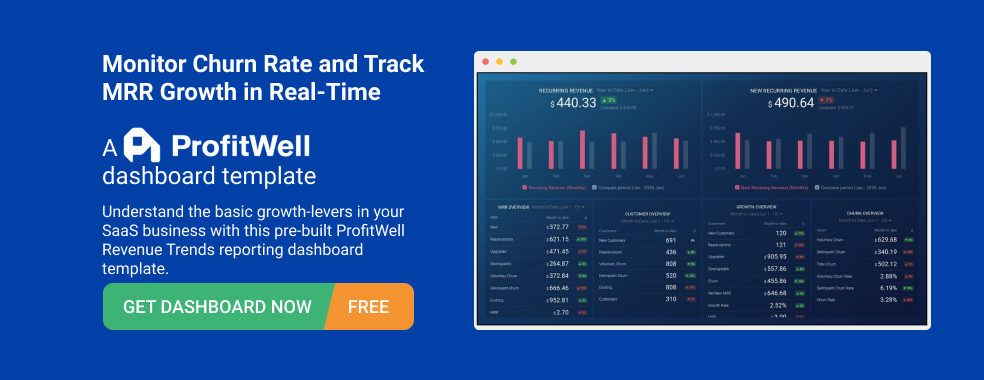
Although there’s a variety of business reports that differ in many aspects, in short, a business report definition would be the following:
A business report is an informative document that contains important data such as facts, analyses, research findings, and statistics about a business with the goal to make this information accessible to people within a company.
Their main purpose is to facilitate the decision-making process related to the future of the business, as well as to maintain effective communication between people who create the reports and those they report to.
A good business report is concise and well-organized, looks professional, and displays the relevant data you can act on. The point is to reflect upon what you’ve achieved so far (typically, over the past month, quarter or year) and to use the data to create a new strategy or adjust the current one to reach even more business goals.
Business reports should be objective and based on the data. When stating the facts, people rely on numbers rather than giving descriptions. For instance, instead of saying “our conversion rate skyrocketed”, you would display the exact percentages that back up that claim.
Business reporting matters for several reasons, among which the most important ones are:
Recognizing Opportunities to Grow
Detecting issues and solving them quickly, evaluating a potential partner, having a paper trail, keeping things transparent for the stakeholders, setting new company goals.
In fact, over half of the companies that contributed to Databox’s state of business reporting research confirmed that regular monitoring and reporting brought them significant concrete benefits.
If you never look back at what you’ve achieved, you can’t figure out what you’ve done well and what you can leverage in the future for even better results.
When you analyze a specific aspect of your business over a specific time period and present the data you gathered in a report, you can detect an opportunity to grow more easily because you have all the information in one place and organized neatly.
Is it time to introduce new products or services? Is there a way to enhance your marketing strategy? Prepare a report. Can you optimize your finances? Write a financial business report . Whatever decision you need to make, it’s easier when you base it on a report.
Reports are essential for crisis management because they can introduce a sense of calmness into your team. Putting everything on paper makes it easier to encompass all the relevant information and when you know all the facts, you can make a more accurate and effective decision about what to do next.
Writing business reports regularly will also help you identify potential issues or risks and act timely to prevent damage and stop it from escalating. That’s why monthly reporting is better than doing it only once a year.
Having an insight into your finances , operations and other business aspects more regularly allows you to have better control over them and mitigate potential risks more effectively.
Different types of business reports may be accessible to the general public. And if they’re not, specific situations may require a company to send them over to the person requesting them. That may happen if you’re considering a partnership with another company. Before making the final decision, you should learn about their financial health as every partnership poses a certain risk for your finances and/or reputation. Will this decision be profitable?
Having an insight into a company’s business report helps you establish vital business relationships. And it goes the other way around – any potential partner can request that you pull a business report for them to see, so writing business reports can help you prove you’re a suitable business partner.
In business, and especially in large companies, it’s easy to misplace information when it’s communicated verbally. Having a written report about any aspect of your business doesn’t only prevent you from losing important data, but it also helps you keep records so you can return to them at any given moment and use them in the future.
That’s why it’s always good to have a paper trail of anything important you want to share with colleagues, managers, clients, or investors. Nowadays, of course, it doesn’t have to literally be a paper trail, since we keep the data in electronic form.
Writing business reports helps you keep things transparent for the stakeholders, which is the foundation of efficient communication between these two sides.
You typically need to report to different people – sometimes they’re your managers, sometimes they’re a client. But your company’s stakeholders will also require an insight into the performance of your business, and relying on reports will help you maintain favorable business relationships. A business report shows you clearly how your company is performing and there isn’t room for manipulation.
Once you set business goals and the KPIs that help you track your progress towards them, you should remember they’re not set in stone. From time to time, you’ll need to revisit your goals and critical metrics and determine whether they’re still relevant.
When you write a business report and go through it with your team members or managers, you have a chance to do just that and determine if you’re efficient in reaching your goals. Sometimes, new insights will come up while writing these reports and help you identify new objectives that may have emerged.
Depending on your goals and needs, you’ll be writing different types of business reports. Here are five basic types of business reports .
Informational Report
Analytical report, research report, explanatory report, progress report.
Informational reports provide you with strictly objective data without getting into the details, such as explaining why something happened or what the result may be – just pure facts.
An example of this type of business report is a statement where you describe a department within your company: the report contains the list of people working in this department, what their titles are, and what they’re responsible for.
Another example related to a company’s website could look like this Google Analytics website traffic engagement report . As we explained above, this report shows objective data without getting too much into the details, so in this case, just the most important website engagement metrics such as average session duration, bounce rate, sessions, sessions by channel, and so on. Overall, you can use this report to monitor your website traffic, see which keywords are most successful, or how many returning users you have, but without further, in-depth analysis.

Analytical reports help you understand the data you’ve collected and plan for the future based on these insights. You can’t make business decisions based on facts only, so analytical reports are crucial for the decision-making process.
This type of business report is commonly used for sales forecasting. For instance, if you write a report where you identify a drop or an increase in sales, you’ll want to find out why it happened. This HubSpot’s sales analytics report is a good example of what metrics should be included in such a report, like average revenue per new client or average time to close the deal. You can find more web analytics dashboard examples here.
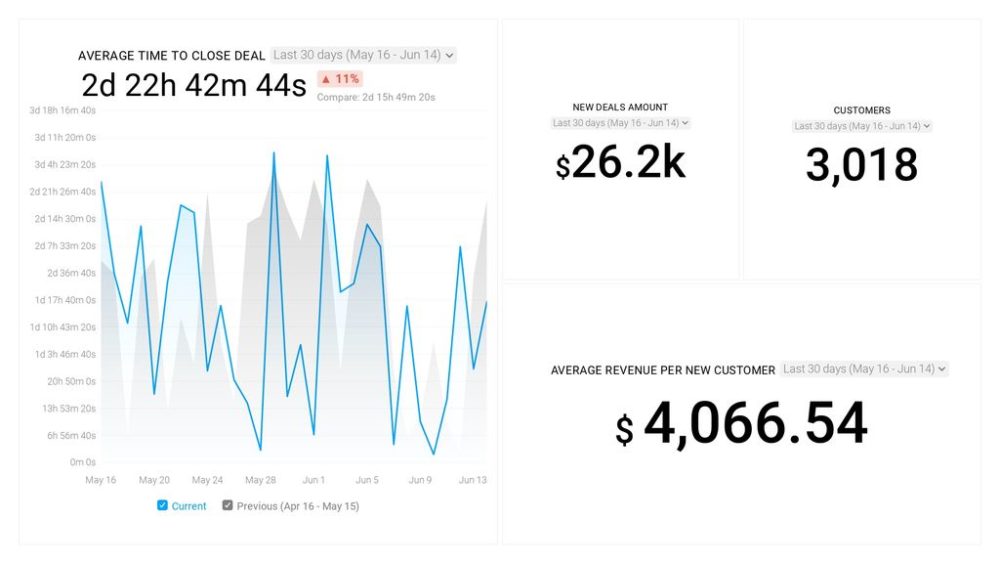
From these business reports, you can find out if you will reach your goals by implementing your current strategy or if you need to make adjustments.
Research is critical when you’re about to introduce a change to your business. Whether it’s a new strategy or a new partner, you need an extensive report to have an overview of all important details. These reports usually analyze new target markets and competition, and contain a lot of statistical data.
While not the same, here is an example of an ecommerce dashboard that could help track each part of a campaign in detail, no matter whether you are launching a new product, testing a new strategy, and similar. Similar to a research report, it contains key data on your audience (target market), shows your top-selling products, conversion rate and more. If you are an online store owner who is using paid ads, you can rely on this report to monitor key online sales stats in line with Facebook Ads and Google Analytics. See more ecommerce dashboards here.

As you might guess from its name, you write the explanatory report when it’s necessary for you to explain a specific situation or a project you’ve done to your team members. It’s important to write this report in a way that everyone will be able to understand.
Explanatory reports include elements like research results, reasons and goals of the research, facts, methodology, and more. While not exactly an explanatory report, this example of a HubSpot marketing drilldown report is the closest thing to it, as it helps marketers drill into an individual landing page performance, and identify how good their best landing pages are at converting, or which ones have the best performance.

A progress report is actually an update for your manager or client – it informs them about where you stand at the moment and how things are going. It’s like a checkpoint on your way towards your goal.
These reports may be the least demanding to write since you don’t need to do comprehensive research before submitting them. You just need to sum up your progress up to the point when the report was requested. This business report may include your current results, the strategy you’re implementing, the obstacles you’ve come across, etc. If this is a marketing progress report you can use marketing report templates to provide a more comprehensive overview.
In many companies, progress reports are done on a weekly or even daily basis. Here is an example of a daily sales report from Databox. HubSpot users can rely on this sales rep drilldown business report to see how individual each sales rep is performing and measure performance against goals. Browse through all our KPI dashboards here.

What does a great business report look like? If you’re not sure what sections your report should have, you’ll learn what to include in the following lines.
Business Report Formatting
Different types of reports require different lengths and structures, so your business report format may depend on what elements your report needs to have. For example, progress reports are typically pretty simple, while analytical or explanatory reports are a different story.
However, most reports will start with a title and a table of contents, so the person reading the report knows what to expect. Then, add a summary and move on to the introduction. After you’ve written the body and the conclusion, don’t forget to include suggestions based on your findings that will help your team create an actionable plan as you move forward.
After that, list the references you used while creating the report, and attach any additional documents or images that can help the person reading the report understand it better.
This outline may vary depending on what kind of report you’re writing. Short business reports may not need a table of contents, and informative reports won’t contain any analyses. Also, less formal reports don’t need to follow a strict structure in every situation.
Business Report Contents
When it comes to the contents of your report, keep in mind the person who’s going to read it and try to balance between including all the relevant information, but not overwhelming the reader with too many details.
- The introduction to the report should state the reason why you’re writing it, and what its main goal is. Also, mention what methodology and reporting software you’ve used, if applicable.
- The body of the report is where you’ll expose all your key findings, explain your methodology, share the important data and statistics, and present your results and conclusion.
- The conclusion , similarly to the summary you’ll add at the beginning of the report, briefly singles out the most important points and findings of the report.
If you decide to include more sections like recommendations, this is where you’ll suggest the next steps your team or the company may want to take to improve the results or take advantage of them if they’re favorable.
PRO TIP: Are You Tracking the Right Metrics for Your SaaS Company?
As a SaaS business leader, there’s no shortage of metrics you could be monitoring, but the real question is, which metrics should you be paying most attention to? To monitor the health of your SaaS business, you want to identify any obstacles to growth and determine which elements of your growth strategy require improvements. To do that, you can track the following key metrics in a convenient dashboard with data from Profitwell:
- Recurring Revenue. See the portion of your company’s revenue that is expected to grow month-over-month.
- MRR overview. View the different contributions to and losses from MRR from different kinds of customer engagements.
- Customer overview . View the total number of clients your company has at any given point in time and the gains and losses from different customer transactions.
- Growth Overview . Summarize all of the different kinds of customer transactions and their impact on revenue growth.
- Churn overview. Measure the number and percentage of customers or subscribers you lost during a given time period.
If you want to track these in ProfitWell, you can do it easily by building a plug-and-play dashboard that takes your customer data from ProfitWell and automatically visualizes the right metrics to allow you to monitor your SaaS revenue performance at a glance.

You can easily set it up in just a few clicks – no coding required.
To set up the dashboard, follow these 3 simple steps:
Step 1: Get the template
Step 2: Connect your Profitwell account with Databox.
Step 3: Watch your dashboard populate in seconds.
Note : Other than text, make sure you include images, graphs, charts, and tables. These elements will make your report more readable and illustrate your points.
Whether you’re writing a specific type of business report for the first time or you simply want to improve the quality of your reports, make sure you follow this comprehensive guide to writing an effective business report.
- Do Your Research
- Create an Outline
- Determine Formatting Guidelines
- Think of an Engaging Title
- Write the Introduction
- Divide the Body of the Report into Sections
- Choose Illustrations
- Conclude Effectively
- Gather Additional Documentation
- Add a Summary
- Proofread Your Work
Step 1: Do Your Research
A well-planned report is a job half done. That means you need to do research before you start writing: you need to know who you’re writing for and how much they know about the topic of your report. You need to explore the best business dashboard software and templates you can use for your report.
Also, if you believe you will need additional resources and documents to add in the appendix, you should do it during this phase of report writing.
Step 2: Create an Outline
Once you’ve gathered the resources, it’s time to plan the report. Before you start writing, create an outline that will help you stick to the right structure. A business report is complex writing in which you can get lost very easily if you don’t have a clear plan.
Moreover, the report shouldn’t be complicated to read, so sticking to a plan will allow you to keep it concise and clear, without straying from the topic.
Step 3: Determine Formatting Guidelines
Most companies have their in-house formatting that every official document has to follow. If you’re not sure if such rules exist in your company, it’s time you checked with your managers.
If there arent’ any guidelines regarding formatting, make sure you set your own rules to make the report look professional. Choose a simple and readable format and make sure it supports all the symbols you may need to use in the report. Set up proper headings, spacing, and all the other elements you may need in Word or Google Docs.
Pro tip: Google Docs may be easier to share with people who are supposed to read your business report.
Step 4: Think of an Engaging Title
Even if you’re writing a formal business report, the title should be clear and engaging. Reports are typically considered dull as they’re a part of official business documentation, but there’s no reason why you can’t make them interesting to read. Your title should suit the report topic and be in different font size so the reader can recognize it’s a title. Underneath the title, you should add the name of the author of the report.
Step 5: Write the Introduction
A good introductory paragraph for a business report should explain to the reader why you’ve written the report. Use the introduction to provide a bit of background on the report’s topic and mention the past results if there’s been a significant improvement since your last report.
Step 6: Divide the Body of the Report into Sections
As this will be the most comprehensive part of your report, make sure you separate the data into logical sections. Your report is supposed to tell a story about your business, and these sections (such as methodology, hypothesis, survey, findings, and more) will help the data look well-organized and easy to read.
Step 7: Choose Illustrations
Of course, each of these sections should be followed with charts, graphs, tables, or other illustrations that help you make a point. Survey results are typically best displayed in pie charts and graphs, and these enable the reader to visualize the data better. From the formatting point of view, breaking the long text sections with illustrations makes the report more readable.
Pro tip: Using centralized dashboard solutions like Databox can bring your reporting game to the next level. Sign up for a forever-free trial now to see how you can use Databox to track and visualize performance easier than ever before .
Step 8: Conclude Effectively
Finish your report with a to-the-point conclusion that will highlight all the main data from the report. Make sure it’s not too long, as it’s supposed to be a summary of the body of the report. In case you don’t want to add a specific section for recommendations, this is where you can include them, along with your assessments.
Step 9: Gather Additional Documentation
If you’ve determined what additional documents, images, surveys, or other attachments you may need for your report, now is the time to collect them. Request access to those you may not be able to get on time, so you have everything you need by the deadline. Copy the documents you can use in the original form, and scan the documents you need in electronic format.
Step 10: Add a Summary
The summary is usually at the top of the report, but it’s actually something you should write after your report is completed. Only then will you know exactly what your most relevant information and findings are, so you can include them in this brief paragraph that summarizes your report’s main points.
The summary should tell the reader about the objective of the report, the methodology used, and even mention some of the key findings and conclusions.
Step 11: Proofread Your Work
It may seem like common sense, but this final step of the process is often overlooked. Proofreading your work is how you make sure your report will look professional because errors can ruin the overall impression the reader will form about your work, no matter how great the report is.
Look for any spelling or grammatical mistakes you can fix, and if you’re not sure about specific expressions or terminology, use Google to double-check it. Make sure your writing is to-the-point and clear, especially if you’re writing for people who may not know the industry so well. Also, double-check the facts and numbers you’ve included in the report before you send it out or start your reporting meeting.
Business Report Examples (with Ready-to-Use Templates)
Here, we’re sharing a few business reporting examples that you can copy, along with ready-to-use and free-to-download templates. If you don’t know where to start and what to include in different types of business reports, these business report examples are a great way to get started or at least get some inspiration to create yours.
Activity Report Example
Annual report example, project status report example, financial report example, sales report example, marketing report example.
Note : Each of the business report templates shared below can be customized to fit your individual needs with our DIY Dashboard Designer . No coding or design skills are necessary.
For reporting on sales activity, HubSpot users can rely this streamlined sales activity report that includes key sales metrics, such as calls, meetings, or emails logged by owner. This way, you can easily track the number of calls, meetings, and emails for each sales rep and identify potential leaks in your sales funnel. Check all our sales team activity dashboards here. Or if you are looking for dashboards that track general sales performance, browse through all Databox sales dashboards here.

If you’re preparing for annual reporting, you will benefit from choosing this HubSpot annual performance report . It contains all the relevant metrics, such as email and landing page performance, new contacts, top blog posts by page views, and more. See all our performance dashboard templates here.

Project status reports can be very similar to progress reports. If you’re in need of one of those, here’s an example of a Project overview dashboard from Harvest that shows that can help you create simple, but well-organized report based on metrics that matter: hours tracked, billable hours, billable amount split by team members., and more. Check out more project management dashboard templates we offer here.
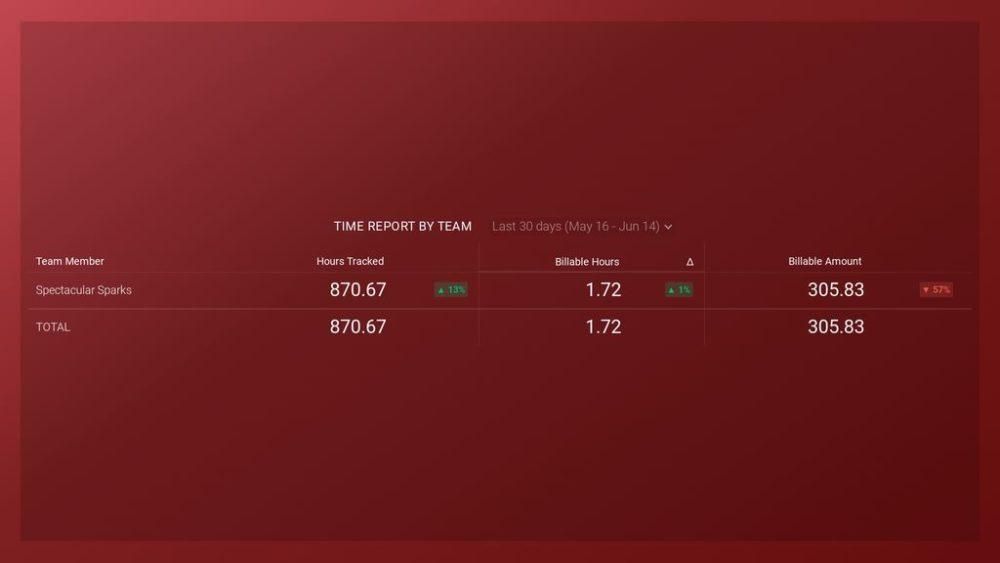
Are you creating a financial report? You will find this QuickBooks + HubSpot integration a great choice for a financial performance dashboard that makes creating a report simple. This dashboard focuses on the essential financial report
ting metrics and answers all your revenue-related questions. See all Databox financial dashboards here.
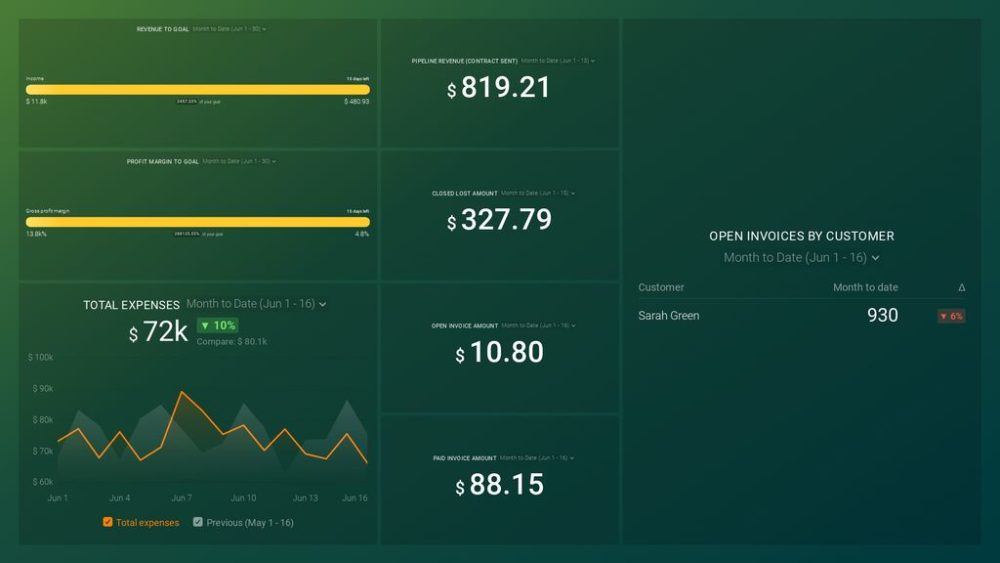
If you’re tracking your sales team’s monthly performance, this sales report template will help you prepare an outstanding report. Check out all the vital productivity KPIs, track your progress towards your goals, and understand well how your current sales pipeline is performing. See all sales performance dashboards we have available here.

Marketing reports can be easily prepared by using this monthly marketing report template . With HubSpot’s reporting, you can determine where your website traffic is coming from, how your landing pages and specific blog posts are performing, and how successful your email campaigns are. Browse all Databox marketing dashboards or marketing report examples here.

Create a Professional Business Report in No Time with Databox
Does creating a business report still sound like a daunting task? It doesn’t have to be with Databox.
In times when we’re all trying to save our time and energy for things that matter rather than scattering valuable resources on tedious, repetitive tasks, it’s critical to optimize your business process. And we want to help you do just that.
Using a business reporting dashboard enables you to track data from all the different tools you’re using – but in one place. With Databox, you can monitor and report on performance in a single dashboard that is optimized for all your favorite devices and you can create streamlined and beautiful dashboards even if you are not that tech-savvy. (no coding or design skills are required).
Automating business reporting has never been easier. And with Databox, you can do exactly that in just a few clicks. Sign up now and get your first 3 business dashboards for free.
Get practical strategies that drive consistent growth
12 Tips for Developing a Successful Data Analytics Strategy

What Is Data Reporting and How to Create Data Reports for Your Business
What is kpi reporting kpi report examples, tips, and best practices.
Build your first dashboard in 5 minutes or less
Latest from our blog
- Playmaker Spotlight: Tory Ferrall, Director of Revenue Operations March 27, 2024
- New in Databox: Safeguard Your Data With Advanced Security Settings March 18, 2024
- Metrics & KPIs
- vs. Tableau
- vs. Looker Studio
- vs. Klipfolio
- vs. Power BI
- vs. Whatagraph
- vs. AgencyAnalytics
- Product & Engineering
- Inside Databox
- Terms of Service
- Privacy Policy
- Talent Resources
- We're Hiring!
- Help Center
- API Documentation

What Is The Difference Between Written Report And Oral Report
It is common to come across both written and oral reports in the workplace. But what is the difference between the two? In this blog, we will explore the key distinctions between a written and an oral report, as well as the advantages and disadvantages of each.
In this blog, we will explore the key distinctions between a written and an oral report, as well as the advantages and disadvantages of each.
Definition of written reports

A written report is an organized and detailed document that provides information on a particular subject. It is typically used to present evidence or findings from research, experiments, or investigations.
Written reports often include facts, data, and analysis from the authors’ research, as well as recommendations for action or improvement. An oral report, on the other hand, is a presentation of information that is usually spoken and accompanied by visual aids such as slides or charts. Oral reports are generally shorter and less detailed than written reports, and they are usually presented in person or via video conference.
Both reports are important tools for presenting and communicating information, but the differences between them should be taken into account when deciding which to use.
Definition of oral reports

Oral reports are a type of presentation in which the presenter conveys information verbally to an audience. This differs from a written report, which is a document that is written down, containing the same information. The difference between an oral report and a written report is that an oral report is a live presentation, while a written report is a document that can be shared afterwards and used as a reference.
The difference between an oral report and a written report is that an oral report is a live presentation, while a written report is a document that can be shared afterwards and used as a reference. Oral reports often include visuals such as slides, graphs, and charts, while written reports typically only include text. Oral reports also give an audience the opportunity to ask questions, while written reports usually do not.
Advantages and disadvantages of written reports

Written reports and oral reports both have their advantages and disadvantages. Written reports are generally more detailed and organized than oral reports, making them ideal for communicating complex ideas and data.
On the other hand, oral reports can be more concise and engaging, allowing for a better understanding of the material presented. Furthermore, the immediacy of an oral report allows for the presenter to more effectively explain and clarify any questions from the audience.
In the end, it depends on the purpose of the report and the audience it is intended for. Written reports are better suited for communicating detailed information, while oral reports are better for summarizing and engaging an audience.
Advantages and disadvantages of oral reports

Oral reports and written reports are both useful forms of communication, but they each have their own advantages and disadvantages. Oral reports are a great way to get a message across quickly and with a personal touch, but they can be difficult to follow if the speaker is unprepared or the audience is not paying attention.
Ultimately, the choice of whether to use an oral or written report depends on the situation and the message that needs to be conveyed.
Comparison of written reports to oral reports

When it comes to delivering information, written and oral reports are two of the most commonly used forms of communication. While written reports provide a more in-depth and detailed view of a topic, oral presentations can be more efficient and direct.
Written reports often require more research and preparation, whereas oral reports may be more spontaneous and allow for more audience interaction. Written reports are typically more permanent, allowing readers to refer back to them at any time, while oral reports are often forgotten soon after they are delivered.
Ultimately, the choice of which type of report to use comes down to the purpose, urgency, and audience of the report.
Bottom Line
The main difference between written and oral reports is the way in which the information is presented. Written reports are typically written down in a document format, while oral reports are usually delivered through a spoken presentation. Written reports are usually more detailed and long-lasting, while oral reports are often short and meant to cover the most important points.
Both written and oral reports can be effective means of conveying information, depending on the situation and the needs of the audience.
Leave a Comment Cancel reply
Save my name, email, and website in this browser for the next time I comment.

- school Campus Bookshelves
- menu_book Bookshelves
- perm_media Learning Objects
- login Login
- how_to_reg Request Instructor Account
- hub Instructor Commons
- Download Page (PDF)
- Download Full Book (PDF)
- Periodic Table
- Physics Constants
- Scientific Calculator
- Reference & Cite
- Tools expand_more
- Readability
selected template will load here
This action is not available.

Chapter 1: Introduction to Technical and Report Writing
- Last updated
- Save as PDF
- Page ID 179209
Bay College
Learning Objectives
What is Technical Writing? [1]
You’re probably wondering what this “technical writing thing” is. Someone may even have told you, “It’s this course where they make you write about rocket science and brain surgery.” Well, not really, as you will see in a moment. Actually, the field of technical communication is essential in a wide range of fields and occupations. It is a fully professional field with degree programs, certifications, and—yes!—even theory. It’s a good field with a lot of growth and income potential; and an introductory technical-writing course for which this book has been developed is a good way to start if you are interested in a career in this field .
Technical writing is an audience-centered means of communication that provides a reader with clear and easy access to information. In the business world, time equates to profit, and profit is the force behind all business interaction. The technical writer and reader have a vis-à-vis relationship. The writer recognizes, respects, and addresses the importance of time in effective and efficient communication by providing documents written in specific formats, using unambiguous language to send clearly accessible information. The reader in turn thoroughly understands the information in order to give a thoughtful response.
The Meaning of “Technical”
Technical communication—or technical writing, as the course is often called—is not writing about a specific technical topic such as computers, but about any technical topic. The term “technical” refers to knowledge that is not widespread, that is more the territory of experts and specialists. Whatever your major is, you are developing an expertise—you are becoming a specialist in a particular technical area. And whenever you try to write or say anything about your field, you are engaged in technical communication .
Academic Writing Versus Technical Writing
The definite purpose, strict format and use of appropriate language in technical writing define the differences between technical writing and academic writing. The academic writer’s purpose may be to write an assignment, a story, a letter, etc.. These works may or may not have a reader. However, technical writing always has a definite purpose and will always have a reader. Regardless of the number of the intended readers of a document who may or may not read the document, the document will be read by the primary reader.
Workplace Writing
However, the focus for technical-writing courses is not necessarily a career as a technical writer but an introduction to the kinds of writing skills you need in practically any technically oriented professional job. No matter what sort of professional work you do, you’re likely to do lots of writing—and much of it technical in nature. The more you know about some basic technical-writing skills, which are covered in this guide and in technical-writing courses, the better job of writing you’re likely to do. And that will be good for the projects you work on, for the organizations you work in, and—most of all—good for you and your career .
Really Technical Writing
Keep relaxing, but you should know that professional technical writers do in fact write about very technical stuff—information that they cannot begin to master unless they go back for a Ph.D. But wait a minute! The technical documents have to ship with the product in less than nine months! How do they manage? Professional technical writers rely on these strategies to ensure the technical accuracy of their work:
- Study of books, articles, reports, websites related to the product
- Product specifications: what the product is supposed to do, how it is designed
- Interviews with subject matter experts: the product specialists, developers, engineers
- Product meetings during the development cycle
- Live demonstrations of the product
- Familiarization with similar, competing products
- Experimenting with working models of the product
- Most importantly, subject matter experts’ review of technical writers’ work for technical accuracy and completeness
Of course, experienced technical writers will tell you that product development moves so fast that specifications are not always possible and that working models of the product are rarely available. That’s why the subject matter experts’ review is often the most important.
Considerations of Technical Documents
There are key components of what makes a document strong. Therefore, writers keep these items in mind while constructing technical documents.
The Importance of Audience
Another key part of the definition of technical communication is the receiver of the information—the audience. Technical communication is the delivery of technical information to readers (or listeners or viewers) in a manner that is adapted to their needs, level of understanding, and background. In fact, this audience element is so important that it is one of the cornerstones of this course: you are challenged to write about highly technical subjects but in a way that a beginner—a nonspecialist—could understand. This ability to “translate” technical information to non-specialists is a key skill to any technical communicator. In a world of rapid technological development, people are constantly falling behind and becoming technological illiterates. Technology companies are constantly struggling to find effective ways to help customers or potential customers understand the advantages or the operation of their new products .
Not only is the the level at which you write important but so are the language choices you make as you do so. Please review the information on the following link for tips: Use Language that is Sensitive to Your Audience [2]
So relax! You don’t have to write about computers or rocket science—write about the area of technical specialization you know or are learning about. Also, plan to write about it in such a way that even Grandad can understand !
Formatting and Language
Formatting and appropriate language are the basic design elements of all technical documents. A format that shows a hierarchical structure and a coordinate structure of information le ads the reader thorough text.

Readers should be able to identify a writer’s organizational pattern very quickly when reading a technical document . This sometimes refers to a document being “reader friendly.” In addition , using appropriate language is significant in providing the reader with a thorough understanding of the purpose of the document, how the document relates to the reader’s needs, and what action is expected of the reader. [3]
A document may also have one reader (the primary reader) or several readers (the secondary readers). A primary reader is the person who ordered the report to be written or the person for whom a report is intended. These readers will usually read the entire report. Secondary readers are those readers who will read only the sections of the report that relate to them, their jobs, their departments, responsibilities, etc. For example, if a report was sent that detailed funding for different departments, a piping superintendent may only want to read the section that relates to piping. This is where format, the use of headings, is significant in allowing the reader easy access to information. When the piping superintendent can scan through the document and clearly find the heading that identifies his department saves time.
Cultural Communication
Technical writers need to be aware of the differences between the behavior and the norms, beliefs and values of specific cultural. According to Edward T. Hall and Mildred Reed Hall, In Understanding Cultural Differences, each culture operates according to its own rules (1990, pp. 3-4). Hall and Hall add that problems occur when members of one culture apply the rules to another culture (1990, pp. 3-4). To communicate effectively with other cultures, the technical writer needs to not only be aware of rules governing behaviors that can be observed but also of the not-so-obvious rules that govern the norms, beliefs, and values of the people of a culture. The invisible rules of a culture dramatically impact the acceptance of ideas, plans, and strategies. The Cultural Iceberg illustrates patterns of world communication, showing indicators of Institutional Culture (the obvious behavior of a culture), which can be clearly seen as the tip of the iceberg, and People Culture (the norms, beliefs and values of a culture), which cannot be seen and which are the barriers to successful communication .
Figure 2 The Cultural Iceberg
Technical writers have a responsibility to their readers and to their employers to follow ethics when writing reports.
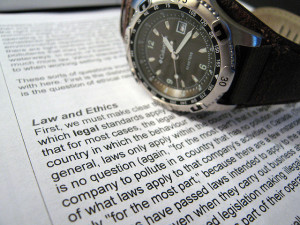
Technical writers must use words that demonstrate valid appeals to reason, avoiding emotional words and phrases that appea l to basic emotion instead of justifiable reasoning. In addition, technical writers must use valid references to support ideas and strategies, avoiding referencing non experts to sway readers’ support. Also, technical writers must use accurate numbers to report data, avoiding charts and tables that skew data. Using any type of fallacies in technical writing is unethical and could result in dire consequences.
Not only do technical writers have a responsibility to report accurate information, but they also have a responsibility to credit accurate sources of information. At no time is it acceptable to rearrange information in order to attempt to indicate that the writer is the source of someone else’s idea or to indicate that the writer read a report that included information he/she cited, when the primary source of the information was cited in another report. All sources must be referenced accurately in the text and cited on a reference page.
Daniel G. Riordan (2005), in Technical Report Writing Today, cites Dombrowski to define three threads of ethics:
One major thread is that the communicator must be a good person who cares for the audience. Communicators must tell the truth as convincingly as possible, because truth will lead to the good of the audience. Another thread is that the communicator must do what is right, regardless of possible outcomes. A third thread is that communicators must act for the greatest good for the greatest number of people (p. 16) .
In addition, Riordan (2005) references the “code of ethics of the Society for Technical Writers, and cites five of the code’s tenants:
My commitment to professional excellence and ethical behaviors means that I will …
- Use language and visuals with precision.
- Prefer simple direct expression of ideas.
- Satisfy the audience’s need for information, not my own need for self-expression.
- Hold myself responsible for how well my audience understands my message.
- Report the work of colleagues, knowing that a communication problem may have more than one solution (Riordan, 2005, pp. 15-16) .
Hall, E. T. & Hall, M. R. (1990). Understanding Cultural Differences. Yardmouth: Intercultural Press, Inc.
Riordan, D. G. (2005). Technical Report Writing Today. Boston: Houghton Mifflin Company.
Visuals & Readability
To make a document more reader friendly, many technical writers rely on visuals to achieve this goal. [5] For example , la bels, callouts and captions are identifying text for graphics . Labels and callouts identify specific elements or features on a graphic; whereas captions are short phrases or sentences that describe the graphic. Notes, or footnotes, explain, or give credit.
Labels and Callouts
To identify specific elements or features, labels and captions are placed directly on the graphic or near it. “Although the terms are used interchangeably, labels are text identifiers that are self-explanatory in an image, while callouts are labels that require further information outside the image to explain what they are identifying” (Gurak 304). They supplement the visual information. But use them selectively; use them only if readers need them (Rude 116).
The advantage of labels is that the reader gains a basic understanding of elements in the graphic without referring to supplementary explanations. But, too many labels obscure the image. In this case, callouts are the better option. Use numbers or letters to identify each element and the supplementary explanations.
Guidelines for Creating Labels and Callouts
- Determine the number of items to identify in the image (Gurak 308).
- Estimate how much explanation each item requires to determine if labels or callouts are more appropriate (Gurak 308).
- create a consistent visual style (Gurak 308)
- use the same terms on the label or callout as in the text (Rude 116)
- in general, all parts mentioned in the text should have a label or callout, and all parts with a label or callout should be mentioned in the text. (Rude 116)
- Use a standard font and size for readability (Rude 116)
- Align the labels and callouts for a neater appearance (Rude 116)
- If callouts are used, place the explanatory text in a key next to the graphic.
Labels can take different forms (Gurak 304 – 306):
- They may be placed directly on the graphic (whereby they become part of the graphic).
- They may be placed around the graphic and use lines to point to the relevant element in the graphic.
- Online, labels can be links or hotspots whereby more information about the element is displayed on mouse rollover.
This is an example of l abels placed directly on the graphic.
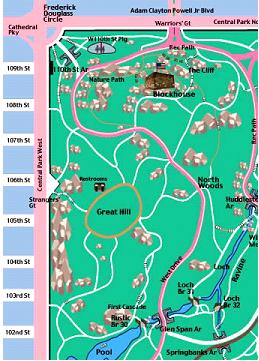
Figure 3 Map of the West Side Central Park, NYC between 102nd and 110th Streets.
Here, the labels are placed around the graphic.

Figure 4 Parts of a flower.
In this sample, when the mouse is rolled over the ‘Firebox’ label, the text will read: “Literally a box containing the fire. It is surrounded by water on the top and all sides. The bottom is a grate with an ash pan below that.” Additional information is displayed .
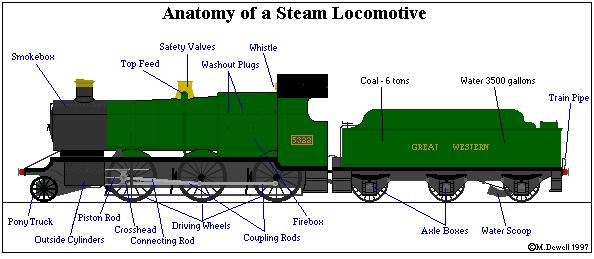
Figure 5 Labels as hotspots.
Callouts are best used when many parts of the image need to be labeled and each part requires a longer explanation. In fact, the label sequence may be in alphabetical or numerical (as in Figure 6) order. Ensure that the explanation is near the graphic.

Figure 6. How to understand and use the Nutrition Facts Label.
Coded callouts are in numerical sequence; the explanation for each number appears below the graphic. The example above shows part of the explanation of Number 1 explanation only.
Captions, table, and graphics titles must clearly identify information to the reader. Interpretive captions usually require one or more sentences. Captions should be informational, without becoming too lengthy. Captions that are merely a title for a graphic are not very helpful (Franklin 96).
Writing Style for Captions
- Captions for graphics include the title and any explanatory material, immediately under the graphic.
- Words such as Figure, Illustration, and Table should be in bold type.
- The caption should be italicized.
- Treat tables and figures the same.
Good captions are what guide readers not only to see, but also to understand. Captions label graphics with titles and explain to readers what they are seeing, and how to interpret the information captured in the visual. The Franklin Covey Style Guide for Business and Technical Communication provides an excellent source for writing captions (Franklin 39 – 41).
Five Specific Style Rules
- Use interpretive captions whenever possible. I nterpretive captions provide both a title and explanatory information, usually expressed in a complete sentence, to help readers understand the central point(s) that the writer wants to convey. A graphic and its caption should be clear and understandable without requiring readers to search for clarifying information in the text:
- Figure 4. Cabin-Temperature Control System. Constant cabin temperature control is maintained by the system’s modulated cabin sensor.
- This interpretive caption gives the title and then tells the reader the principle message – that the check valve provides near-zero risk. And, it states how the check valve provides near-zero risk (Franklin 39).
- Figure 23. Check Valve . The risk of bad air entering the changer is near zero because the check valve permits air flow in one direction only.
- This interpretive caption gives the title of the figure and emphasizes that the cabin has a constant temperature – a benefit provided by the feature described in the figure. The caption states clearly what the writer wants the reader to learn from the drawing (Franklin 39).
- Avoid using short, often ambiguous, titles to replace interpretive captions. In the past, styles for technical and scientific documents used only short, simple title captions for visuals. These were often superfluous, providing no real information other than the obvious to the reader, i.e. – A Horse. Titles that are so short and cryptic that they sound telegraphic are not useful. Such captions are only useful when the graphics are self-explanatory, and require no interpretation (Franklin 40).
- Number figures and tables sequentially throughout the document, and place the number before the caption. If an important figure or table is presented twice, treat it as two separate visuals and number each. Figure and table numbers should be whole numbers (Franklin 40).
- Captions may appear below or above a visual, but consistency throughout a document is critical. Arguments support both options; choose one, warrant your choice, and be consistent.
- Put the caption above the visual for better visibility when captions are used with slides and other project visual aids. Captions placed at the bottom may be blocked by the heads of those seated in front (Franklin 99).
Notes or footnotes are categorized as either explanatory or source notes. Explanatory footnotes are identified by a superscript number or letter. The order in which notes appear is important; explanatory footnotes are placed above source notes. And both are placed above the caption, if the caption is placed at the bottom of the illustration.
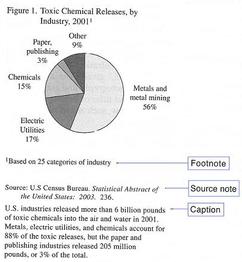
Figure 7. Placement of footnote, source note and caption.
Source: Rude, p. 115, modified.
The Writing Process [6]
Writing, especially when compiling a larger document, is not something you sit down, complete in one session, and quickly submit. This is especially true when writing for the workplace where accuracy and clarity are necessary. In fact, writing should be seen as a process that is recursive where the writer moves in and out of various stages of writing and often times revisits some of the stages. The writing process might consist of the following:
This is the planning done before writing a document. It may be defining the purpose of the task, analyzing the primary and secondary readers, sketching the document and what will go in each section, or gathering research.
This is writing and compiling a first draft of the document. Sometimes, the writer worries more about getting ideas down more than guaranteeing every punctuation or grammar choice is correct.
When a writer revises, a writer revisits the draft and makes substantial changes to it. This is more than editing. It is adding, deleting, and moving entire sections of the document around to prepare it as a final, comprehensive document. In fact, it is here that many writers ask others for feedback before revising to ensure that another, unbiased set of eyes have looked over the document and easily understand it.
This is the final part of the process. It is reading through the document several times while looking for clarity, consistency, and accuracy. In fact, consider reading your document aloud and listening to it as you do so instead of reading and “seeing” it. Most individuals communicate mostly through talking and listening. Therefore, when you read aloud, you can hear if something in your document doesn’t sound right and then correct it. You should be able to read it in a way that it is understandable and sounds conversational.
For additional information on the writing process, visit The Writing Center website for the University of Texas: University of Texas Writing Center & The Writing Process .
Using a process in the workplace and in our class will strengthen your documents significantly. In fact, remember that your documents reflect on who you are as student, technical writer, employee, and even researcher.
[1] Technical Writing. Authored by : Dr. Elizabeth Lohman. Provided by : Tidewater Community College. Located at : http://www.tcc.edu/ . Project : Z Degree Program. License : CC BY: Attribution , edited by Amber Kinonen , edits included in italics
[2] Use Language that is Sensitive to Your Audience. Provided by : Writing Commons. Located at : http://writingcommons.org/open-text/collaboration/143-common-comments/word-choice-/575-use-language-that-is-sensitive-to-your-audience . License : CC BY-NC-ND: Attribution-NonCommercial-NoDerivatives edited by Amber Kinonen , edits included in italics
[3] Image of Textbook. Authored by : Dominik Wagner. Located at : https://flic.kr/p/eoAvCb . License : CC BY: Attribution
[4] Image of Text with Watch. Authored by : Stephen Wu. Located at : https://flic.kr/p/tZ1LP . License : CC BY-NC-ND: Attribution-NonCommercial-NoDerivatives
[5] Norbert Elliot’s “Labels, Callouts, Captions and Notes” CC-BY Saylor, edited by Amber Kinonen , edits included in italics
[6] The Writing Process CC-BY Amber Kinonen

Chapter 1: Introduction to Technical and Report Writing by Bay College is licensed under a Creative Commons Attribution 4.0 International License , except where otherwise noted.
- Privacy Policy
Buy Me a Coffee

Home » Research Report – Example, Writing Guide and Types
Research Report – Example, Writing Guide and Types
Table of Contents

Research Report
Definition:
Research Report is a written document that presents the results of a research project or study, including the research question, methodology, results, and conclusions, in a clear and objective manner.
The purpose of a research report is to communicate the findings of the research to the intended audience, which could be other researchers, stakeholders, or the general public.
Components of Research Report
Components of Research Report are as follows:
Introduction
The introduction sets the stage for the research report and provides a brief overview of the research question or problem being investigated. It should include a clear statement of the purpose of the study and its significance or relevance to the field of research. It may also provide background information or a literature review to help contextualize the research.
Literature Review
The literature review provides a critical analysis and synthesis of the existing research and scholarship relevant to the research question or problem. It should identify the gaps, inconsistencies, and contradictions in the literature and show how the current study addresses these issues. The literature review also establishes the theoretical framework or conceptual model that guides the research.
Methodology
The methodology section describes the research design, methods, and procedures used to collect and analyze data. It should include information on the sample or participants, data collection instruments, data collection procedures, and data analysis techniques. The methodology should be clear and detailed enough to allow other researchers to replicate the study.
The results section presents the findings of the study in a clear and objective manner. It should provide a detailed description of the data and statistics used to answer the research question or test the hypothesis. Tables, graphs, and figures may be included to help visualize the data and illustrate the key findings.
The discussion section interprets the results of the study and explains their significance or relevance to the research question or problem. It should also compare the current findings with those of previous studies and identify the implications for future research or practice. The discussion should be based on the results presented in the previous section and should avoid speculation or unfounded conclusions.
The conclusion summarizes the key findings of the study and restates the main argument or thesis presented in the introduction. It should also provide a brief overview of the contributions of the study to the field of research and the implications for practice or policy.
The references section lists all the sources cited in the research report, following a specific citation style, such as APA or MLA.
The appendices section includes any additional material, such as data tables, figures, or instruments used in the study, that could not be included in the main text due to space limitations.
Types of Research Report
Types of Research Report are as follows:
Thesis is a type of research report. A thesis is a long-form research document that presents the findings and conclusions of an original research study conducted by a student as part of a graduate or postgraduate program. It is typically written by a student pursuing a higher degree, such as a Master’s or Doctoral degree, although it can also be written by researchers or scholars in other fields.
Research Paper
Research paper is a type of research report. A research paper is a document that presents the results of a research study or investigation. Research papers can be written in a variety of fields, including science, social science, humanities, and business. They typically follow a standard format that includes an introduction, literature review, methodology, results, discussion, and conclusion sections.
Technical Report
A technical report is a detailed report that provides information about a specific technical or scientific problem or project. Technical reports are often used in engineering, science, and other technical fields to document research and development work.
Progress Report
A progress report provides an update on the progress of a research project or program over a specific period of time. Progress reports are typically used to communicate the status of a project to stakeholders, funders, or project managers.
Feasibility Report
A feasibility report assesses the feasibility of a proposed project or plan, providing an analysis of the potential risks, benefits, and costs associated with the project. Feasibility reports are often used in business, engineering, and other fields to determine the viability of a project before it is undertaken.
Field Report
A field report documents observations and findings from fieldwork, which is research conducted in the natural environment or setting. Field reports are often used in anthropology, ecology, and other social and natural sciences.
Experimental Report
An experimental report documents the results of a scientific experiment, including the hypothesis, methods, results, and conclusions. Experimental reports are often used in biology, chemistry, and other sciences to communicate the results of laboratory experiments.
Case Study Report
A case study report provides an in-depth analysis of a specific case or situation, often used in psychology, social work, and other fields to document and understand complex cases or phenomena.
Literature Review Report
A literature review report synthesizes and summarizes existing research on a specific topic, providing an overview of the current state of knowledge on the subject. Literature review reports are often used in social sciences, education, and other fields to identify gaps in the literature and guide future research.
Research Report Example
Following is a Research Report Example sample for Students:
Title: The Impact of Social Media on Academic Performance among High School Students
This study aims to investigate the relationship between social media use and academic performance among high school students. The study utilized a quantitative research design, which involved a survey questionnaire administered to a sample of 200 high school students. The findings indicate that there is a negative correlation between social media use and academic performance, suggesting that excessive social media use can lead to poor academic performance among high school students. The results of this study have important implications for educators, parents, and policymakers, as they highlight the need for strategies that can help students balance their social media use and academic responsibilities.
Introduction:
Social media has become an integral part of the lives of high school students. With the widespread use of social media platforms such as Facebook, Twitter, Instagram, and Snapchat, students can connect with friends, share photos and videos, and engage in discussions on a range of topics. While social media offers many benefits, concerns have been raised about its impact on academic performance. Many studies have found a negative correlation between social media use and academic performance among high school students (Kirschner & Karpinski, 2010; Paul, Baker, & Cochran, 2012).
Given the growing importance of social media in the lives of high school students, it is important to investigate its impact on academic performance. This study aims to address this gap by examining the relationship between social media use and academic performance among high school students.
Methodology:
The study utilized a quantitative research design, which involved a survey questionnaire administered to a sample of 200 high school students. The questionnaire was developed based on previous studies and was designed to measure the frequency and duration of social media use, as well as academic performance.
The participants were selected using a convenience sampling technique, and the survey questionnaire was distributed in the classroom during regular school hours. The data collected were analyzed using descriptive statistics and correlation analysis.
The findings indicate that the majority of high school students use social media platforms on a daily basis, with Facebook being the most popular platform. The results also show a negative correlation between social media use and academic performance, suggesting that excessive social media use can lead to poor academic performance among high school students.
Discussion:
The results of this study have important implications for educators, parents, and policymakers. The negative correlation between social media use and academic performance suggests that strategies should be put in place to help students balance their social media use and academic responsibilities. For example, educators could incorporate social media into their teaching strategies to engage students and enhance learning. Parents could limit their children’s social media use and encourage them to prioritize their academic responsibilities. Policymakers could develop guidelines and policies to regulate social media use among high school students.
Conclusion:
In conclusion, this study provides evidence of the negative impact of social media on academic performance among high school students. The findings highlight the need for strategies that can help students balance their social media use and academic responsibilities. Further research is needed to explore the specific mechanisms by which social media use affects academic performance and to develop effective strategies for addressing this issue.
Limitations:
One limitation of this study is the use of convenience sampling, which limits the generalizability of the findings to other populations. Future studies should use random sampling techniques to increase the representativeness of the sample. Another limitation is the use of self-reported measures, which may be subject to social desirability bias. Future studies could use objective measures of social media use and academic performance, such as tracking software and school records.
Implications:
The findings of this study have important implications for educators, parents, and policymakers. Educators could incorporate social media into their teaching strategies to engage students and enhance learning. For example, teachers could use social media platforms to share relevant educational resources and facilitate online discussions. Parents could limit their children’s social media use and encourage them to prioritize their academic responsibilities. They could also engage in open communication with their children to understand their social media use and its impact on their academic performance. Policymakers could develop guidelines and policies to regulate social media use among high school students. For example, schools could implement social media policies that restrict access during class time and encourage responsible use.
References:
- Kirschner, P. A., & Karpinski, A. C. (2010). Facebook® and academic performance. Computers in Human Behavior, 26(6), 1237-1245.
- Paul, J. A., Baker, H. M., & Cochran, J. D. (2012). Effect of online social networking on student academic performance. Journal of the Research Center for Educational Technology, 8(1), 1-19.
- Pantic, I. (2014). Online social networking and mental health. Cyberpsychology, Behavior, and Social Networking, 17(10), 652-657.
- Rosen, L. D., Carrier, L. M., & Cheever, N. A. (2013). Facebook and texting made me do it: Media-induced task-switching while studying. Computers in Human Behavior, 29(3), 948-958.
Note*: Above mention, Example is just a sample for the students’ guide. Do not directly copy and paste as your College or University assignment. Kindly do some research and Write your own.
Applications of Research Report
Research reports have many applications, including:
- Communicating research findings: The primary application of a research report is to communicate the results of a study to other researchers, stakeholders, or the general public. The report serves as a way to share new knowledge, insights, and discoveries with others in the field.
- Informing policy and practice : Research reports can inform policy and practice by providing evidence-based recommendations for decision-makers. For example, a research report on the effectiveness of a new drug could inform regulatory agencies in their decision-making process.
- Supporting further research: Research reports can provide a foundation for further research in a particular area. Other researchers may use the findings and methodology of a report to develop new research questions or to build on existing research.
- Evaluating programs and interventions : Research reports can be used to evaluate the effectiveness of programs and interventions in achieving their intended outcomes. For example, a research report on a new educational program could provide evidence of its impact on student performance.
- Demonstrating impact : Research reports can be used to demonstrate the impact of research funding or to evaluate the success of research projects. By presenting the findings and outcomes of a study, research reports can show the value of research to funders and stakeholders.
- Enhancing professional development : Research reports can be used to enhance professional development by providing a source of information and learning for researchers and practitioners in a particular field. For example, a research report on a new teaching methodology could provide insights and ideas for educators to incorporate into their own practice.
How to write Research Report
Here are some steps you can follow to write a research report:
- Identify the research question: The first step in writing a research report is to identify your research question. This will help you focus your research and organize your findings.
- Conduct research : Once you have identified your research question, you will need to conduct research to gather relevant data and information. This can involve conducting experiments, reviewing literature, or analyzing data.
- Organize your findings: Once you have gathered all of your data, you will need to organize your findings in a way that is clear and understandable. This can involve creating tables, graphs, or charts to illustrate your results.
- Write the report: Once you have organized your findings, you can begin writing the report. Start with an introduction that provides background information and explains the purpose of your research. Next, provide a detailed description of your research methods and findings. Finally, summarize your results and draw conclusions based on your findings.
- Proofread and edit: After you have written your report, be sure to proofread and edit it carefully. Check for grammar and spelling errors, and make sure that your report is well-organized and easy to read.
- Include a reference list: Be sure to include a list of references that you used in your research. This will give credit to your sources and allow readers to further explore the topic if they choose.
- Format your report: Finally, format your report according to the guidelines provided by your instructor or organization. This may include formatting requirements for headings, margins, fonts, and spacing.
Purpose of Research Report
The purpose of a research report is to communicate the results of a research study to a specific audience, such as peers in the same field, stakeholders, or the general public. The report provides a detailed description of the research methods, findings, and conclusions.
Some common purposes of a research report include:
- Sharing knowledge: A research report allows researchers to share their findings and knowledge with others in their field. This helps to advance the field and improve the understanding of a particular topic.
- Identifying trends: A research report can identify trends and patterns in data, which can help guide future research and inform decision-making.
- Addressing problems: A research report can provide insights into problems or issues and suggest solutions or recommendations for addressing them.
- Evaluating programs or interventions : A research report can evaluate the effectiveness of programs or interventions, which can inform decision-making about whether to continue, modify, or discontinue them.
- Meeting regulatory requirements: In some fields, research reports are required to meet regulatory requirements, such as in the case of drug trials or environmental impact studies.
When to Write Research Report
A research report should be written after completing the research study. This includes collecting data, analyzing the results, and drawing conclusions based on the findings. Once the research is complete, the report should be written in a timely manner while the information is still fresh in the researcher’s mind.
In academic settings, research reports are often required as part of coursework or as part of a thesis or dissertation. In this case, the report should be written according to the guidelines provided by the instructor or institution.
In other settings, such as in industry or government, research reports may be required to inform decision-making or to comply with regulatory requirements. In these cases, the report should be written as soon as possible after the research is completed in order to inform decision-making in a timely manner.
Overall, the timing of when to write a research report depends on the purpose of the research, the expectations of the audience, and any regulatory requirements that need to be met. However, it is important to complete the report in a timely manner while the information is still fresh in the researcher’s mind.
Characteristics of Research Report
There are several characteristics of a research report that distinguish it from other types of writing. These characteristics include:
- Objective: A research report should be written in an objective and unbiased manner. It should present the facts and findings of the research study without any personal opinions or biases.
- Systematic: A research report should be written in a systematic manner. It should follow a clear and logical structure, and the information should be presented in a way that is easy to understand and follow.
- Detailed: A research report should be detailed and comprehensive. It should provide a thorough description of the research methods, results, and conclusions.
- Accurate : A research report should be accurate and based on sound research methods. The findings and conclusions should be supported by data and evidence.
- Organized: A research report should be well-organized. It should include headings and subheadings to help the reader navigate the report and understand the main points.
- Clear and concise: A research report should be written in clear and concise language. The information should be presented in a way that is easy to understand, and unnecessary jargon should be avoided.
- Citations and references: A research report should include citations and references to support the findings and conclusions. This helps to give credit to other researchers and to provide readers with the opportunity to further explore the topic.
Advantages of Research Report
Research reports have several advantages, including:
- Communicating research findings: Research reports allow researchers to communicate their findings to a wider audience, including other researchers, stakeholders, and the general public. This helps to disseminate knowledge and advance the understanding of a particular topic.
- Providing evidence for decision-making : Research reports can provide evidence to inform decision-making, such as in the case of policy-making, program planning, or product development. The findings and conclusions can help guide decisions and improve outcomes.
- Supporting further research: Research reports can provide a foundation for further research on a particular topic. Other researchers can build on the findings and conclusions of the report, which can lead to further discoveries and advancements in the field.
- Demonstrating expertise: Research reports can demonstrate the expertise of the researchers and their ability to conduct rigorous and high-quality research. This can be important for securing funding, promotions, and other professional opportunities.
- Meeting regulatory requirements: In some fields, research reports are required to meet regulatory requirements, such as in the case of drug trials or environmental impact studies. Producing a high-quality research report can help ensure compliance with these requirements.
Limitations of Research Report
Despite their advantages, research reports also have some limitations, including:
- Time-consuming: Conducting research and writing a report can be a time-consuming process, particularly for large-scale studies. This can limit the frequency and speed of producing research reports.
- Expensive: Conducting research and producing a report can be expensive, particularly for studies that require specialized equipment, personnel, or data. This can limit the scope and feasibility of some research studies.
- Limited generalizability: Research studies often focus on a specific population or context, which can limit the generalizability of the findings to other populations or contexts.
- Potential bias : Researchers may have biases or conflicts of interest that can influence the findings and conclusions of the research study. Additionally, participants may also have biases or may not be representative of the larger population, which can limit the validity and reliability of the findings.
- Accessibility: Research reports may be written in technical or academic language, which can limit their accessibility to a wider audience. Additionally, some research may be behind paywalls or require specialized access, which can limit the ability of others to read and use the findings.
About the author
Muhammad Hassan
Researcher, Academic Writer, Web developer
You may also like

Data Collection – Methods Types and Examples

Delimitations in Research – Types, Examples and...

Research Process – Steps, Examples and Tips

Research Design – Types, Methods and Examples

Institutional Review Board – Application Sample...

Evaluating Research – Process, Examples and...

COMMENTS
Ans: The act of presenting information in an orderly and structured format is known as report writing. Reports come in different types, such as analytical reports, research reports, financial reports, progress reports, incident reports, feasibility reports, and recommendation reports.
Report Writing is the process of presenting information in a structured and organised way. It serves as a means of communicating facts, findings, or recommendations to a specific audience, typically in a written format. This type of writing is used in various fields, including academics, business, science, and government, to convey important ...
Report Writing Definition. Report writing is the process of organizing and presenting information in a clear, concise, and objective manner for a specific audience. It involves gathering data, analyzing it, and presenting it in a format that is easy to understand and relevant to the topic at hand. - The University of Wisconsin Writing Center.
10. Vertical & Lateral Reports. Next, in our rundown of types of reports, we have vertical and lateral reports. This reporting type refers to the direction in which a report travels. A vertical report is meant to go upward or downward the hierarchy, for example, a management report.
A report is a specific form of writing that is organised around concisely identifying and examining issues, events, or findings that have happened in a physical sense, such as events that have occurred within an organisation, or findings from a research investigation. These events can also pertain to events or issues identified within a body of ...
1. Understand Your Purpose: Always start with a clear understanding of your report's objective. This clarity guides your research, the writing process, and the way you present your findings. 2. Emphasize Clarity and Precision: Your report should be written in clear, simple language.
Here are some steps you can take to learn how to write a report: 1. Determine the terms of reference. Determining the terms of reference for your report allows you to decide to share its purpose with the readers. Typically, you'd want to establish what the report is about, what you're trying to accomplish with it and why it's necessary for your ...
Defining a Report. A report is a type of writing that represents information, data, and research findings on a specific topic. The writer is expected to deliver a well-structured, credible, and informative text that dives into the small details of a certain topic, discussing its benefits and challenges.
Report writing is common in a number of disciplines. A report is a specific form of writing, written concisely and clearly and typically organised around identifying and examining issues, events, or findings from a research investigation.Reports often involve investigating and analysing a problem and coming up with a solution. This means that you need to take a position or provide a solution ...
Research reports are recorded data prepared by researchers or statisticians after analyzing the information gathered by conducting organized research, typically in the form of surveys or qualitative methods. A research report is a reliable source to recount details about a conducted research. It is most often considered to be a true testimony ...
In "Contemporary Business Reports," Kuiper and Clippinger define business reports as "organized, objective presentations of observations, experiences, or facts used in the decision-making process." Sharma and Mohan, in their book "Business Correspondence and Report Writing," define a technical report as "a written statement of the facts of a ...
According to the commonly known definition of report writing, a report is a formal document that elaborates on a topic using facts, charts, and graphs to support its arguments and findings. Any report—whether it's about a business event or one that describes the processes of various departments in a company—is meant for a particular type ...
A research report is a well-crafted document that outlines the processes, data, and findings of a systematic investigation. It is an important document that serves as a first-hand account of the research process, and it is typically considered an objective and accurate source of information.
Report. A report is a document or a statement that presents information in an organized format for a specific audience and purpose. Although summaries of reports may be delivered orally, complete reports are usually given in the form of written documents. [1] [2] Typically reports relay information that was found or observed. [2]
Step 5: Write the Introduction. A good introductory paragraph for a business report should explain to the reader why you've written the report. Use the introduction to provide a bit of background on the report's topic and mention the past results if there's been a significant improvement since your last report.
written report: 1 n a written document describing the findings of some individual or group Synonyms: report , study Types: show 8 types... hide 8 types... assay a written report of the results of an analysis of the composition of some substance case study a careful study of some social unit (as a corporation or division within a corporation) ...
Writing reports is a skill that employees require in many jobs. The type of report you may have to write could include a sales report, financial report, research report or project report. The structure and layout of these reports vary according to their purpose, but there are some basic rules you can follow to create a solid report.
Bottom Line. The main difference between written and oral reports is the way in which the information is presented. Written reports are typically written down in a document format, while oral reports are usually delivered through a spoken presentation. Written reports are usually more detailed and long-lasting, while oral reports are often ...
field. Technical writing is an audience-centered means of communication that provides a reader with clear and easy access to information. In the business world, time equates to profit, and profit is the force behind all business interaction. The technical writer and reader have a vis-à-vis relationship.
Definition: Research Report is a written document that presents the results of a research project or study, including the research question, methodology, results, and conclusions, in a clear and objective manner. ... Write the report: Once you have organized your findings, you can begin writing the report. Start with an introduction that ...
A report is a concise piece of writing that uses facts and evidence to look at issues, situations, events, or findings. Reports are informative texts that aim to analyze different topics with a specific purpose and audience in mind. They provide factual information to their reader. Reports are a form of non-fiction and aim to be as objective as ...
Noun. 1. written report - a written document describing the findings of some individual or group; "this accords with the recent study by Hill and Dale". report, study. document, papers, written document - writing that provides information (especially information of an official nature) assay - a written report of the results of an analysis of ...
The Los Angeles Times have edited a previously published commentary piece written about the LSU women's basketball team following criticisms of the article by the team's head coach, who ...